
Intel
Æ
Celeron
Æ
Processor for the PGA370
Socket up to 1.40 GHz on 0.13 Micron
Process
Datasheet
Product Features
The Intel
Æ
Celeron
Æ
processor is designed for uni-processor based Value PC desktops and is binary
compatible with previous generation Intel architecture processors. The Intel Celeron
processor provides
good performance for applications running on advanced operating systems such as Windows* 95/98,
WindowsNT*, Windows* 2000, WindowsXP* and UNIX*. This is achieved by integrating the best
attributes of Intel processors--the dynamic execution performance of the P6 microarchitecture plus the
capabilities of MMXTM technology--bringing a balanced level of performance to the Value PC market
segment. The Intel Celeron processor offers the dependability you would expect from Intel at an
exceptional value. Systems based on Intel Celeron processors also include the latest features to simplify
system management and lower the cost of ownership for small business and home environments.
s
Available at 1.4 GHz, 1.30 GHz, 1.20 GHz,
1.10A GHz, 1A GHz and 900 MHz with
100 MHz system bus
s
256 KB on-die Level 2 (L2) cache with Error
Correcting Code (ECC))
s
Dual Independent Bus (DIB) architecture:
Separate dedicated external System Bus and
dedicated internal high-speed cache bus
s
Internet Streaming SIMD Extensions for
enhanced video, sound and 3D performance
s
Binary compatible with applications running
on previous members of the Intel
microprocessor line
s
Dynamic execution micro architecture
s
Power Management capabilities
--System Management mode
--Multiple low-power states
s
Optimized for 32-bit applications running on
advanced 32-bit operating systems
s
Flip Chip Pin Grid Array (FC-PGA2) packaging
technology
s
Integrated high performance 16 KB instruction
and 16 KB data, nonblocking, level one cache
s
Integrated Full Speed level two cache allows for
low latency on read/store operations
s
Error-correcting code for System Bus data
May 2002
Order Number:
298596-004

Datasheet
Information in this document is provided in connection with Intel products. No license, express or implied, by estoppel or otherwise, to any intellectual
property rights is granted by this document. Except as provided in Intel's Terms and Conditions of Sale for such products, Intel assumes no liability
whatsoever, and Intel disclaims any express or implied warranty, relating to sale and/or use of Intel products including liability or warranties relating to
fitness for a particular purpose, merchantability, or infringement of any patent, copyright or other intellectual property right. Intel products are not
intended for use in medical, life saving, or life sustaining applications.
Intel may make changes to specifications and product descriptions at any time, without notice.
Designers must not rely on the absence or characteristics of any features or instructions marked "reserved" or "undefined." Intel reserves these for
future definition and shall have no responsibility whatsoever for conflicts or incompatibilities arising from future changes to them.
The Intel
Æ
Celeron
Æ
processor may contain design defects or errors known as errata which may cause the product to deviate from published
specifications. Current characterized errata are available on request.
Contact your local Intel sales office or your distributor to obtain the latest specifications and before placing your product order.
Copies of documents which have an ordering number and are referenced in this document, or other Intel literature may be obtained by calling 1-800-
548-4725 or by visiting Intel's website at http://www.intel.com.
Copyright © Intel Corporation, 2002
Intel, Celeron, MMX, Pentium, and the Intel logo are trademarks or registered trademarks of Intel Corporation or its subsidiaries in the United States
and other countries.
*Other names and brands may be claimed as the property of others.

Datasheet
3
Intel
Æ
Celeron
Æ
Processor for PGA370 up to 1.40 GHz on 0.13
µ
Process
Contents
1.0
Introduction.........................................................................................................................9
1.1
Terminology.........................................................................................................10
1.1.1
Package and Processor Terminology ....................................................10
1.1.2
Processor Naming Convention...............................................................11
1.2
Related Documents.............................................................................................12
2.0
Electrical Specifications....................................................................................................13
2.1
Processor System Bus and V
REF .......................................................................................... 13
2.2
Clock Control and Low Power States..................................................................14
2.2.1
Normal State--State 1 ...........................................................................15
2.2.2
AutoHALT Powerdown State--State 2...................................................15
2.2.3
Stop-Grant State--State 3 .....................................................................15
2.2.4
HALT/Grant Snoop State--State 4 ........................................................15
2.2.5
Sleep State--State 5..............................................................................16
2.2.6
Deep Sleep State--State 6 ....................................................................16
2.2.7
Clock Control..........................................................................................17
2.3
Power and Ground Pins ......................................................................................17
2.3.1
Phase Lock Loop (PLL) Power...............................................................17
2.4
Decoupling Guidelines ........................................................................................18
2.4.1
Processor VCC
CORE
Decoupling............................................................18
2.5
Processor System Bus Clock and Processor Clocking .......................................19
2.6
Voltage Identification ...........................................................................................19
2.7
Processor System Bus Unused Pins...................................................................21
2.8
Processor System Bus Signal Groups ................................................................22
2.8.1
Asynchronous vs. Synchronous for System Bus Signals.......................23
2.8.2
System Bus Frequency Select Signals ..................................................24
2.9
Test Access Port (TAP) Connection....................................................................25
2.10
Maximum Ratings................................................................................................25
2.11
Processor Voltage Level Specifications ..............................................................25
2.12
AGTL System Bus Specifications........................................................................30
2.13
System Bus Timing Specifications ......................................................................31
3.0
Signal Quality Specifications ............................................................................................41
3.1
BCLK/BCLK# & PICCLK Signal Quality Specifications and
Measurement Guidelines ....................................................................................41
3.2
AGTL Signal Quality Specifications and Measurement Guidelines.....................42
3.2.1
Overshoot/Undershoot Guidelines .........................................................43
3.2.2
Overshoot/Undershoot Magnitude .........................................................44
3.2.3
Overshoot/Undershoot Pulse Duration...................................................44
3.2.4
Activity Factor.........................................................................................44
3.2.5
Reading Overshoot/Undershoot Specification Tables............................45
3.2.6
Determining if a System Meets the Overshoot/Undershoot
Specifications .........................................................................................46
3.3
Non-AGTL Signal Quality Specifications and Measurement Guidelines.............47
3.3.1
Overshoot/Undershoot Guidelines .........................................................48
3.3.2
Ringback Specification ...........................................................................48
3.3.3
Settling Limit Guideline...........................................................................49

Intel
Æ
Celeron
Æ
Processor for PGA370 up to 1.40 GHz on 0.13
µ
Process
4
Datasheet
3.4
VTT_PWRGD Signal Quality Specification ......................................................... 49
3.4.1
Transition region .................................................................................... 49
3.4.2
Transition time........................................................................................ 50
3.4.3
Noise ...................................................................................................... 50
4.0
Thermal Specifications and Design Considerations......................................................... 51
4.1
Thermal Specifications........................................................................................ 51
4.1.1
THERMTRIP# Requirement................................................................... 51
4.1.2
Thermal Diode........................................................................................ 52
4.2
Thermal Metrology .............................................................................................. 52
5.0
Mechanical Specifications................................................................................................ 53
5.1
FC-PGA2 Mechanical Specifications .................................................................. 53
5.2
Recommended Mechanical Keep-Out Zones ..................................................... 55
5.3
Processor Markings ............................................................................................ 56
5.4
Processor Signal Listing...................................................................................... 57
6.0
Boxed Processor Specifications....................................................................................... 68
6.1
Mechanical Specifications................................................................................... 68
6.1.1
Mechanical Specifications for the FC-PGA2 Package ........................... 68
6.1.2
Boxed Processor Heatsink Weight......................................................... 70
6.2
Thermal Specifications........................................................................................ 70
6.2.1
Boxed Processor Cooling Requirements ............................................... 70
6.2.2
Boxed Processor Thermal Cooling Solution Clip ................................... 71
6.3
Electrical Requirements for the Boxed Processor............................................... 71
6.3.1
Electrical Requirements ......................................................................... 71
7.0
Processor Signal Description ........................................................................................... 73
7.1
Alphabetical Signals Reference .......................................................................... 73
7.2
Signal Summaries ............................................................................................... 80

Datasheet
5
Intel
Æ
Celeron
Æ
Processor for PGA370 up to 1.40 GHz on 0.13
µ
Process
List of Figures
1
Integrated Heat Spreader (IHS) ............................................................................9
2
AGTL Bus Topology in a Uniprocessor Configuration.........................................14
3
Stop Clock State Machine ...................................................................................14
4
PLL Filter Specification........................................................................................18
5
Differential/Single-Ended Clocking Example.......................................................19
6
V
TT
Power Good and Bus Select Interconnect Diagram.....................................21
7
BSEL[1:0] Example for a System Design............................................................24
8
Vcc Static and Transient Tolerance ....................................................................28
9
Clock Waveform ..................................................................................................36
10
BCLK/BCLK#, PICCLK, and TCK Generic Clock Waveform ..............................37
11
System Bus Valid Delay Timings ........................................................................37
12
System Bus Setup and Hold Timings..................................................................38
13
System Bus Reset and Configuration Timings....................................................38
14
Platform Power-On Sequence and Timings ........................................................39
15
Power-On Reset and Configuration Timings.......................................................39
16
Test Timings (TAP Connection) ..........................................................................40
17
Test Reset Timings .............................................................................................40
18
BCLK/BCLK#, PICCLK Generic Clock Waveform at the Processor Pins ...........42
19
Low to High AGTL Receiver Ringback Tolerance...............................................43
20
Maximum Acceptable AGTL Overshoot/Undershoot Waveform .........................47
21
Non-AGTL Overshoot/Undershoot, Settling Limit, and Ringback ......................47
22
Noise Estimation .................................................................................................50
23
Package Dimensions...........................................................................................53
24
Volumetric Keep-Out ...........................................................................................55
25
Component Keep-Out .........................................................................................55
26
Top Side Processor Markings .............................................................................56
27
Processor Pinout ................................................................................................57
28
Conceptual Boxed Processor for the PGA370 Socket ........................................68
29
Comparison between FC-PGA and FC-PGA2 package......................................69
30
Side View of Space Requirements for the Boxed Processor ..............................69
31
Dimensions of Mechanical Step Feature in Heatsink Base.................................70
32
Thermal Airspace Requirement for all Boxed Processor Fan
Heatsinks in the PGA370 Socket ........................................................................71
33
Boxed Processor Fan Heatsink Power Cable Connector Description.................72
34
Motherboard Power Header Placement Relative to the Boxed Processor..........72

Intel
Æ
Celeron
Æ
Processor for PGA370 up to 1.40 GHz on 0.13
µ
Process
6
Datasheet
List of Tables
1
Processor Identification....................................................................................... 11
2
System Bus Clock in Deep Sleep Mode (Differential Mode only) ....................... 16
3
Voltage Identification Definition .......................................................................... 20
4
System Bus Signal Groups ................................................................................ 23
5
Frequency Select Truth Table for BSEL[1:0] ...................................................... 24
6
Absolute Maximum Ratings ................................................................................ 25
7
Voltage and Current Specifications..................................................................... 26
8
Power Supply Current Slew Rate (dIcccore/dt)................................................... 27
9
Vcc Static & Transient Tolerance........................................................................ 28
10
AGTL Signal Group Levels Specifications .......................................................... 29
11
Non-AGTL Signal Group Levels Specifications .................................................. 29
12
3.3 Volt CMOS Output Signal Group DC Specifications ..................................... 30
13
Processor AGTL Bus Specifications ................................................................... 30
14
System Bus Timing Specifications (Single-Ended Clock) ................................... 31
15
System Bus Timing Specifications (Differential Clock) ....................................... 32
16
Valid System Bus to Core Frequency Ratios ..................................................... 33
17
System Bus Timing Specifications (AGTL Signal Group) ................................... 33
18
System Bus Timing Specifications (CMOS Signal Group).................................. 33
19
System Bus Timing Specifications (Reset Conditions) ...................................... 34
20
System Bus Timing Specifications (APIC Clock and APIC I/O) .......................... 34
21
System Bus Timing Specifications (TAP Connection) ........................................ 35
22
Platform Power-On Timings ................................................................................ 36
23
BCLK (Single-Ended Clock Mode) Signal Quality Specifications for
Simulation at the Processor Pins ........................................................................ 41
24
BCLK/BCLK# (Differential Clock Mode) and PICCLK Signal Quality
Specifications for Simulation at the Processor Pins............................................ 41
25
AGTL Signal Groups Ringback Tolerance Specifications at the
Processor Pins .................................................................................................... 42
26
Example Platform Information............................................................................. 45
27
100 MHz AGTL Signal Group Overshoot/Undershoot Tolerance ...................... 46
28
33 MHz CMOS Signal Group Overshoot/Undershoot Tolerance........................ 48
29
Signal Ringback Specifications for Non-AGTL Signal Simulation at the
Processor Pins .................................................................................................... 49
30
Processor Thermal Design Power ..................................................................... 51
31
THERMTRIP# Time Requirement....................................................................... 51
32
Thermal Diode Parameters ................................................................................. 52
33
Thermal Diode Interface...................................................................................... 52
34
The Processor Package Dimensions .................................................................. 54
35
Processor Case Loading Parameters ................................................................. 54
36
Signal Listing in Order by Signal Name .............................................................. 58
37
Signal Listing in Order by Pin Number ................................................................ 63
38
Boxed Processor Fan Heatsink Spatial Dimensions........................................... 70
39
Fan Heatsink Power and Signal Specifications................................................... 72
40
Signal Description ............................................................................................... 73
41
Output Signals..................................................................................................... 80
42
Input Signals ....................................................................................................... 80
43
Input/Output Signals (Single Driver).................................................................... 81
44
Input/Output Signals (Multiple Driver) ................................................................. 82

Datasheet
7
Intel
Æ
Celeron
Æ
Processor for PGA370 up to 1.40 GHz on 0.13
µ
Process
Revision History
Revision
Date
Description
-004
May 2002
∑ Added 1.4 GHz processor information; Added Section 3.4, "VTT_PWRGD
Signal Quality Specification"; Updated Table 40, "Signal Description" for
V
CMOS_REF
.

Intel
Æ
Celeron
Æ
Processor for PGA370 up to 1.40 GHz on 0.13
µ
Process
8
Datasheet
This page is intentionally left blank.
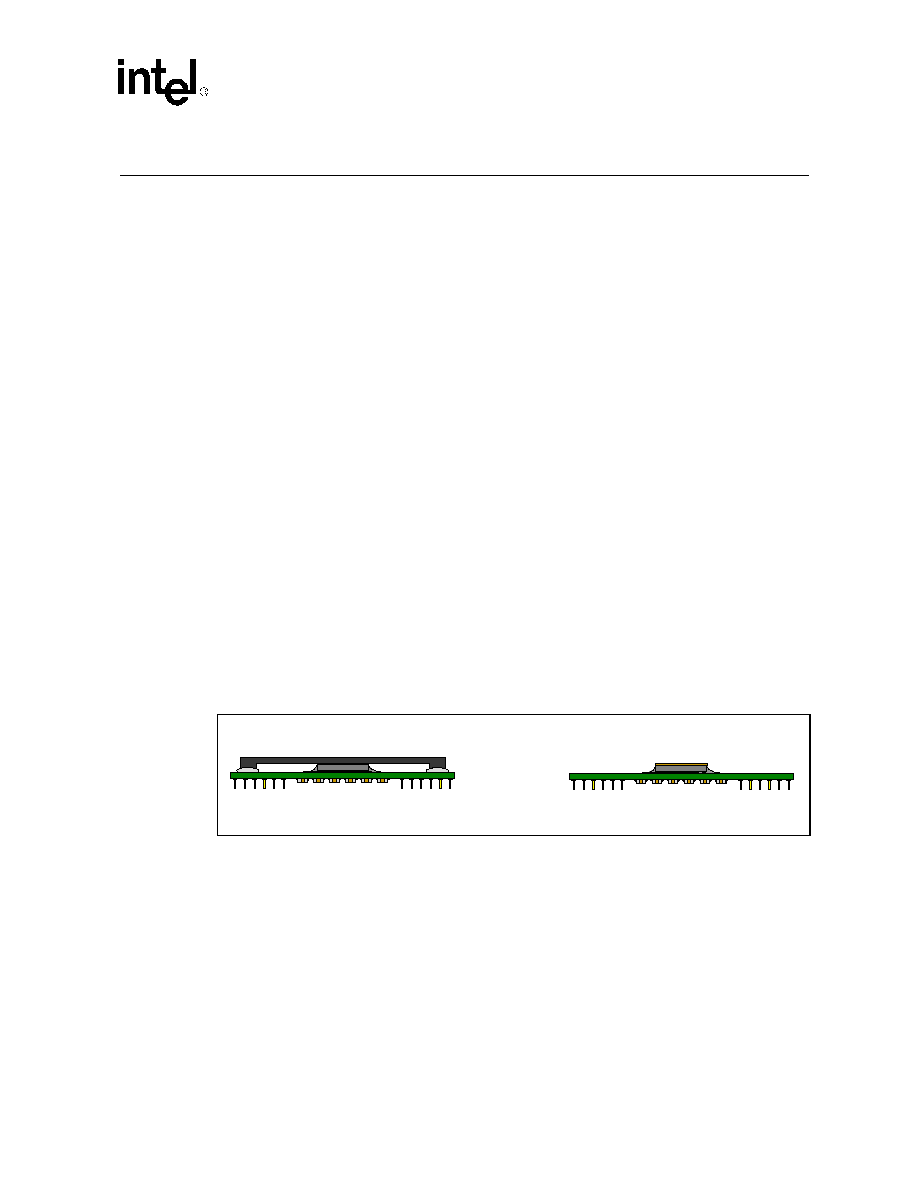
Datasheet
9
Intel
Æ
Celeron
Æ
Processor for PGA370 up to 1.40 GHz on 0.13
µ
Process
1.0
Introduction
The Intel
Æ
Celeron
Æ
processor based on 0.13 micron process core for the PGA370 socket is the
next member of the P6 family, in the Intel IA-32 processor line and hereafter will be referred to as
simply "the processor". The processor will continue in the package technology called flip-chip pin
grid array but will contain a Integrated Heat Spreader (IHS) (see
Figure 1
). The flip-chip with IHS
package will be labeled as FC-PGA2 and will utilize the same 370-pin zero insertion force socket
(PGA370). Thermal solutions contact the IHS directly for the FC-PGA2 package and not to the
bare-die as with the FC-PGA attachment.
The processor, like its predecessors in the P6 family of processors, implements a Dynamic
Execution microarchitecture--a unique combination of multiple branch prediction, data flow
analysis, and speculative execution. The processor delivers higher performance than the Intel
Æ
Celeron
Æ
processor based on 0.18 micron process core, while maintaining binary compatibility
with all previous Intel Architecture processors. The processor also executes Intel
Æ
MMX
TM
technology instructions for enhanced media and communication performance just as the
predecessor Celeron processor based on 0.18 micron process core. Additionally, the processor
executes Streaming SIMD (single-instruction, multiple data) Extensions for enhanced floating
point and 3-D application performance. The processor utilizes multiple low-power states such as
Stop-Grant, Sleep, and Deep Sleep to conserve power during idle times.
The processor includes an integrated on-die, 256KB 8-way set associative level-two (L2) cache.
The L2 cache implements the Advanced Transfer Cache Architecture with a 256-bit wide bus. The
processor also includes a 16 KB level one (L1) instruction cache and 16 KB L1 data cache. These
cache arrays run at the full speed of the processor core. The processor for the PGA370 socket has a
dedicated L2 cache bus, thus maintaining the dual independent bus architecture to deliver high bus
bandwidth and performance. Memory is cacheable for 64 GB of addressable memory space,
allowing significant headroom for desktop systems. Refer to the Specification Update document
for this processor to determine the cacheability and cache configuration options for a specific
processor. Contact your nearest Intel Sales Representative for the latest Processor Specification
Update.
The processor will support a lower voltage differential and single-ended clocking for the system
bus. The previous generation Intel
Celeron processors for the PGA370 socket will function in a
platform that supports this processor, if the platform has been designed to be backward compatible.
In addition, the processor will not function in a previous generation platform due to incompatible
system bus signal levels and clock type. Care must be taken to ensure the correct processors are
installed in the correct PGA370 socket platforms.
Figure 1. Integrated Heat Spreader (IHS)
FC-PGA2 w/IHS FC-PGA

10
Datasheet
Intel
Æ
Celeron
Æ
Processor for PGA370 up to 1.40 GHz on 0.13
µ
Process
1.1
Terminology
In this document, a `#' symbol after a signal name refers to an active low signal. This means that a
signal is in the active state (based on the name of the signal) when driven to a low level. For
example, when FLUSH# is low, a flush has been requested. When NMI is high, a nonmaskable
interrupt has occurred. In the case of signals where the name does not imply an active state but
describes part of a binary sequence (such as address or data), the `#' symbol implies that the signal
is inverted. For example, D[3:0] = `HLHL' refers to a hex `A', and D[3:0]# = `LHLH' also refers to
a hex `A' (H= High logic level, L= Low logic level).
The term "system bus" refers to the interface between the processor, system core logic (a.k.a. the
chipset components), and other bus agents.
1.1.1
Package and Processor Terminology
The following terms are used often in this document and are explained here for clarification:
∑
The processor - The entire product including all internal components.
∑
256k UP processor - The desktop version of the 0.13 micron process processor. Contains
256KB of L2 cache and is uni-processor capable only.
∑
PGA370 socket - 370-pin Zero Insertion Force (ZIF) socket which a FC-PGA packaged
processor plugs into.
∑
FC-PGA - Flip Chip Pin Grid Array. The package technology used on processors based on the
0.18 micron process for the PGA370 socket. The FC-PGA package has the processor die
exposed.
∑
FC-PGA2 - Flip Chip Pin Grid Array 2. The package technology used on the processor for the
PGA370 socket. The FC-PGA2 package contains an Integrated Heat Spreader which covers
the processor die.
∑
Advanced Transfer Cache (ATC) - L2 cache architecture used on the Celeron
Æ
processors.
ATC consists of microarchitectural improvements that provide a higher data bandwidth
interface into the processor core that is completely scaleable with the processor core
frequency.
∑
Keep-out zone - The area on or near a FC-PGA packaged processor that system designs can
not utilize.
∑
Keep-in zone - The area of a FC-PGA packaged processor that thermal solutions may utilize.
∑
Processor - For this document, the term processor is the generic form of the Celeron
Æ
processor based on 0.13 micron process core for the PGA370 socket in the FC-PGA2 package.
∑
Processor core - The processor's execution engine.
∑
Integrated Heat Spreader (IHS) - The Integrated Heat Spreader (IHS) is a metal cover on the
die and it is an integral part of the processor. The IHS promotes heat spreading away from the
die backside to ease thermal constraints
.
The cache and L2 cache are industry designated names.

Datasheet
11
Intel
Æ
Celeron
Æ
Processor for PGA370 up to 1.40 GHz on 0.13
µ
Process
1.1.2
Processor Naming Convention
NOTES:
1. Refer to the Intel
Æ
Celeron
Æ
Processor Specification Update for the exact CPUID for each processor.
2. ATC = Advanced Transfer Cache. ATC is an L2 Cache integrated on the same die as the processor core.
With ATC, the interface between the processor core and L2 Cache is 256-bits wide, runs at the same
frequency as the processor core and has enhanced buffering.
3. 1.20 GHz at Vcc
CORE
= 1.475 volts and S-Spec number SL5XS.
Table 1. Processor Identification
Processor
Core Frequency
System Bus
Frequency
(MHz)
L2 Cache Size
(Kbytes)
L2 Cache
Type
2
CPUID
1
1.4
1.40
100
256
ATC
06Bxh
1.30
1.30 GHz
100
256
ATC
06Bxh
1.20
3
1.20 GHz
100
256
ATC
06Bxh
1.20
1.20 GHz
100
256
ATC
06Bxh
1.10A
1.10A GHz
100
256
ATC
06Bxh
1A
1A GHz
100
256
ATC
06Bxh
900 900 MHz
100
256
ATC
06Bxh

12
Datasheet
Intel
Æ
Celeron
Æ
Processor for PGA370 up to 1.40 GHz on 0.13
µ
Process
1.2
Related Documents
The reader of this specification should also be familiar with material and concepts presented in the
following documents
1,2
:
NOTES:
1. Unless otherwise noted, this reference material can be found on the Intel Developer's Website located at
http://developer.intel.com.
2. For a complete listing of Intel Celeron processor reference material, please refer to the Intel Developer's
Website at http://developer.intel.com/design/Celeron/.
3. This material is available through an Intel Field Sales Representative.
Document
Intel Order Number
AP-485, Intel
Æ
Processor Identification and the CPUID Instruction
241618
AP-589, Design for EMI
243334
Intel
Æ
Architecture Software Developer's Manual 243193
Volume I: Basic Architecture
243190
Volume II: Instruction Set Reference
243191
Volume III: System Programming Guide
243192
P6 Family of Processors Hardware Developer's Manual
244001
IA-32 Processors and Related Products 1999 Databook
243565
370-Pin Socket (PGA370) Design Guidelines
244410
PGA370 Heat Sink Cooling in MicroATX Chassis
245025
815 B-step Chipset Platform Design Guide
3
CK-815 Clock Synthesizer/Driver Specification
3
CK-408 Clock Synthesizer/Driver Specification
3
VRM 8.5 DC-DC Converter Design Guidelines
3
249659
Extensions to the Pentium
Æ
Pro Processor BIOS Writer's Guide Revision
3
Intel
Æ
Pentium
Æ
III Processor in the FC-PGA2, 370-pin Package Thermal Design
Guidelines
3
249660

Datasheet
13
Intel
Æ
Celeron
Æ
Processor for PGA370 up to 1.40 GHz on 0.13
µ
Process
2.0
Electrical Specifications
2.1
Processor System Bus and V
REF
The processor uses the original low voltage signaling of the Gunning Transceiver Logic (GTL)
technology for the system bus. The GTL system bus operates at 1.25V signal levels versus GTL+
which operates at 1.5 V signal levels. The GTL+ signal technology is used by the Intel
Æ
Pentium
Æ
Pro, Intel
Æ
Pentium
Æ
II and Intel
Æ
Pentium
Æ
III
processors.
Current P6 family processors vary from the Intel
Æ
Pentium
Æ
Pro processor in their output buffer
implementation. The buffers that drive the system bus signals on the processor are actively driven
to V
TT
for one clock cycle after the low to high transition to improve rise times. These signals are
open-drain and require termination to a supply. Because this specification is different from the
standard GTL specification, it is referred to as AGTL, or Assisted GTL in this and other
documentation related to the processor.
AGTL logic and AGTL+ logic are not compatible with each other due to differences with the signal
switching levels. The processor cannot be installed into platforms where the chipset only supports
the AGTL+ signal levels. For more information on AGTL or AGTL+ routing, please refer to the
appropriate platform design guide.
AGTL inputs use differential receivers which requires a reference voltage (V
REF
). V
REF
is used by
the differential receivers to determine if the input signal is a logical 0 or a logical 1. The V
REF
signal is typically implemented as a voltage divider on the platform. Noise decoupling is critical for
the V
REF
signal. Refer to the platform design guide for the recommended decoupling requirements.
Another important item for the AGTL system bus is termination.
System bus termination is used to pull each signal to a high voltage level and to control reflections
on the transmission line. The processor contains on-die termination resistors that provide
termination for one end of the system bus. The other end of the system bus should also be
terminated near the chipset by resistors placed on the platform or on-die termination within the
chipset. It is recommended that the system bus is implemented using Dual-End Termination (DET)
to meet the timings and signal integrity specified by the processor.
Figure 2
is a schematic
representation of the AGTL bus topology for the processor, when the chipset has does not have on-
die termination.
Note: The RESET# signal requires a discrete external termination resistor on the system board.
The AGTL bus depends on incident wave switching. Therefore, timing calculations for AGTL
signals are based on flight time as opposed to capacitive deratings. Analog signal simulations of the
system bus, including trace lengths, is highly recommended especially when not following the
recommended layout guidelines.

14
Datasheet
Intel
Æ
Celeron
Æ
Processor for PGA370 up to 1.40 GHz on 0.13
µ
Process
2.2
Clock Control and Low Power States
Processors allow the use of Sleep, and Deep Sleep states to reduce power consumption by stopping
the clock to internal sections of the processor, depending on each particular state. See
Figure 3
for a
visual representation of the processor low power states.
For the processor to fully realize the low current consumption of the Stop-Grant, Sleep and Deep
Sleep states, a Model Specific Register (MSR) bit must be set. For the MSR at 02AH (Hex), bit 26
must be set to a `1' (this is the power on default setting) for the processor to stop all internal clocks
during these modes. For more information, see the Intel Architecture Software Developer's
Manual, Volume 3: System Programming Guide.
Figure 2. AGTL Bus Topology in a Uniprocessor Configuration
Processor
Chipset
I/O
I/O
Note: RESET# requires external termination.
Figure 3. Stop Clock State Machine
PCB757a
2. Auto HALT Power Down State
BCLK running.
Snoops and interrupts allowed.
HALT Instruction and
HALT Bus Cycle Generated
INIT#, BINIT#, INTR,
SM I#, RESET#
1. Normal State
Norm al execution.
STPCLK#
Asserted
STPCLK#
De-asserted
3. Stop Grant State
BCLK running.
Snoops and interrupts allowed.
SLP#
Asserted
SLP#
De-asserted
5. Sleep State
BCLK running.
No snoops or interrupts allowed.
BCLK
Input
Stopped
BCLK
Input
Restarted
6. Deep Sleep State
BCLK stopped.
No snoops or interrupts allowed.
4. HALT/Grant Snoop State
BCLK running.
Service snoops to caches.
Snoop Event Occurs
Snoop Event Serviced
Snoop
Event
Occurs
Snoop
Event
Serviced
STPCLK# Asserted
STPCLK# De-asserted
and Stop-Grant State
entered from
AutoHALT

Datasheet
15
Intel
Æ
Celeron
Æ
Processor for PGA370 up to 1.40 GHz on 0.13
µ
Process
2.2.1
Normal State--State 1
This is the normal operating state for the processor.
2.2.2
AutoHALT Powerdown State--State 2
AutoHALT is a power state entered when the processor executes the HALT instruction. The
processor transitions to the Normal state upon the occurrence of SMI#, INIT#, or LINT[1:0] (NMI,
INTR). RESET# causes the processor to immediately initialize itself.
The return from a System Management Interrupt (SMI) handler can be to either Normal Mode or
the AutoHALT Power Down state. See the Intel Architecture Software Developer's Manual,
Volume III: System Programmer's Guide for more information.
FLUSH# is serviced during the AutoHALT state, and the processor will return to the AutoHALT
state.
The system can generate a STPCLK# while the processor is in the AutoHALT Power Down state.
When the system deasserts the STPCLK# interrupt, the processor returns execution to the HALT
state.
2.2.3
Stop-Grant State--State 3
The Stop-Grant state on the processor is entered when the STPCLK# signal is asserted.
Since the AGTL signal pins receive power from the system bus, these pins should not be driven
(allowing the level to return to V
TT
) for minimum power drawn by the termination resistors in this
state. In addition, all other input pins on the system bus should be driven to the inactive state.
BINIT# and FLUSH# are not serviced during the Stop-Grant state.
RESET# causes the processor to immediately initialize itself, but the processor stays in Stop-Grant
state. A transition back to the Normal state occurs with the deassertion of the STPCLK# signal.
A transition to the HALT/Grant Snoop state occurs when the processor detects a snoop on the
system bus (see
Section 2.2.4
). A transition to the Sleep state (see
Section 2.2.5
) occurs with the
assertion of the SLP# signal.
While in Stop-Grant State, SMI#, INIT#, and LINT[1:0] are latched by the processor, and only
serviced when the processor returns to the Normal state. Only one occurrence of each event is
recognized and serviced upon return to the Normal state.
2.2.4
HALT/Grant Snoop State--State 4
The processor responds to snoop transactions on the system bus while in Stop-Grant state or in
AutoHALT Power Down state. During a snoop transaction, the processor enters the HALT/Grant
Snoop state. The processor stays in this state until the snoop on the system bus has been serviced
(whether by the processor or another agent on the system bus). After the snoop is serviced, the
processor returns to the Stop-Grant state or AutoHALT Power Down state, as appropriate.

16
Datasheet
Intel
Æ
Celeron
Æ
Processor for PGA370 up to 1.40 GHz on 0.13
µ
Process
2.2.5
Sleep State--State 5
The Sleep state is a very low power state in which the processor maintains its context, maintains
the phase-locked loop (PLL), and has stopped all internal clocks. The Sleep state can only be
entered from the Stop-Grant state. Once in the Stop-Grant state, the SLP# pin can be asserted,
causing the processor to enter the Sleep state. The SLP# pin is not recognized in the Normal or
AutoHALT states.
Snoop events that occur while in Sleep State or during a transition into or out of Sleep state will
cause unpredictable behavior.
In the Sleep state, the processor is incapable of responding to snoop transactions or latching
interrupt signals. No transitions or assertions of signals (with the exception of SLP# or RESET#)
are allowed on the system bus while the processor is in Sleep state. Any transition on an input
signal before the processor has returned to Stop-Grant state will result in unpredictable behavior.
If RESET# is driven active while the processor is in the Sleep state, and held active as specified in
the RESET# pin specification, then the processor will reset itself, ignoring the transition through
Stop-Grant State. If RESET# is driven active while the processor is in the Sleep State, the SLP#
and STPCLK# signals should be deasserted immediately after RESET# is asserted to ensure the
processor correctly executes the reset sequence.
While in the Sleep state, the processor is capable of entering its lowest power state, the Deep Sleep
state, by stopping the BCLK input (see
Section 2.2.6
). Once in the Sleep state, the SLP# pin can be
deasserted if another asynchronous system bus event occurs. The SLP# pin has a minimum
assertion of one BCLK period.
2.2.6
Deep Sleep State--State 6
The Deep Sleep state is the lowest power state the processor can enter while maintaining context.
The Deep Sleep state is entered by stopping the BCLK input (after the Sleep state was entered from
the assertion of the SLP# pin). The processor is in Deep Sleep state immediately after BCLK is
stopped. BCLK and BCLK# have to be separated by at least 0.2V during the Deep Sleep State.
Stopping of the BCLK input lowers the overall current consumption to leakage levels.
To re-enter the Sleep state, the BCLK input must be restarted. A period of 1 ms (to allow for PLL
stabilization) must occur before the processor can be considered to be in the Sleep state. Once in
the Sleep state, the SLP# pin can be deasserted to re-enter the Stop-Grant state.
While in Deep Sleep state, the processor is incapable of responding to snoop transactions or
latching interrupt signals. No transitions or assertions of signals are allowed on the system bus
while the processor is in Deep Sleep state. Any transition on an input signal before the processor
has returned to Stop-Grant state will result in unpredictable behavior.
NOTES:
1. The values in this table are based on differential probe measurement of the Bclk.
2. The DC voltage level specified must be maintained when the system bus clock is not active (e.g., Deep Sleep
Mode). V
BCLK#
has to be 200 mV less than V
BCLK
.
Table 2. System Bus Clock in Deep Sleep Mode (Differential Mode only)
Symbol
Parameter
Min
Max
Units
Notes
1
V
BCLK
BCLK Voltage Level when not active
0.4
1.45
V
2
V
BCLK
≠V
BCLK#
BCLK# Voltage Level when not active
0
V
BCLK
≠ 0.2
V
2

Datasheet
17
Intel
Æ
Celeron
Æ
Processor for PGA370 up to 1.40 GHz on 0.13
µ
Process
2.2.7
Clock Control
BCLK provides the clock signal for the processor and on-die L2 cache. During AutoHALT Power
Down and Stop-Grant states, the processor will process a system bus snoop. The processor does not
stop the clock to the L2 cache during AutoHALT Power Down or Stop-Grant states. Entrance into
the Halt/Grant Snoop state allows the L2 cache to be snooped, similar to the Normal state.
When the processor is in Sleep and Deep Sleep states, it does not respond to interrupts or snoop
transactions. During the Sleep state, the internal clock to the L2 cache is not stopped. During the
Deep Sleep state, the internal clock to the L2 cache is stopped. The internal clock to the L2 cache is
restarted only after the internal clocking mechanism for the processor is stable (i.e., the processor
has re-entered Sleep state).
PICCLK should not be removed during the AutoHALT Power Down or Stop-Grant states.
PICCLK can be removed during the Sleep or Deep Sleep states. When transitioning from the Deep
Sleep state to the Sleep state, PICCLK must be restarted with BCLK.
2.3
Power and Ground Pins
The operating voltage for the processor is the same for the core and the L2 cache. V
CCCORE
is
defined as the power pins that supply voltage to the processor's core and cache. The Voltage
Regulator Module (VRM) or Voltage Regulator are controlled by the five voltage identification
(VID) signals driven by the processor. The VID signals specify the voltage required by the
processor core. Refer to
Section 2.6
for further details on the VID voltage settings.
The processor has 74 V
CCCORE
, 7 V
REF
, 20 V
TT
, V
CCCMOS1.5
, V
CCCMOS1.8,
V
CCCMOS2.0
and 74
V
SS
inputs. The V
REF
inputs are used as the AGTL reference voltage for the processor. The V
TT
inputs (1.25V) are used to provide an AGTL termination voltage to the processor. V
CCCMOS1.5
and
V
CCCMOS1.8
and V
CCCMOS2.0
are not voltage input pins to the processor but rather voltage sources
for the pullup resistors which are connected to CMOS (non-AGTL) input/output signals driven to/
from the processor. The V
SS
inputs are ground pins for the processor core and L2 cache.
On the platform, all V
CCCORE
pins must be connected to a voltage island (an island is a portion of
a power plane that has been divided, or an entire plane) to minimize any voltage drop that may
occur due to trace impedance. It is also highly recommended for the platform to provide either a
voltage island or a wide trace for the V
TT
pins. Similarly, all Vss pins must be connected to a
system ground plane. These recommendations can be found in the platform design guide layout
section.
2.3.1
Phase Lock Loop (PLL) Power
It is highly critical that phase lock loop power delivery to the processor meets Intel's requirements.
A low pass filter is required for power delivery to pins PLL1 and PLL2. This serves as an isolated,
decoupled power source for the internal PLL. Refer to the Phase Lock Loop Power section in the
appropriate platform design guide for the recommended filter implementation.
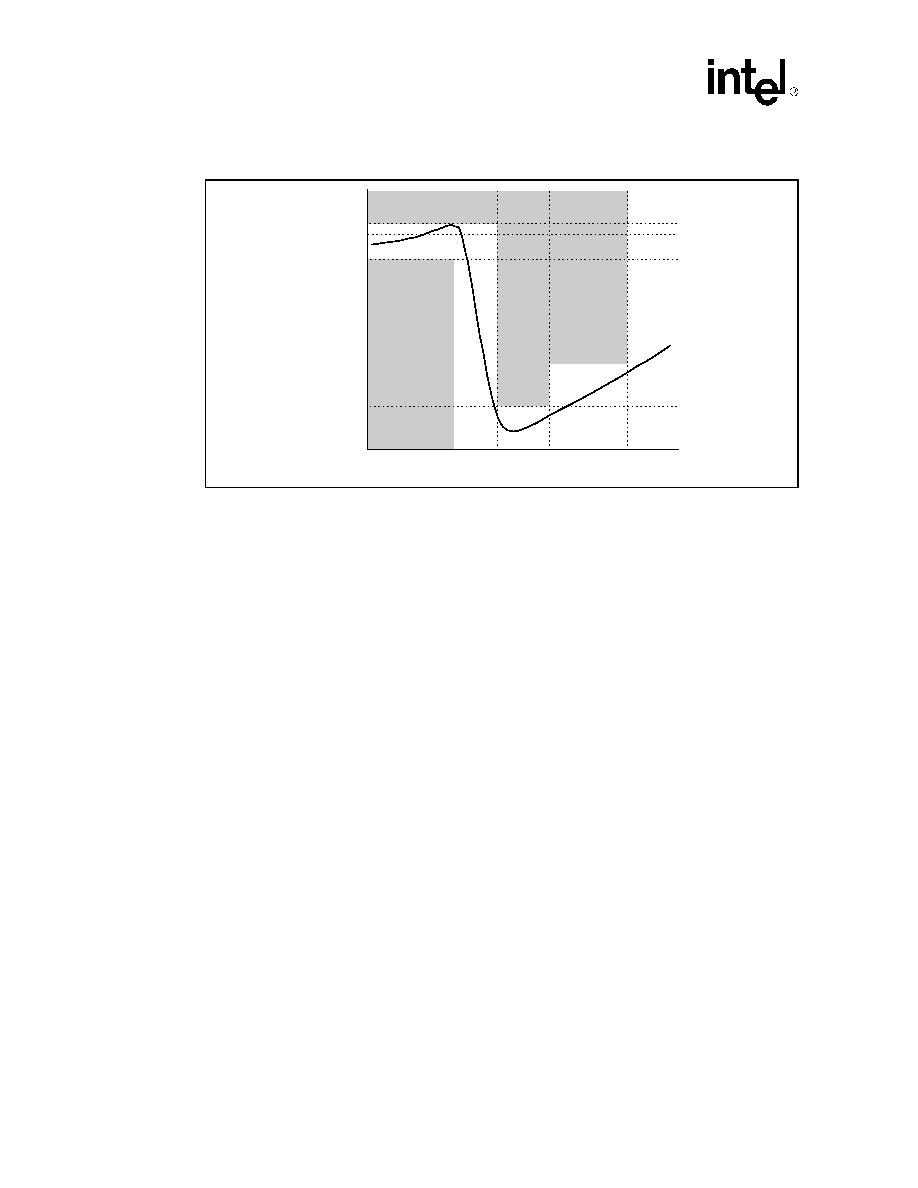
18
Datasheet
Intel
Æ
Celeron
Æ
Processor for PGA370 up to 1.40 GHz on 0.13
µ
Process
2.4
Decoupling Guidelines
Due to the large number of transistors and high internal clock speeds, the processor is capable of
generating large average current swings between low and full power states. The fluctuations can
cause voltages on power planes to sag below their nominal values if bulk decoupling is not
adequate. Care must be taken in the board design to ensure that the voltage provided to the
processor remains within the specifications listed in
Table 7
. Failure to do so can result in timing
violations (in the event of a voltage sag) or a reduced lifetime of the component (in the event of a
voltage overshoot).
2.4.1
Processor V
CC
CORE
Decoupling
The regulator for the V
CCCORE
input must be capable of delivering the dI
CCCORE
/dt (defined in
Table 7
) while maintaining the required tolerances (also defined in
Table 7
). Failure to meet these
specifications can result in timing violations (during V
CCCORE
sag) or a reduced lifetime of the
component (during V
CCCORE
overshoot).
The processor requires both high frequency and bulk decoupling on the system motherboard for
proper AGTL bus operation. The minimum recommendation for the processor decoupling
requirement is listed below. All capacitors should be placed next to and within the PGA370 socket
cavity and mounted on the primary side of the motherboard. The capacitors are arranged to
minimize the overall inductance between the V
CCCORE
and Vss power pins.
Decoupling Recommendations:
∑
V
CCCORE
decoupling: A minimum of sixteen 4.7 uF capacitors in a 1206 package.
∑
V
TT
decoupling: Twenty 0.1 uF capacitors in 0603 packages.
∑
V
REF
decoupling: 0.1 uF and 0.001 uF capacitors in 0603 package placed near the V
REF
pins.
For additional decoupling requirements, refer to the appropriate platform design guide for
recommended capacitor component value/quantity and placement.
Figure 4. PLL Filter Specification
0.2 dB
0 dB
-0.5 dB
Forbidden
Zone
Forbidden
Zone
-40 dB
-28 dB
DC
fpeak
1 MHz
66 MHz
force
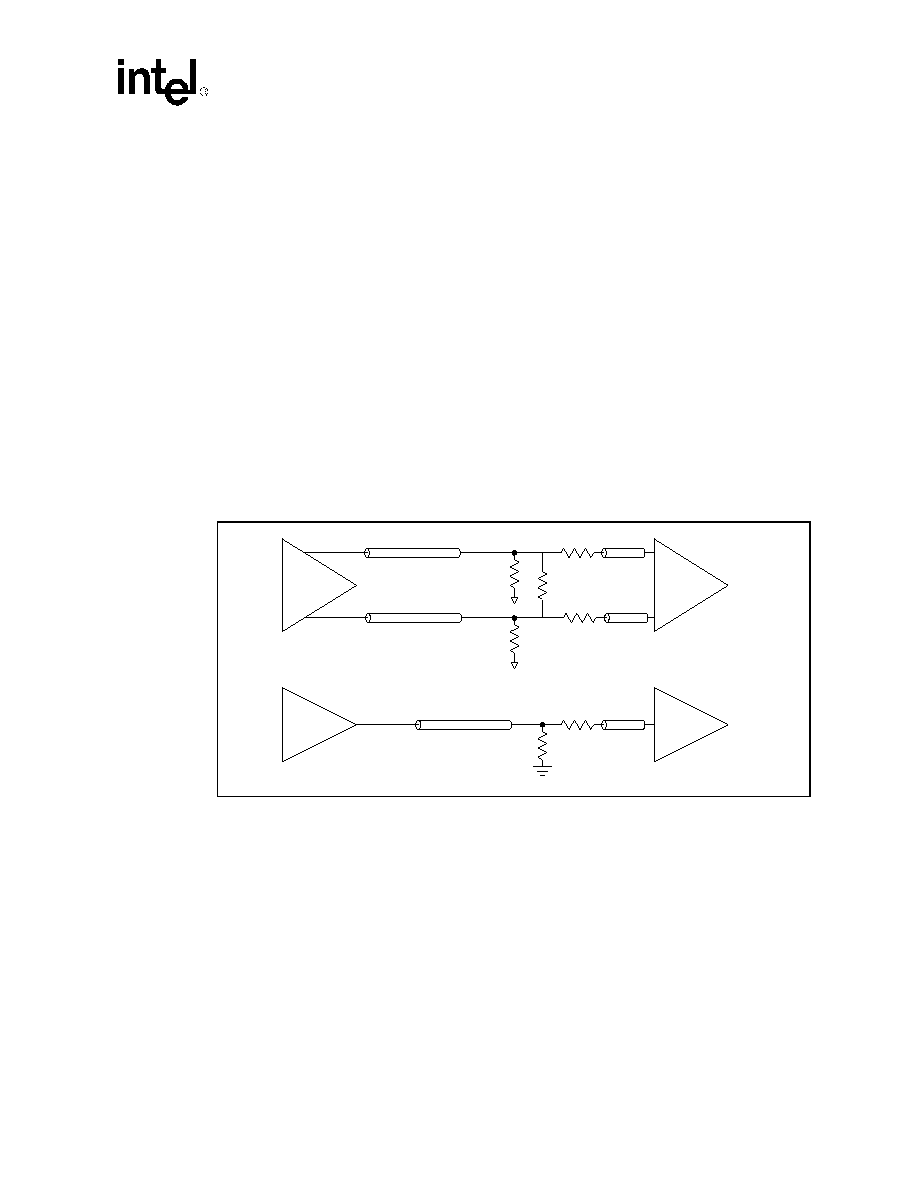
Datasheet
19
Intel
Æ
Celeron
Æ
Processor for PGA370 up to 1.40 GHz on 0.13
µ
Process
2.5
Processor System Bus Clock and Processor Clocking
The processor will implement an auto-detect mechanism that will allow the processor to use either
single-ended or differential signaling for the system bus and processor clocking. The processor
checks to see if the signal on pin Y33 is toggling. If this signal is toggling then the processor
operates in differential mode. Refer to
Figure 5
for an example on differential clocking. Resistor
values and clock topology are listed in the appropriate platform design guide for a differential
implementation.
Note: References to BCLK throughout this document will also imply to it's complement signal, BCLK#
in differential implementations, and when noted otherwise.
Since legacy PGA370 socket platforms use a different single-ended clocking specification than the
processor, the processor will not function when placed into these platforms. The BCLK input
directly controls the operating speed of the system bus interface. All AGTL system bus timing
parameters are specified with respect to the crossing point of the rising edge of the BCLK and the
falling edge of BCLK# inputs in a differential implementation. See the P6 Family of Processors
Hardware Developer's Manual for further details. The reference voltage of the BCLK in the P6
Family of Processors Hardware Developer Manual is re-defined as the crossing point of the BCLK
and BCLK# in a differential implementation.
2.6
Voltage Identification
There are five voltage identification (VID) pins on the PGA370 socket. These pins can be used to
support automatic selection of V
CCCORE
voltages. The VID pins for the processor are open drain
signals versus opens or shorts found on the previous Intel Celeron
FC-PGA processor. Refer to
Table 11
for level specifications for the VID signals. This pull-up resistor may be either external
logic on the motherboard or internal to the Voltage Regulator.
The VID signals rely on a 3.3 V pull-up resistor to set the signal to a logic high level. The VID pins
are needed to fully support voltage specification variations on current and future processors. The
voltage selection range for the processor is defined in
Table 3
. The VID25mV signal is a new
signal that allows the voltage regulator or voltage regulator module (VRM) to output voltage levels
in 25 mV increment necessary for the processor only. The current Celeron processor in the FC-
PGA package will not have this VID25mV signal. The VID25mV pin location is actually a Vss pin
Figure 5. Differential/Single-Ended Clocking Example
Clk E
Diff Si
l
BCLK
BCLK#
Clock
Driver
Processor
or Chipset
+
≠
Clock
Driver
Processor
or Chipset
BCLK

20
Datasheet
Intel
Æ
Celeron
Æ
Processor for PGA370 up to 1.40 GHz on 0.13
µ
Process
on the model 68xh based on 0.18 micron process core processor. By connecting the VID25mV
signal to the Vss pin, it will disable the 25 mV stepping granularity output and the regulator will
resort to 50 mV stepping increment. The voltage regulator or VRM must supply the voltage that is
requested or disable itself.
In addition to the new signal "VID25mV", the processor will introduce a second new signal labeled
as "VTT_PWRGD". The VTT_PWRGD signal informs the platform that the VID and BSEL
signals are stable and should be sampled. During Power-up, the VID signals will be in an
indeterminate state for a small period of time. The voltage regulator or the VRM should not latch
the VID signals until the VTT_PWRGD signal is asserted by the VRM and sampled active. The
assertion of the VTT_PWRGD signal indicates the VID signals are stable and are driven to the
final state by the processor. Refer to
Figure 14
for power-up timing sequence for the
VTT_PWRGD and the VID signals.
NOTES:
1. 0 = Processor pin connected to V
SS
. and 1 = Open on processor; may be pulled up to TTL V
IH
(3.3 V max) on
baseboard.
Table 3. Voltage Identification Definition
1
VID25mV
VID3
VID2
VID1
VID0
Vcc
CORE
0
0
1
0
0
1.05
1
0
1
0
0
1.075
0
0
0
1
1
1.10
1
0
0
1
1
1.125
0
0
0
1
0
1.15
1
0
0
1
0
1.175
0
0
0
0
1
1.20
1
0
0
0
1
1.225
0
0
0
0
0
1.25
1
0
0
0
0
1.275
0
1
1
1
1
1.30
1
1
1
1
1
1.325
0
1
1
1
0
1.35
1
1
1
1
0
1.375
0
1
1
0
1
1.40
1
1
1
0
1
1.425
0
1
1
0
0
1.45
1
1
1
0
0
1.475
0
1
0
1
1
1.50
1
1
0
1
1
1.525
0
1
0
1
0
1.55
1
1
0
1
0
1.575
0
1
0
0
1
1.60
1
1
0
0
1
1.625
0
1
0
0
0
1.65
1
1
0
0
0
1.675
0
0
1
1
1
1.70
1
0
1
1
1
1.725
0
0
1
1
0
1.75
1
0
1
1
0
1.775
0
0
1
0
1
1.80
1
0
1
0
1
1.825
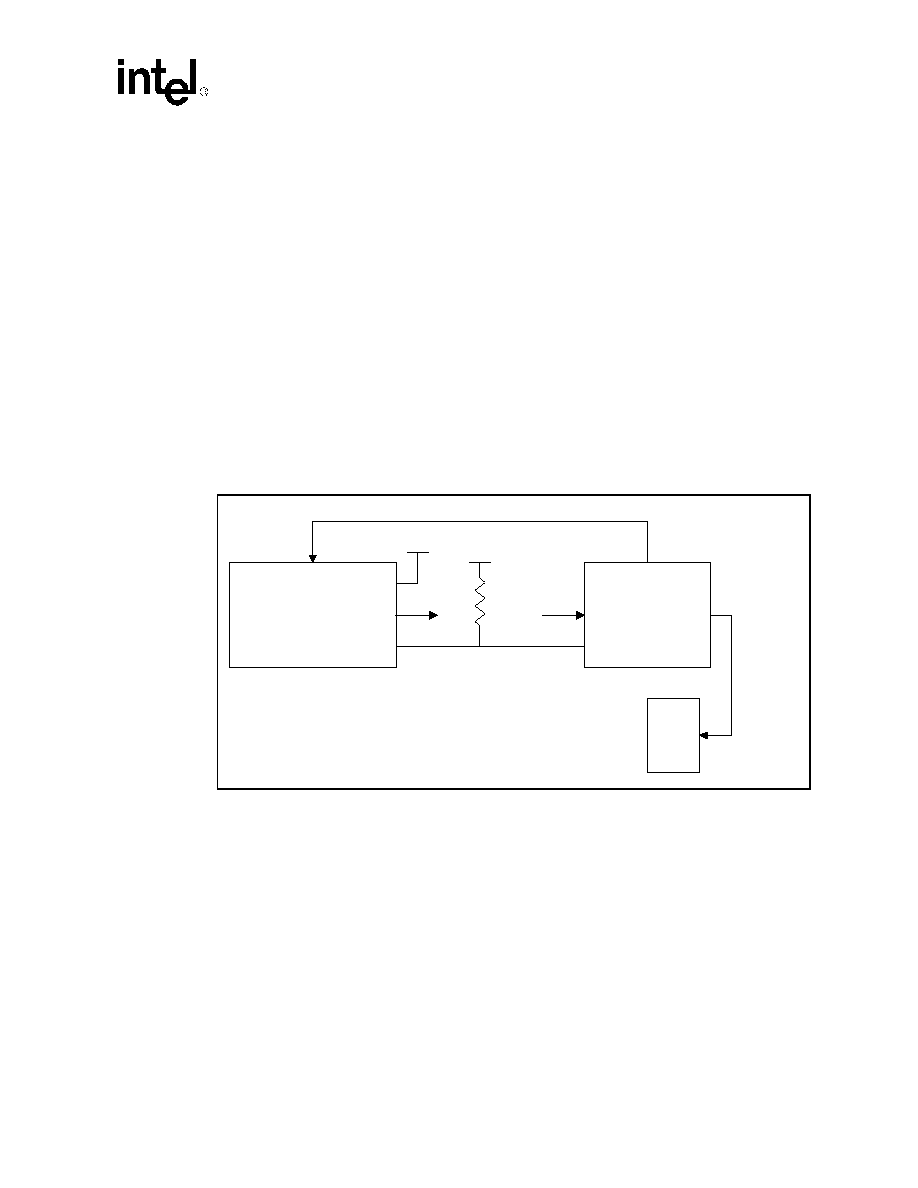
Datasheet
21
Intel
Æ
Celeron
Æ
Processor for PGA370 up to 1.40 GHz on 0.13
µ
Process
The VID pins should be pulled up to a 3.3 V level. This may be accomplished with pull-ups
internal to the voltage regulator, which ensures valid VID pull-up voltage during Power-up and
Power-down sequences. If external resistors are used for the VID[3:0, 25mV] signal, then the
power source must be guaranteed to be stable whenever the supply to the voltage regulator is
stable. This will prevent the possibility of the processor supply going above the specified V
CCCORE
in the event of a failure in the supply for the VID lines. In the case of a DC-to-DC converter, this
can be accomplished by using the input voltage to the converter for the VID line pull-ups. A
resistor equal to 1 k
may be used to connect the VID signals to the voltage regulator input.
Note: Intel requires that designs utilize VRM 8.5 and Not VRM 8.4 guidelines to meet the processor
requirements.
To re-emphasize, VRM 8.5 introduces two new signals [VID25mV and VTT_PWRGD] that is
utilized by the processor and platform. Ignoring and not connecting these two new pins, as
documented in the Platform Design Guidelines, will prevent the processor from operating at the
specified voltage levels and core frequency.
Figure 6
provides a high-level interconnection
schematic. Refer to the VRM 8.5 DC-DC Converter Design Guideline and the appropriate Platform
Design Guidelines for further detailed information on the voltage identification and bus select
implementation. Refer to
Figure 14
for VID power-up sequence and timing requirements.
2.7
Processor System Bus Unused Pins
All RESERVED pins must remain unconnected unless specifically noted. Connection of these pins
to V
CCCORE
, V
REF
, V
SS
, V
TT
or to any other signal (including each other) can result in component
malfunction or incompatibility with future processors. See
Section 5.4
for a pin listing of the
processor and the location of each RESERVED pin.
PICCLK must be driven with a valid clock input and the PICD[1:0] signals must be pulled-up to
V
CCCMOS1.5
even when the APIC will not be used. A separate pull-up resistor must be provided for
each PICD signal.
For reliable operation, always connect unused inputs or bidirectional signals to their deasserted
signal level. The pull-up or pull-down resistor values are system dependent and should be chosen
such that the logic high (V
IH
) and logic low (V
IL
) requirements are met. See
Table 11
for level
specifications of non-AGTL signals.
Figure 6. V
TT
Power Good and Bus Select Interconnect Diagram
VRM 8.5
Voltage Regulator
VTT_PWRGD
(output)
V
TT
Intel
Æ
Celeron
Processor based on
0.13 Micron Process
VTT_PWRGD
(input)
V
TT
V
CC
CORE
V
TT
V
CC
CORE
1 k
Clock
Driver
BSEL[1:0]
VID[3:0, 25mV]

22
Datasheet
Intel
Æ
Celeron
Æ
Processor for PGA370 up to 1.40 GHz on 0.13
µ
Process
For unused AGTL inputs, the on-die termination will be sufficient. No external R
TT
is necessary on
the motherboard
For unused CMOS inputs, active low signals should be connected through a pull-up resistor to
V
CCCMOS1.5
and meet V
IH
requirements. Unused active high CMOS inputs should be connected
through a pull-down resistor to ground (V
SS
) and meet V
IL
requirements. Unused CMOS outputs
can be left unconnected. A resistor must be used when tying bidirectional signals to power or
ground. When tying any signal to power or ground, a resistor will also allow for system testability.
2.8
Processor System Bus Signal Groups
To simplify the following discussion, the processor system bus signals have been combined into
groups by buffer type. All P6 family processor system bus outputs are open drain and require a
high-level source provided termination resistors. However, the processor includes on-die
termination for AGTL signals and termination resistors placed on the platform are not necessary
except for the RESET# signal which still requires external termination.
AGTL input signals have differential input buffers which use V
REF
as a reference signal. AGTL
output signals require termination to 1.25 V. In this document, the term "AGTL Input" refers to the
AGTL input group as well as the AGTL I/O group when receiving. Similarly, "AGTL Output"
refers to the AGTL output group as well as the AGTL I/O group when driving.
The PWRGOOD signal input is a 1.8 V signal level and must be pulled up to V
CCCMOS1.8
. The
VTT_PWRGD is not 1.8 V tolerant and must be connected to V
TT (
1.25 V)
.
Other CMOS inputs
(A20M#, IGNNE#, INIT#, LINT0/INTR, LINT1/NMI, PREQ#, SMI, SLP#, and STPCLK#) are
only 1.5 V tolerant and must be pulled up to V
CCCMOS1.5
. The CMOS, APIC, and TAP outputs are
open drain and must be pulled to the appropriate level to meet the input specifications of the
interfacing device.
The groups and the signals contained within each group are shown in
Table 4
. Refer to
Section 7.0
for a description of these signals.

Datasheet
23
Intel
Æ
Celeron
Æ
Processor for PGA370 up to 1.40 GHz on 0.13
µ
Process
NOTES:
1. See
Section 7.0
for information on the these signals.
2. The BR0# pin is the only BREQ# signal that is bidirectional. See
Section 7.0
for more information.
3. This signal is 1.25 V.
4. These signals are 1.5 V.
5. This signal is 1.8 V.
6. V
CC
CORE
is the power supply for the processor core and is described in
Section 2.6
.
VID[3:0,25mV] is described in
Section 2.6
.
V
TT
is used to terminate the system bus and generate V
REF
on the motherboard.
V
SS
is system ground.
BSEL[1:0] is described in
Section 2.8.2
and
Section 7.0
.
All other signals are described in
Section 7.0
.
7. This signal is used to control the value of the processor on-die termination resistance. Refer to the platform
design guide for the recommended pulldown resistor value.
8. These signals are 3.3 V.
9. These signals are 2.0 V.
10. 1.25 V signal for Differential clock application and 2.5 V for Single-ended clock application.
2.8.1
Asynchronous vs. Synchronous for System Bus Signals
All AGTL signals are synchronous to BCLK (BCLK/BCLK#). All of the CMOS, Clock, APIC,
and TAP signals can be applied asynchronously to BCLK (BCLK/BCLK#). All APIC signals are
synchronous to PICCLK. All TAP signals are synchronous to TCK.
Table 4. System Bus Signal Groups
1
Group Name
Signals
AGTL Input
BPRI#, DEFER#, RESET#, RSP#
AGTL Output
PRDY#
AGTL I/O
A[35:3]#, ADS#, AERR#, AP[1:0]#, BERR#, BINIT#, BNR#, BP[3:2]#, BPM[1:0]#,
BR0#
2
, D[63:0]#, DBSY#, DEP[7:0]#, DRDY#, HIT#, HITM#, LOCK#, REQ[4:0]#, RP#,
RS[2:0]#, TRDY#
CMOS Input
(1.25 V)
3
VTT_PWRGD
CMOS Input
(1.5 V)
4
A20M#, FLUSH#, IGNNE#, INIT#, LINT0/INTR, LINT1/NMI, PREQ#, SLP#, SMI#,
STPCLK#
CMOS Input
(1.8 V)
5
PWRGOOD
CMOS Output
(1.5 V)
4
FERR#, IERR#, THERMTRIP#
CMOS Output
8
(3.3 V)
VID[3:0,25mV], BSEL[1:0]
System Bus
Clock
10
(1.25 V/2.5 V)
BCLK0, BCLK0#
APIC Clock
9
PICCLK
APIC I/O
4
PICD[1:0]
TAP Input
4
TCK, TDI, TMS, TRST#
TAP Output
4
TDO
Power/Other
6
CPUPRES#, DYN_OE, NCHTRL, PLL[2:1], SLEWCTRL, RTTCTRL
7
,THERMDN,
THERMDP, V
CC
CORE
, V
REF
, V
SS
, V
TT
, Reserved,
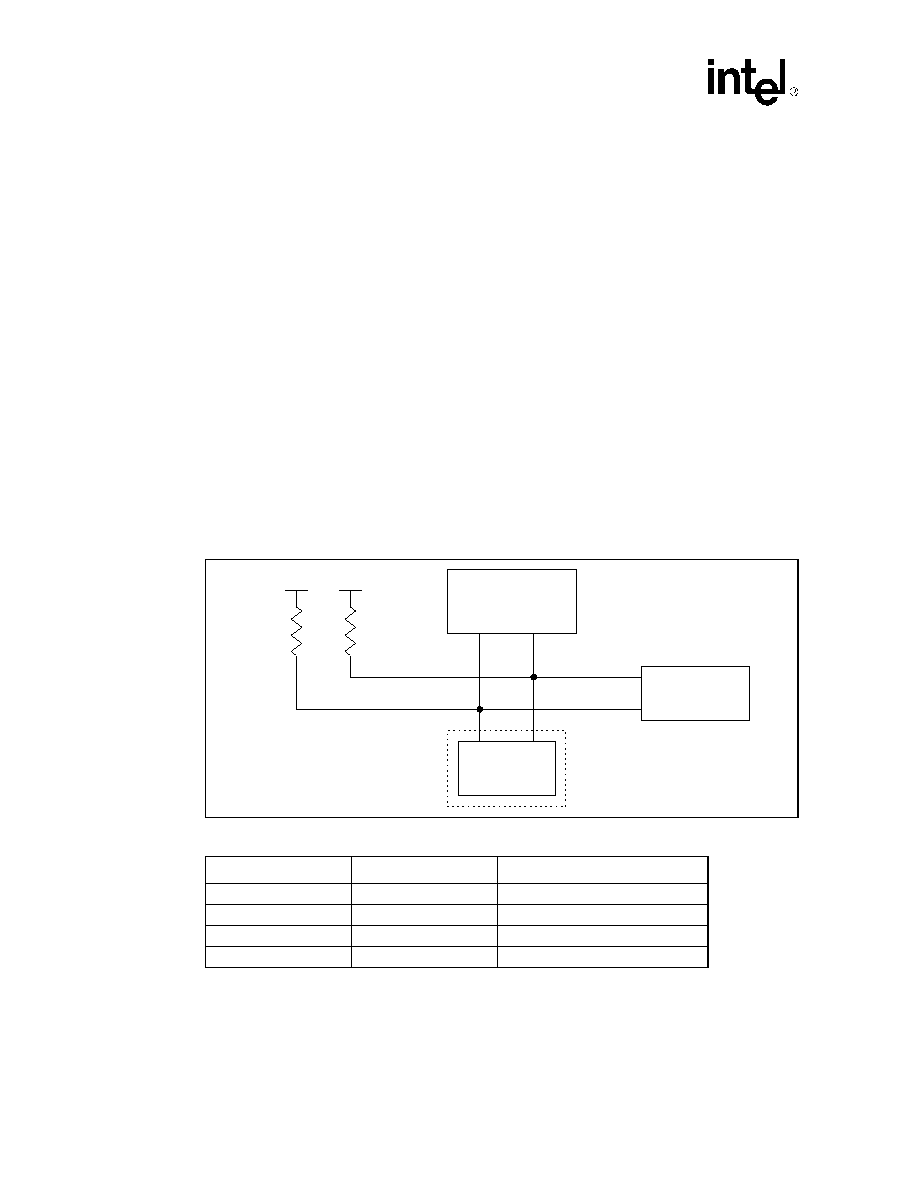
24
Datasheet
Intel
Æ
Celeron
Æ
Processor for PGA370 up to 1.40 GHz on 0.13
µ
Process
2.8.2
System Bus Frequency Select Signals
The System Bus Frequency Select Signals (BSEL [1:0]) are used to select the system bus
frequency for the processor. The BSEL signals are also used by the chipset and system bus clock
generator. The BSEL pins for the processor are open drain signals versus opens or shorts found on
the previous Intel Celeron FC-PGA processor. Refer to
Table 11
for level specifications for the
BSEL signals.
The BSEL signals rely on a 3.3 V pull-up resistor to set the signal to a logic high level. Similar to
the VID signals described in
Section 2.6
, the VTT_PWRGD signal also informs the platform that
the BSEL signals are stable and should be sampled. During Power-up, the BSEL signals will be in
a indeterminate state for a small period of time. The chipset or system bus clock generator should
not sample and/or latch the BSEL signals until the VTT_PWRGD signal is asserted. The assertion
of the VTT_PWRGD signal indicates the BSEL signals are stable and are driven to the final state
by the processor. Refer to
Figure 14
for power-up timing sequence for the VTT_PWRGD and the
BSEL signals.
Table 5
defines the possible combinations of the BSEL signals and the frequency associated with
each combination. The frequency selection is determined by the processor(s) and driven out to the
chipset and system bus clock generator. All system bus agents must operate at the same frequency
determined by the processor. The processor operates at 100 MHz system bus frequency based on
the system bus specified rating marked on the package. Over or under-clocking the system bus
frequency outside the specified rating marked on the package is not recommended.
Figure 7. BSEL[1:0] Example for a System Design
Table 5. Frequency Select Truth Table for BSEL[1:0]
BSEL1
BSEL0
Frequency
0
0
Reserved
0
1
100 MHz
1
0
Reserved
1
1
Reseved
Processor
BSEL0
BSEL1
Chipset
Clock Driver
1 k
3.3V
3.3V

Datasheet
25
Intel
Æ
Celeron
Æ
Processor for PGA370 up to 1.40 GHz on 0.13
µ
Process
2.9
Test Access Port (TAP) Connection
Due to the voltage levels supported by other components in the Test Access Port (TAP) logic, it is
recommended that the processor be first in the TAP chain and followed by any other components
within the system. A translation buffer should be used to connect to the rest of the chain unless one
of the other components is capable of accepting an input of the appropriate voltage. Similar
considerations must be made for TCK, TMS, and TRST#. Two copies of each signal may be
required with each driving a different voltage level.
2.10
Maximum Ratings
Table 6
contains processor stress ratings only. Functional operation at the absolute maximum and
minimum is not implied nor guaranteed. The processor should not receive a clock while subjected
to these conditions. Functional operating conditions are given in the timing and level tables in
Section 2.11
through
Section 2.13
. Extended exposure to the maximum ratings may affect device
reliability. Furthermore, although the processor contains protective circuitry to resist damage from
static electric discharge, one should always take precautions to avoid high static voltages or electric
fields.
NOTES:
1. Input voltage can never exceed V
SS
+1.78 volts.
2. Input voltage can never exceed V
SS
+ 2.08 volts.
3. Input voltage can never go below -0.3 V
4. Parameter applies to CMOS, APIC, and TAP bus signal groups only.
2.11
Processor Voltage Level Specifications
The processor voltage level specifications in this section are defined at the PGA370 socket pins
(bottom side of the motherboard). See
Section 7.0
for the processor signal descriptions and
Section 5.4
for the signal listings.
Most of the signals on the processor system bus are in the AGTL signal group. These signals are
specified to be terminated to 1.25 V. The voltage level specifications for these signals are listed in
Table 10 on page 29
.
To allow connection with other devices, the clock, CMOS, APIC, and TAP signals are designed to
interface at non-AGTL levels. The voltage level specifications for these pins are listed in
Table 11
on page 29
.
Table 6. Absolute Maximum Ratings
Symbol
Parameter
Min
Max
Unit
Notes
T
STORAGE
Processor storage temperature
-40
85
∞C
V
CC
CORE
and
V
TT
Processor core voltage and termination
supply voltage with respect to V
SS
0.5
1.75
V
V
inAGTL
AGTL buffer input voltage
-0.3
1.78
V
1, 3
V
inCMOS1.5
CMOS buffer DC input voltage with respect
to V
SS
-0.3
2.08
V
2, 3, 4
V
VID &
V
BSEL
Max VID and BSEL pin current
-0.3
3.6
V

26
Datasheet
Intel
Æ
Celeron
Æ
Processor for PGA370 up to 1.40 GHz on 0.13
µ
Process
Table 7
through
Table 13
list the voltage level specifications for the processor. Specifications are
valid only while meeting specifications for junction temperature, clock frequency, and input
voltages. Care should be taken to read all notes associated with each parameter.
Table 7. Voltage and Current Specifications (Sheet 1 of 2)
Symbol
Parameter
Core Freq
Min
Typ
Max
Unit
Notes
1, 2
V
CC
CORE
V
CC
for processor core
1.4 GHz
1.30 GHz
1.20 GHz
1.20
14
GHz
1.10A GHz
1A GHz
900 MHz
1.5
1.5
1.5
1.475
1.475
1.475
1.475
V
3, 13
V
TT
Static AGTL bus
termination voltage
1.25
V
1.25 ±3%
, 4
V
TT
Transient AGTL bus
termination voltage
1.25
V
1.25 ±9%
, 4
V
cc_cmos1.5
1.5
V
1.5 ± 10%
, 12
V
cc_cmos1.8
1.8
V
1.8 ± 10%
, 12
Baseboard
V
CC
CORE
Tolerance,
Static
Processor core voltage
static tolerance level at the
PGA370 socket pins
Refer to
Figure 8
and
Table 9
for Tolerance
values
V
5
Baseboard
V
CC
CORE
Tolerance,
Transient
Processor core voltage
transient tolerance level at
the PGA370 socket pins
V
5
I
CCCORE
I
CC
for processor core
1.4 GHz
1.30 GHz
1.20 GHz
1.20
14
GHz
1.10A GHz
1A GHz
900 MHz
22.6
22.5
21.5
20.6
19.9
19.1
18.1
A
6, 13
I
CCCMOS1.5
I
CC
for Vcc
CMOS1.5
250
mA
I
CCCMOS1.8
I
CC
for Vcc
CMOS1.8
1
mA
I
CCCMOS3.3
I
CC
for Vcc
CMOS3.3
35
mA
IV
TT
Termination voltage supply
current
2.3
A
I
SGnt
I
CC
Stop-Grant for
processor core
15.37
A
7, 8
I
DSLP
I
CC
Deep Sleep
1.4 GHz
1.30 GHz
1.20 GHz
1.20
14
GHz
1.1A GHz
1A GHz
900 MHz
12.0
12.0
12.0
11.0
11.0
11.0
11.0
A
dI
CC
CORE
/dt
Power supply current slew
rate
Refer to
Table 8
for Slew
Rate
A/µs
8, 9, 10, 11

Datasheet
27
Intel
Æ
Celeron
Æ
Processor for PGA370 up to 1.40 GHz on 0.13
µ
Process
NOTES:
1. Unless otherwise noted, all specifications in this table apply to all processor frequencies.
2. All specifications in this table apply only to the Celeron processor based on 0.13 micron process core.
3. Vcc
CORE
and Icc
CORE
supply the processor core and the on-die L2 cache.
4. V
TT
must be held to 1.25 V ±9% while the AGTL bus is active. It is required that V
TT
be held to 1.25 V ±3%
while the processor system bus is static (idle condition). The ±3% range is the required design target; ±9%
will come from the transient noise added. This is measured at the PGA370 socket pins on the bottom side of
the baseboard.
5. These are the tolerance requirements, across a 20 MHz frequency bandwidth, measured at the
processor socket pin on the soldered-side of the motherboard.
V
CC
CORE
must return to within the static
voltage specification within 100
µ
s after a transient event; see the VRM 8.5 DC-DC Converter Design
Guidelines
for further details.
6. Maximum I
CC
is measured at V
CC
typical voltage and under a maximum signal loading conditions.
7. The current specified is also for AutoHALT state.
8. Maximum values are specified by design/characterization at nominal Vcc
CORE
.
9. Based on simulation and averaged over the duration of any change in current. Use to compute the maximum
inductance tolerable and reaction time of the voltage regulator. This parameter is not tested.
10. dIcc/dt specifications are measured and specified at the PGA370 socket pins.
11. Static voltage regulation includes: DC output initial voltage set point adjust, Output ripple and noise, Output
load ranges specified in the tables above. See VRM 8.5 Specification.
12.Pull ups only.
13. For frequencies beyond 1.40 GHz, refer to the latest flexible motherboard 1 extended (FMB1-E) guidelines
available via your Intel Representative.
14. 1.20 GHz at Vcc
CORE
= 1.475 volts and S-Spec number SL5XS.
Table 8
contains typical slew rate data for the processor. Actual slew rate values and wave-shapes
may vary slightly depending on the type and size of decoupling capacitors used in a particular
implementation.
dI
v
TT
/dt
Termination current slew
rate
Table
13
A/µs
8, 9, 10 See
Table 13
Table 7. Voltage and Current Specifications (Sheet 2 of 2)
Symbol
Parameter
Core Freq
Min
Typ
Max
Unit
Notes
1, 2
Table 8. Power Supply Current Slew Rate (dIcc
core
/dt)
0
5
10
15
20
25
30
0
1
2
3
4
5
6
IC
C
@
so
c
k
e
t
(A
)
Slew Rate: 26 A Load Step
Slew Rate (26 A): ICC at Socket
Time (us)
ICC at Socket (A)
0.1
26.23
0.15
23.18
0.5
20.03
1
21.10
1.5
21.88
2
22.29
2.5
22.30
4
22.07
3.5
21.78
4
21.58
4.5
21.51
PWL SLew Rate Data
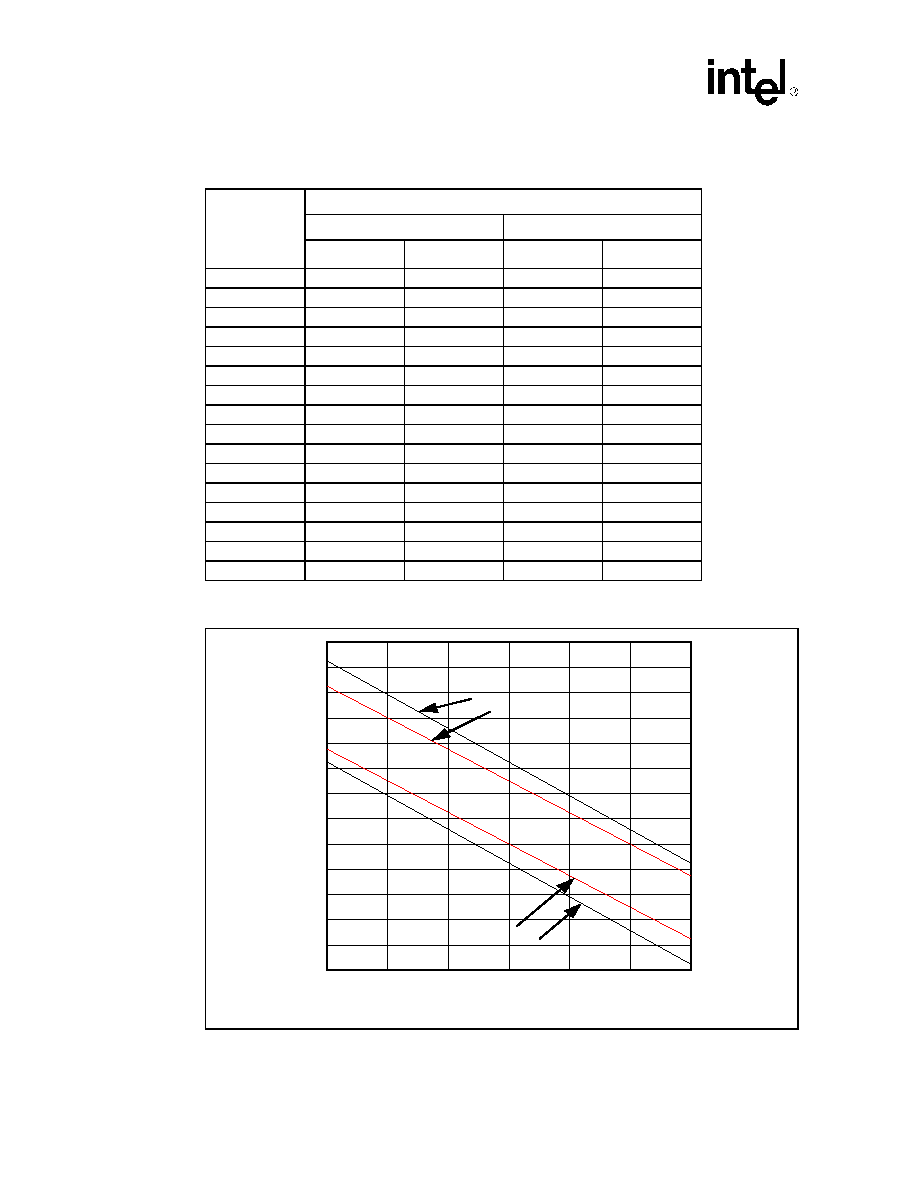
28
Datasheet
Intel
Æ
Celeron
Æ
Processor for PGA370 up to 1.40 GHz on 0.13
µ
Process
Table 9. Vcc Static & Transient Tolerance
Icc (A)
Voltage Deviation from VID Setting (mV)
Static Tolerance
Transient Tolerance
Min
Max
Min
Max
0
15
65
5
85
2
5
55
-5
74
4
-5
45
-15
62
6
-15
35
-25
51
8
-25
25
-35
40
10
-35
15
-45
28
12
-45
5
-55
17
14
-55
-5
-65
6
16
-65
-15
-76
-5
18
-75
-25
-87
-15
20
-85
-35
-98
-25
22
-95
-45
-110
-35
24
-105
-55
-121
-45
26
-115
-65
-132
-55
28
-125
-75
-144
-65
30
-135
-85
-155
-75
Figure 8. Vcc Static and Transient Tolerance
-40
-80
-60
-10 0
-12 0
-14 0
-20
0
2 0
4 0
6 0
0
5
1 0
15
2 0
25
3 0
V
c
c
Droop f
r
om
V
I
D
se
t
t
i
ng (m
V
)
Ic c L o ad (A )
8 0
Tran s ien t M a xim u m L o a d L ine
S ta tic M ax im u m L o ad L in e
Tran s ie n t M in im u m L o a d L in e
S tatic M in im u m L o a d L in e

Datasheet
29
Intel
Æ
Celeron
Æ
Processor for PGA370 up to 1.40 GHz on 0.13
µ
Process
NOTES:
1. Unless otherwise noted, all specifications in this table apply to the
processor at a frequency up to 1.40 GHz
on 0.13 micron.
2. All inputs, outputs, and I/O pins must comply with the signal quality specifications in
Section 3.0
.
3. Minimum and maximum V
TT
are given in
Table 13 on page 30
.
4. (0
V
IN
1.25 V +3%) and (0
V
OUT
1.25 V+3%).
5. Refer to the processor I/O Buffer Models for I/V characteristics.
6. Steady state input voltage must not be above V
SS
+ 1.65 V or below V
TT
≠ 1.65 V.
7. Does not apply to Vcc leakage current due to the presence of on-die RTT.
NOTES:
1. Unless otherwise noted, all specifications in this table apply to the processor
up to 1.40 GHz frequency on
0.13 micron.
2. Parameter measured at 9 mA (for use with TTL inputs).
3. (0
V
IN
1.8 V +10%).
4. (0
V
OUT
1.8 V +10%).
5. For BCLK specifications, refer to
Table 24 on page 41
.
6. (0
V
IN
1.5 V +10%).
7. (0
V
OUT
1.5 V +10%).
8. Applies to non-AGTL signal PWRGOOD.
9. Applies to non-AGTL signal PICCLK.
10.Applies to non-AGTL signals except BCLK, PICCLK, and PWRGOOD.
11.Applies to non-AGTL signal VTT_PWRGD.
12.Vcmos_ref = 2/3 Vcc_cmos1.5, refer to
Table 7 on page 26
.
13.Applies to PICD[1:0] only
Table 10. AGTL Signal Group Levels Specifications
Symbol
Parameter
Min
Max
Unit
Notes
1
V
IL
Input Low Voltage
V
REF
- 0.200
V
6
V
IH
Input High Voltage
V
REF
+ 0.200
V
2, 3, 6
Ron
Buffer On Resistance
16.67
5
I
L
Leakage Current for inputs,
outputs, and I/O
±100
µA
4, 7
Table 11. Non-AGTL Signal Group Levels Specifications
Symbol
Parameter
Min
Max
Unit
Notes
1
V
IL1.2
Input Low Voltage
0.4
V
11
V
IL1.5
Input Low Voltage
≠0.150
Vcmos_ref - 0.300
V
10
V
IL1.8
Input Low Voltage
-0.36
0.36
V
8
V
IL2.0
Input Low Voltage
-0.40
0.40
V
9
V
IH1.2
Input High Voltage
1.03
V
11
V
IH1.5
Input High Voltage
Vcmos_ref +
0.250
V
CC_CMOS1.5 +
10%
V
6, 10, 12
V
IH1.5PICD
Input High Voltage PICD[1:0]
Vcmos_ref +
0.200
2.0
V
12, 13
V
IH1.8
Input High Voltage
1.44
2.16
V
8
V
IH2.0
Input High Voltage
1.60
V
9
R
on
30
2
V
OL
Output Low Voltage
0.30
V
7, 9, All
outputs are
open-drain
I
OL
Output Low Current
10
mA
I
LI
Input Leakage Current
±100
µA
3, 6
I
LO
Output Leakage Current
±100
µA
3, 4, 6, 7

30
Datasheet
Intel
Æ
Celeron
Æ
Processor for PGA370 up to 1.40 GHz on 0.13
µ
Process
2.12
AGTL System Bus Specifications
It is recommended that the AGTL bus be routed in a daisy-chain fashion with termination resistors
to V
TT
. These termination resistors are placed electrically between the ends of the signal traces and
the V
TT
voltage supply. The valid high and low levels are determined by the input buffers using a
reference voltage called V
REF
. Refer to the appropriate platform design guide for more information
Table 13
lists the nominal specification for the AGTL termination voltage (V
TT
). The AGTL
reference voltage (V
REF
) is generated on the system motherboard and should be set to 2/3 V
TT
for
the processor and other AGTL logic. It is important that the baseboard impedance be specified and
held to a ±15% tolerance, and that the intrinsic trace capacitance for the AGTL signal group traces
is known and well-controlled. For more details on the AGTL buffer specification, see the
Intel
Æ
Pentium
Æ
II Processor Developer's Manual and AP-585, Intel
Æ
Pentium
Æ
II Processor
AGTL Guidelines.
NOTES:
1. Unless otherwise noted, all specifications in this table apply to the
processor up to 1.40 GHz frequency.
2. The processor for the PGA370 socket contain AGTL termination resistors on the processor die, except for the
RESET# input.
3. V
TT
must be held to 1.25 V ±9%. It is required that V
TT
be held to 1.25 V ±3% while the processor system bus
is idle (static condition). This is measured at the PGA370 socket pins on the bottom side of the baseboard.
4. Uni-processor platforms require a 56
resistor and dual-processor platforms require a 68
resistor.
Tolerance for on-die Rtt is ±10% (56
, 68
resistors). Rtt is ±15% (100
resistors).
5. V
REF
is generated on the motherboard and should be 2/3 V
TT
±5% nominally. Insure that there is adequate
V
REF
decoupling on the motherboard.
Table 12. 3.3 Volt CMOS Output Signal Group DC Specifications
Symbol
Parameter
Min
Max
Unit
Notes
V
Nominal Voltage
3.45
V
3.3 + 5%
V
OH
Output High Voltage
0.9
V
I
LO
Output Leakage Current
100
µA
Table 13. Processor AGTL Bus Specifications
Symbol
Parameter
Min
Typ
Max
Units
Notes
1,2
V
TT
Bus Termination Voltage
1.1375
1.25
V
3
On-die R
TT
Termination Resistor
50
56
68
115
4
V
REF
Bus Reference Voltage
2/3V
TT
V
5

Datasheet
31
Intel
Æ
Celeron
Æ
Processor for PGA370 up to 1.40 GHz on 0.13
µ
Process
2.13
System Bus Timing Specifications
The processor system bus timings specified in this section are defined at the socket pins on the
bottom of the motherboard. Unless otherwise specified, timings are tested at the processor pins
during manufacturing. Timings at the processor pins are specified by design characterization. See
Section 7.0
for the processor signal definitions.
Table 14
through
Table 21
list the timing specifications associated with the processor system bus.
These specifications are broken into the following categories:
Table 14
contains the system bus
clock specifications for Single-ended clock mode operation and
Table 15
contains the system bus
clock specifications for Differential clock mode operation.
Table 17
contains the AGTL
specifications,
Table 18
contains the CMOS signal group specifications,
Table 19
contains timings
for the reset conditions,
Table 20
and covers APIC bus timing, and
Table 21
covers TAP timing.
All processor system bus timing specifications for the AGTL signal group are relative to the rising
edge of the BCLK input. All AGTL timings are referenced to V
REF
for both `0' and `1' logic levels
unless otherwise specified..
AGTL layout guidelines are also available in the appropriate platform design guide.
Care should be taken to read all notes associated with a particular timing parameter.
7
NOTES:
1. Unless otherwise noted, all specifications in this table apply to the
processor up to 1.40 GHz frequency on
0.13 micron process.
2. Period, jitter, offset and skew measured at 1.25 V.
3. Measured from 0.5 to 2.0 V.
4. CLKREF (BCLK#) = 1.25 V with ±5% DC tolerance. CLKREF must be generated from a stable source. AC
tolerances must be less than -40 dB at 1 MHz.
5. BCLK High Time is measured above 2.0 V.
6. BCLK Low Time is measured below 0.5 V.
Table 14. System Bus Timing Specifications (Single-Ended Clock)
T# Parameter
100 MHz
Unit
Figure
Notes
1,4
Min
Max
T1: BCLK Period - average
10.0
10.15
nS
9
2
T1
abs
: BCLK Period - Instantaneous
minimum
9.75
nS
2
T2: BCLK Period Stability
250
pS
2
T5: BCLK Rise Time
0.4
1.6
nS
10
3
T6: BCLK Fall Time
0.4
1.6
nS
10
3
T3: BCLK High Time
2.5
nS
10
5
T4: BCLK Low Time
2.4
nS
10
6
T7: BCLK Input High
2.2
V
T8: BCLK Input Low
0.3
V

32
Datasheet
Intel
Æ
Celeron
Æ
Processor for PGA370 up to 1.40 GHz on 0.13
µ
Process
1. Unless otherwise noted, all specifications in this table apply to the
processor up to 1.40 GHz frequency on
0.13 micron process.
2. All timings for the AGTL signals are referenced at the rising edge of BCLK and the falling edge of BCLK# at
the processor pin. All AGTL signal timings (address bus, data bus, etc.) are referenced at 1.00 V at the
processor pins.
3. The internal core clock frequency is derived from the processor system bus clock. The system bus clock to
core clock ratio is determined during initialization. Individual processors will only operate at their specified
system bus frequency, 100 MHz.
Table 16
shows the supported ratios for each processor.
4. Due to the difficulty of accurately measuring clock jitter in a system, it is recommended that a clock driver be
used that is designed to meet the period stability specification into a test load of 10 to 20 pF. This should be
measured at adjacent crossing points of BCLK and BCLK# which is defined as the rising edge of BCLK and
the falling edge of BCLK# at the processor pin. The jitter present must be accounted for as a component of
BCLK timing skew between devices.
5. The clock driver's closed loop jitter bandwidth must be set low to allow any PLL-based device to track the
jitter created by the clock driver. The ≠20 dB attenuation point, as measured into a 10 to 20 pF load, should
be less than
500 kHz. This specification may be ensured by design characterization and/or measured with a
spectrum analyzer. See the appropriate clock synthesizer/driver specification for details
6. Measurement taken from differential waveform, defined as BCLK ≠ BCLK#.
7. Rise time is measured from -0.35 to +0.35V and fall time is measured from 0.35 V to -0.35 V.
8. Measured at the socket pin.
Table 15. System Bus Timing Specifications (Differential Clock)
T# Parameter
100 MHz
Unit
Figure
Notes
1,2,6
Min
Max
T1: BCLK Period - average
10.0
10.2
nS
9
3, 4
T1
abs
: BCLK Period - Instantaneous minimum
9.8
nS
3, 4
T2: BCLK Period Stability
200
pS
5
Vcross: Crossing point at 1V Swing
0.51
0.76
V
9
T5: BCLK Rise Time
175
550
pS
10
7, 8
T6: BCLK Fall Time
175
550
pS
10
7, 8
Rise/Fall Time Matching
325
pS
BCLK Duty Cycle
45%
55%
4
Input High Voltage
0.92
1.45
V
Input Low Voltage
-0.2
0.35
V
Rising Edge Ring Back
0.35
V
Falling Edge Ring Back
-0.35
V

Datasheet
33
Intel
Æ
Celeron
Æ
Processor for PGA370 up to 1.40 GHz on 0.13
µ
Process
NOTES:
1. Contact your local Intel representative for the latest information on processor frequencies and/or frequency
multipliers.
2. While other bus ratios are defined, operation at frequencies other than those listed are not supported by the
processor.
3. Individual processors will only operate at their specified system bus frequency; 100 MHz.
4. 1.20 GHz at Vcc
CORE
= 1.475 volts and S-Spec number SL5XS.
NOTES:
1. Unless otherwise noted, all specifications in this table apply to the processor up to 1.40 GHz on 0.13 micron
process.
2. These specifications are tested during manufacturing.
3. All timings for the AGTL signals are referenced to the rising edge of BCLK and the falling edge of BCLK# at
the processor pin. All AGTL signal timings (compatibility signals, etc.) are referenced at 0.80 V at the
processor pins.
4. Valid delay timings for these signals are specified into 50
to 1.25 V, V
REF
at 0.8 V ±2% and with 56
or
68
on-die R
TT
.
5. A minimum of 3 clocks must be guaranteed between two active-to-inactive transitions of TRDY#.
6. RESET# can be asserted (active) asynchronously, but must be deasserted synchronously.
7. Specification is for a minimum 0.40 V swing from V
REF
≠ 200 mV to V
REF
+ 200 mV. This assumes an edge
rate of 0.3V/ns.
8. Specification is for a maximum 0.8 V swing from V
TT
≠ 0.8V to V
TT
. This assumes an edge rate of 3 V/ns.
9. This should be measured after V
CC
CORE
, V
TT
, Vcc
CMOS
, and BCLK (and BCLK#) are stable
10.BREQ signals observe a 1.2 ns minimum setup time.
NOTES:
1. Unless otherwise noted, all specifications in this table apply to the processor up to 1.40 GHz frequency
2. These specifications are tested during manufacturing.
3. These signals may be driven asynchronously.
Table 16. Valid System Bus to Core Frequency Ratios
1, 2, 3
Processor
Core Frequency
BCLK Frequency
(MHz)
Frequency
Multiplier
1.4 GHz
1.40
100
14
1.30
1.30 GHz
100
13
1.20
1.20 GHz
100
12
1.20
4
1.20
4
GHz
100
12
1.1A
1.1A GHz
100
11
1A
1A GHz
100
10
900
900 MHz
100
9
Table 17. System Bus Timing Specifications (AGTL Signal Group)
T# Parameter
Min
Max
Unit
Figure
Notes
1,2,3
T7: AGTL Output Valid Delay
0.40
3.25
ns
11
4
T8: AGTL Input Setup Time
1.30
ns
12
5, 6, 7, 10
T9: AGTL Input Hold Time
1.00
ns
12
8
T10: RESET# Pulse Width
1.00
ms
13
6, 9
Table 18. System Bus Timing Specifications (CMOS Signal Group)
T# Parameter
Min
Max
Unit
Figure
Notes 1
,2,3,4
T14: CMOS Input Pulse Width, except
PWRGOOD
2
BCLKs
11
Active and
Inactive states
T15: PWRGOOD Inactive Pulse Width
10
BCLKs
15
5

34
Datasheet
Intel
Æ
Celeron
Æ
Processor for PGA370 up to 1.40 GHz on 0.13
µ
Process
4. All CMOS outputs shall be asserted for at least 2 system bus clocks.
5. When driven inactive or after V
CC
CORE
, V
TT
, V
CCCMOS
, and BCLK and BCLK# are stable.
NOTE:
1. Unless otherwise noted, all specifications in this table apply to all the processor up to 1.40 GHz frequency.
NOTES:
1. Unless otherwise noted, all specifications in this table apply to the processor up to 1.40 GHz frequency.
2. These specifications are tested during manufacturing.
3. All timings for the APIC I/O signals are referenced to the PICCLK rising edge at 0.9 V at the processor pins.
All APIC I/O signal timings are referenced at 1.0 V at the processor pins.
4. Referenced to PICCLK rising edge.
5. For open drain signals, valid delay is synonymous with float delay.
6. Valid delay timings for these signals are specified into 150
load pulled up to 1.5 V.
Table 19. System Bus Timing Specifications (Reset Conditions)
1
T# Parameter
Min
Max
Unit
Figure
Notes
T16: Reset Configuration Signals
(A[14:5]#, BR0#, INIT#) Setup Time
4
BCLKs
13
Before deassertion
of RESET#
T17: Reset Configuration Signals
(A[14:5]#, BR0#, INIT#) Hold Time
2
20
BCLKs
13
After clock that
deasserts RESET#
Table 20. System Bus Timing Specifications (APIC Clock and APIC I/O)
1, 2, 3
T# Parameter
Min
Max
Unit
Figure
Notes
T21: PICCLK Frequency
2.0
33.3
MHz
T22: PICCLK Period
30.0
500.0
ns
10
T23: PICCLK High Time
10.5
ns
10
@ > 1.60 V
T24: PICCLK Low Time
10.5
ns
10
@ < 0.40 V
T25: PICCLK Rise Time
0.25
3.0
ns
10
(0.40 V ≠ 1.60 V)
T26: PICCLK Fall Time
0.25
3.0
ns
10
(1.60 ≠ 0.40 V)
T27: PICD[1:0] Setup Time
8.0
ns
12
4
T28: PICD[1:0] Hold Time
2.5
ns
12
4
T29a: PICD[1:0] Valid Delay (Rising Edge)
1.5
8.7
ns
11
4, 5, 6
T29b: PICD[1:0] Valid Delay (Falling Edge)
1.5
12.0
ns
10
4, 5, 6

Datasheet
35
Intel
Æ
Celeron
Æ
Processor for PGA370 up to 1.40 GHz on 0.13
µ
Process
NOTES:
1. Unless otherwise noted, all specifications in this table apply to the processor up to 1.40 GHz frequency.
2. All timings for the TAP signals are referenced to the TCK rising edge at 1.0 V at the processor pins. All TAP
signal timings (TMS, TDI, etc.) are referenced at 1.0 V at the processor pins.
3. These specifications are tested during manufacturing, unless otherwise noted.
4. 1 ns can be added to the maximum TCK rise and fall times for every 1 MHz below 16.667 MHz.
5. Referenced to TCK rising edge.
6. Referenced to TCK falling edge.
7. Valid delay timing for this signal is specified to 1.5 V.
8. Non-Test Outputs and Inputs are the normal output or input signals (besides TCK, TRST#, TDI, TDO, and
TMS). These timings correspond to the response of these signals due to TAP operations.
9. During Debug Port operation, use the normal specified timings rather than the TAP signal timings.
10.Not 100% tested. Specified by design characterization.
Table 21. System Bus Timing Specifications (TAP Connection)
T# Parameter
Min
Max
Unit
Figure
Notes
1,2,3
T30: TCK Frequency
16.667
MHz
T31: TCK Period
60.0
ns
10
T32: TCK High Time
25.0
ns
10
Vcmos_ref + 0.200 V, 10
T33: TCK Low Time
25.0
ns
10
Vcmos_ref ≠ 0.200 V, 10
T34: TCK Rise Time
5.0
ns
10
(Vcmos_ref ≠ 0.200 V) ≠
(Vcmos_ref + 0.200 V),
4, 10
T35: TCK Fall Time
5.0
ns
10
(Vcmos_ref + 0.200 V) ≠
(Vcmos_ref ≠ 0.200 V),
4, 10
T36: TRST# Pulse Width
40.0
ns
17
Asynchronous, 10
T37: TDI, TMS Setup Time
5.0
ns
16
5
T38: TDI, TMS Hold Time
14.0
ns
16
5
T39: TDO Valid Delay
1.0
10.0
ns
16
6, 7
T40: TDO Float Delay
25.0
ns
16
6, 7, 10
T41: All Non-Test Outputs Valid Delay
2.0
25.0
ns
16
6, 8, 9
T42: All Non-Test Inputs Setup Time
25.0
ns
16
6, 8, 9, 10
T43: All Non-Test Inputs Setup Time
5.0
ns
16
5, 8, 9
T44: All Non-Test Inputs Hold Time
13.0
ns
16
5, 8, 9
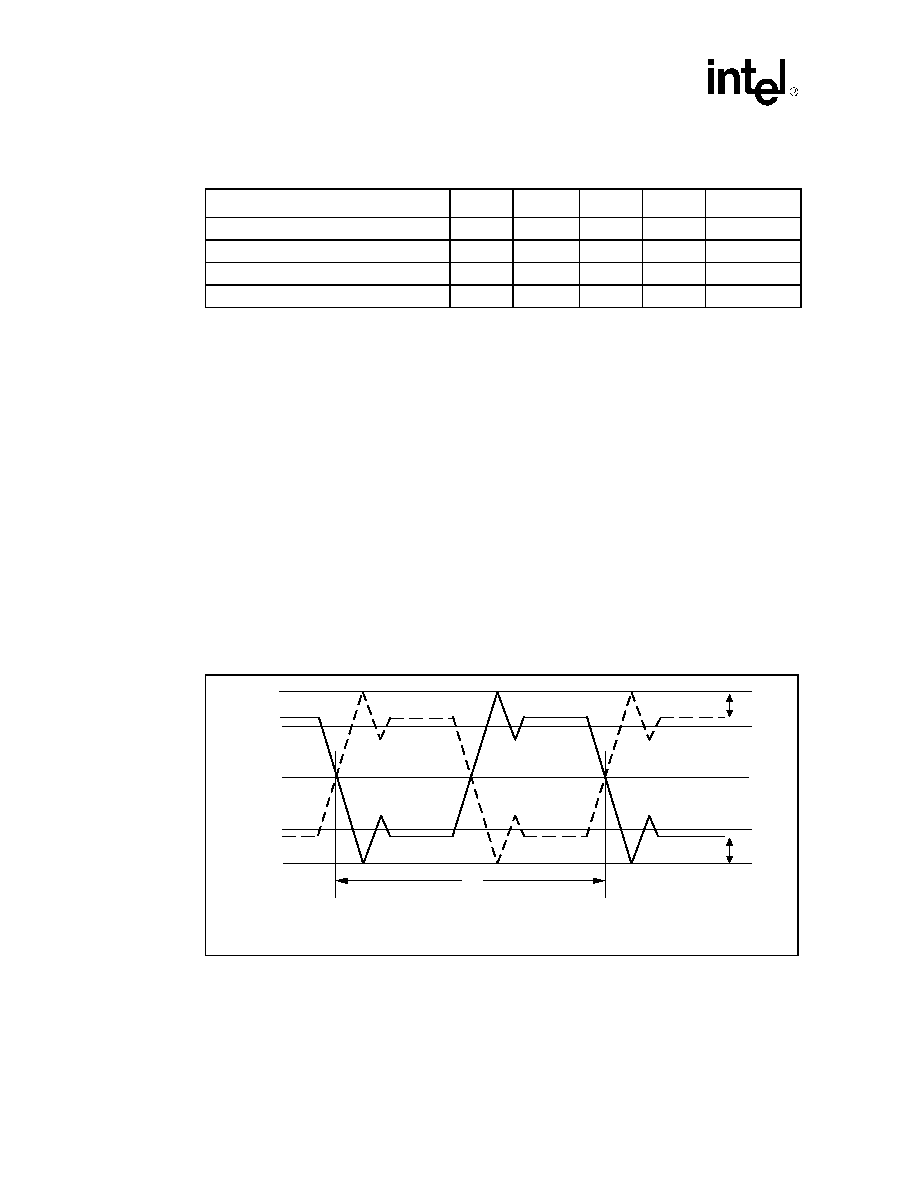
36
Datasheet
Intel
Æ
Celeron
Æ
Processor for PGA370 up to 1.40 GHz on 0.13
µ
Process
NOTES:
1. All signals, during their invalid states, must be guarded against spurious levels from effecting the platform
during processor power-up sequence.
2. Configuration Input signals include: A[14:5], BR0#, INIT#. For timing of these signals, refer to
Table 18
and
Figure 13
.
Notes: For
Figure 9
through
Figure 19
, the following apply:
1.
Figure 9
through
Figure 19
are to be used in conjunction with
Table 14
through
Table 21
.
2. All timings for the AGTL signals at the processor pins are referenced to the rising edge of
BCLK and the falling edge of BCLK# at the crossing point for differential clock mode and to
the rising edge of BCLK at BCLK
VREF
(1.25 V) for single-ended clock mode. All AGTL
signal timings (address bus, data bus, etc.) are referenced at 2/3V
TT
at the processor pins.
3. All timings for the APIC I/O signals at the processor pins are referenced to the PICCLK rising
edge at 0.9 V. All APIC I/O signal timings are referenced at 1.0 V at the processor pins.
4. All timings for the TAP signals at the processor pins are referenced to the TCK rising edge at
1.0 V. All TAP signal timings (TMS, TDI, etc.) are referenced at 1.0 V at the processor pins.
Table 22. Platform Power-On Timings
T# Parameter
Min
Max
Unit
Figure
Notes
2
T45: Valid Time Before VTT_PWRGD
1.0
mS
14
1
T46: Valid Time Before PWRGOOD
2.0
mS
14
1
T47: RESET# Inactive to Valid Outputs
1
BCLK
14
1
T48: RESET# Inactive to Drive Signals
4
BCLK
14
1
Figure 9. Clock Waveform
V ih
B C L K #
B C L K
V il
V c ro s s
T p
T p = T 1 (B C L K P e rio d )
N O T E : S in g le -E n d e d c lo c k u s e s B C L K o n ly ,
D iffe re n tia l c lo c k u s e s B L C K a n d B C L K #
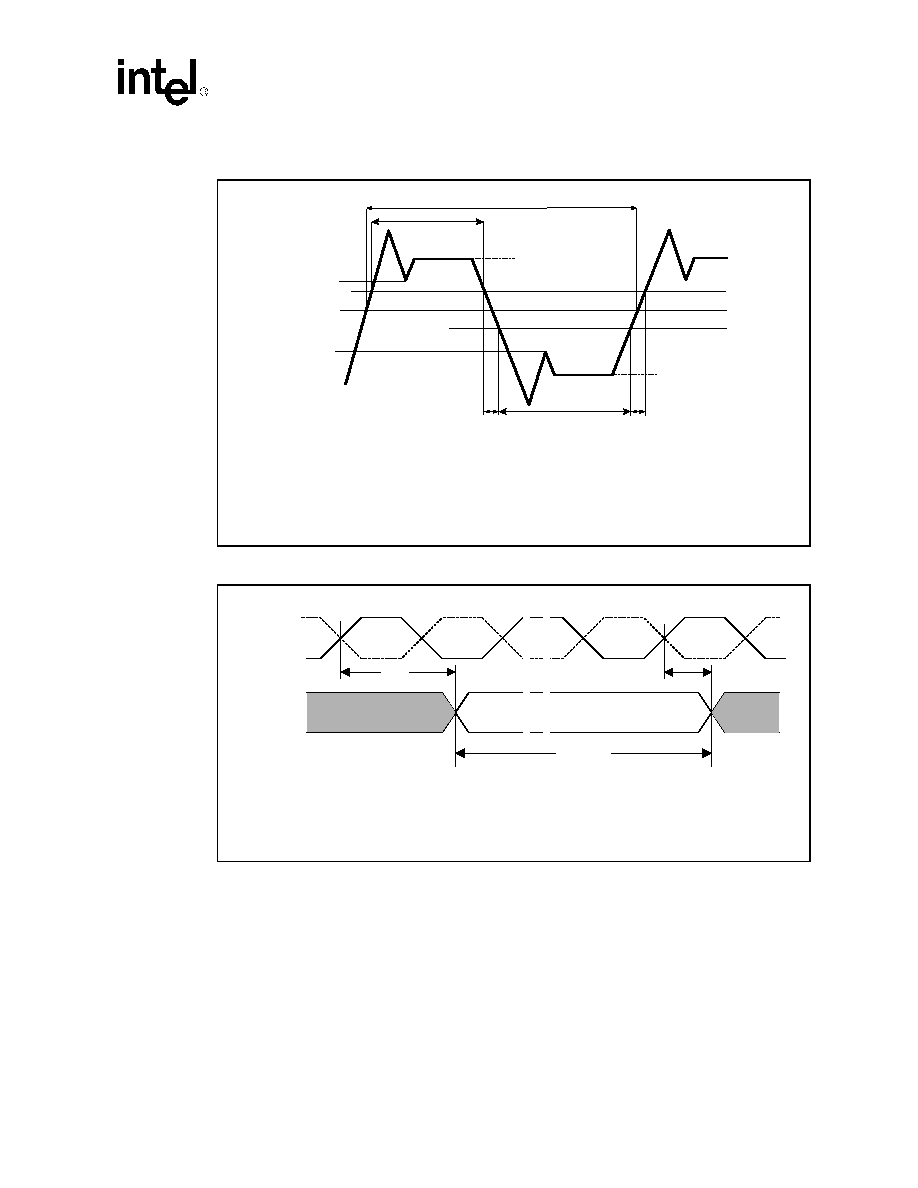
Datasheet
37
Intel
Æ
Celeron
Æ
Processor for PGA370 up to 1.40 GHz on 0.13
µ
Process
Figure 10. BCLK/BCLK#, PICCLK, and TCK Generic Clock Waveform
Figure 11. System Bus Valid Delay Timings
V3
V1
V2
T
p
T
l
T
h
T
r
T
f
Vringback
(rise)
Vringback
(fall)
T
r
= T5, T25, T34, (Rise Tim e)
T
f
= T6, T26, T35, (Fall Tim e)
T
h
= T3, T23, T32, (High Tim e)
T
l
= T4, T24, T33, (Low Tim e)
T
p
= T1, T22, T31 (BC LK, TCK, PIC CLK Period)
V1 = BCLK is referenced to 0.30V (D ifferential Mode), 0.50V (Single-Ended Mode)
TCK is referenced to Vref - 200 m V, PICC LK is referenced to 0.4V.
V2 = BCLK is refernced to 0.9V (Differental Mode), 2.0V (Single-Ended Mode)
TCK is referenced to Vref + 200 m V, PICC LK is refernced to 1.6V
V3 = BCLK and BLCK# crossing point of the rising edge of BLCK and the falling edge of BCLK# (Differential Mode),
BCLK i refereced to 1.25V (Single-Ended Mode), PIC CLK is reference to 1.0V, TCK is referenced to Vcm osref
0V
Vih diff
Vil diff
BCLK
Signal
Valid
Tx
V
Tx
Tpw
Tx = T7, T29a, T29b (Valid Delay)
Tpw = T14, T15 (Pulse Width)
V = Vref for AGTL signal group; Vcmosref for CMOS, APIC and TAP signal groups
BCLK#
Valid
NOTE: Single-Ended clock uses BCLK only,
Differential clock uses BCLK and BCLK#
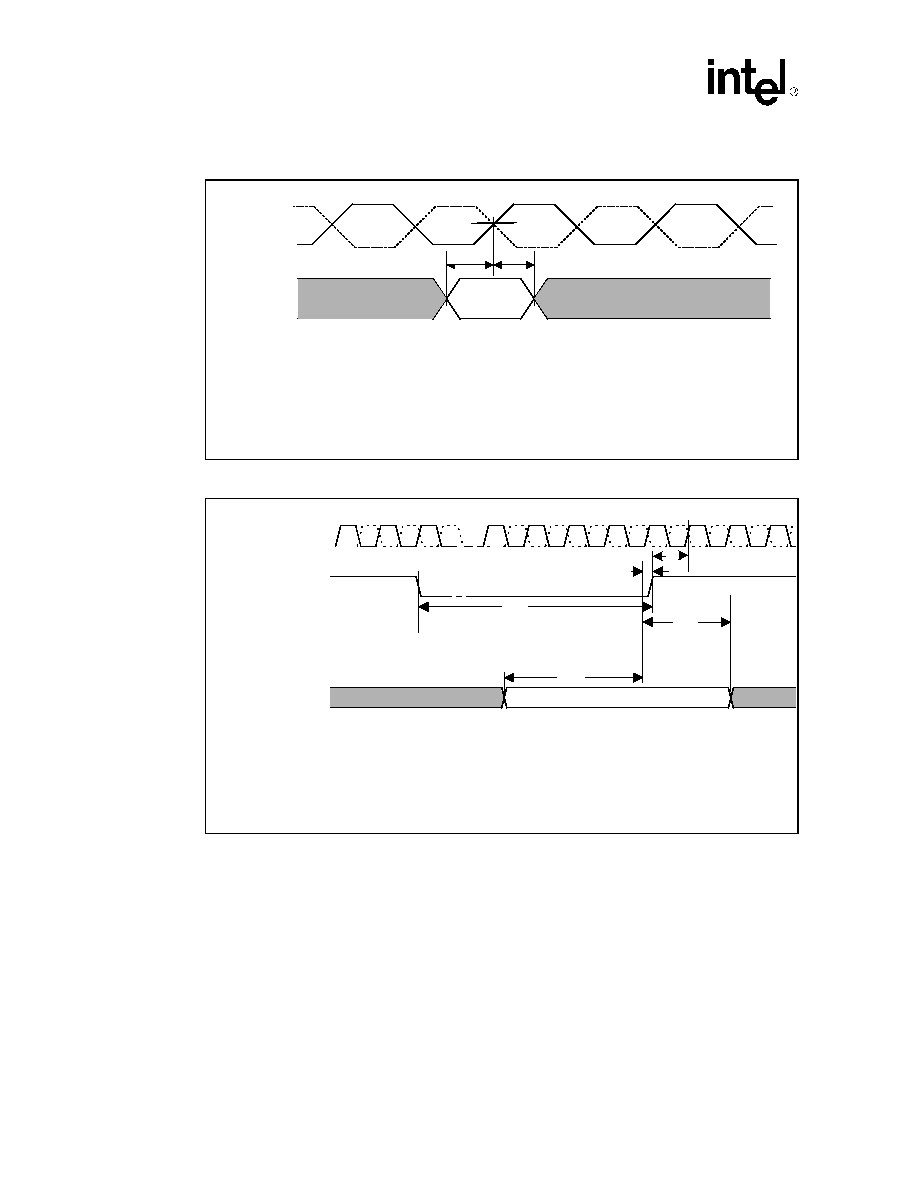
38
Datasheet
Intel
Æ
Celeron
Æ
Processor for PGA370 up to 1.40 GHz on 0.13
µ
Process
Figure 12. System Bus Setup and Hold Timings
Figure 13. System Bus Reset and Configuration Timings
BCLK
Valid
Ts
V
Th
V
Cross
= Crossing point of BLCK and BCLK#
Ts = T8, T27 (Setup Time)
Th = T9, T28 (Hold Time)
V = Vref for AGTL signal group; 0.75V for APIC and TAP signal groups
V
Cross
BCLK#
NOTE: Single-Ended clock uses BCLK only,
Differential clock uses BCLK and BCLK#
T9 = (AGTL+ Input Hold Time)
T8 = (AGTL+ Input Setup Time)
T10 = (RESET# Pulse Width)
T16 = (Reset Configuration Signals (A[14:5]#, BR0#, FLUSH#, INIT#) Setup Time)
T17 = (Reset Configuration Signals (A[14:5]#, BR0#, FLUSH#, INIT#) Hold Time)
BCLK
RESET#
Configuration
(A[14:5]#, BR0#,
FLUSH#, INT#)
BCLK#
Valid
T10
T16
T17
T8
T9
NOTE: Single-Ended clock uses BCLK only,
Differential clock uses BCLK and BCLK#
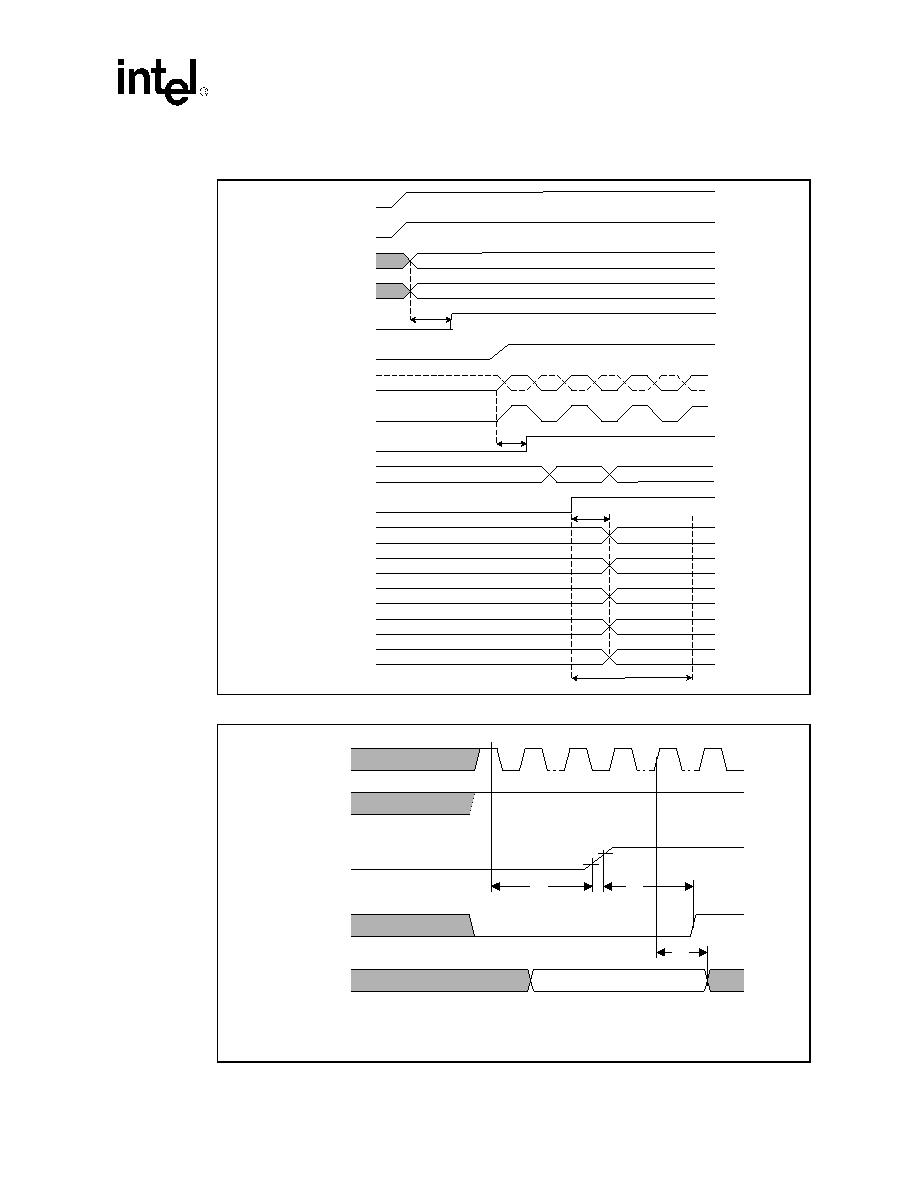
Datasheet
39
Intel
Æ
Celeron
Æ
Processor for PGA370 up to 1.40 GHz on 0.13
µ
Process
Figure 14. Platform Power-On Sequence and Timings
Figure 15. Power-On Reset and Configuration Timings
Vtt, Vref
Vcmosref
Valid
Valid
VID
BSEL[1:0]
T45
VTT_PWRGD
VCC_Core
PICCLK
BCLK#
BCLK
Valid Config
Active
Inactive
Valid
Valid
Valid
Valid
Active
T46
T47
T48
VCC_PWRGD
Configuration Inputs
RESET#
THERMTRIP#
PICD[1:0]
AGTL Outputs
All other CMOS
Outputs
Inactive
All other Inputs
T
a
Valid Ratio
T
C
T
b
PWRGOOD
RESET#
Configuration
(A20M#, IGNNE#,
INTR, NMI)
T
a
= T15 (PWRGOOD Inactive Pulse)
T
b
= T10 (RESET# Pulse Width)
T
c
= T20 (Reset Configuration Signals (A20M#, IGNNE#, LINT[1:0]) Hold Time)
BCLK
V
IL, max
V
IH, min
Vcc
CORE
, V
TT
,
V
REF
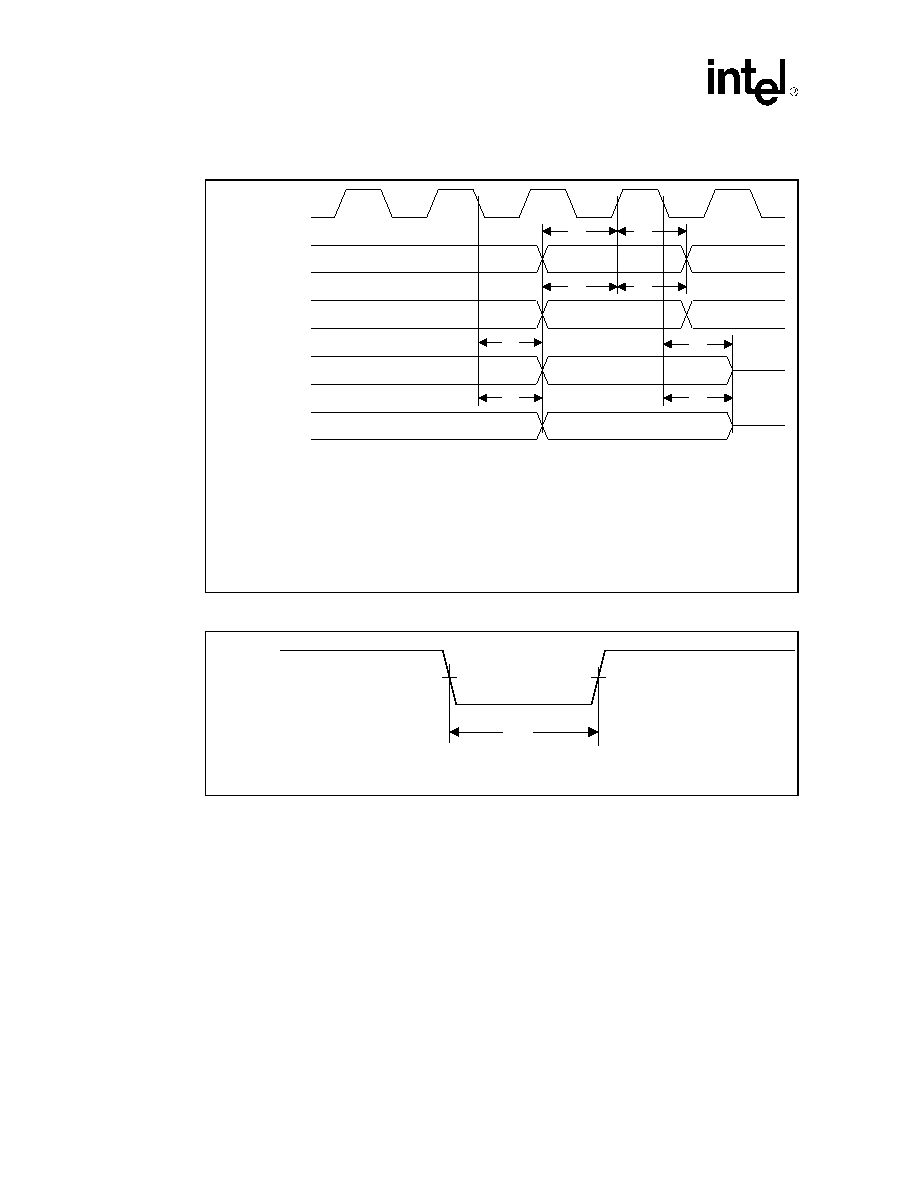
40
Datasheet
Intel
Æ
Celeron
Æ
Processor for PGA370 up to 1.40 GHz on 0.13
µ
Process
Figure 16. Test Timings (TAP Connection)
Figure 17. Test Reset Timings
T
r
= T43 (All Non-Test Inputs Setup Time)
T
s
= T44 (All Non-Test Inputs Hold Time)
T
u
= T40 (TDO Float Delay)
T
v
= T37 (TDI, TMS Setup Time)
T
w
= T38 (TDI, TMS Hold TIme)
T
x
= T39 (TDO Valid Delay)
T
y
= T41 (All Non-Test Outputs Valid Delay)
T
z
= T42 (All Non-Test Outputs Float Time)
T
v
T
w
T
r
T
s
T
u
T
z
T
x
T
y
TCK
TDI, TMS
Input
Signal
TDO
Output
Signal
T36
TRST#
T36 = TRST# Pulse Width
1.00V

Datasheet
41
Intel
Æ
Celeron
Æ
Processor for PGA370 up to 1.40 GHz on 0.13
µ
Process
3.0
Signal Quality Specifications
Signals driven on the processor system bus should meet signal quality specifications to ensure that
the components read data properly and to ensure that incoming signals do not affect the long term
reliability of the component. Specifications are provided for simulation at the processor pins.
Meeting the specifications at the processor pins in
Table 23
,
Table 24
, and
Table 27
ensures that
signal quality effects will not adversely affect processor operation.
3.1
BCLK/BCLK# & PICCLK Signal Quality Specifications and
Measurement Guidelines
Table 24
describes the signal quality specifications at the processor pins for the processor system
bus clock (BCLK/BCLK#) and APIC clock (PICCLK) signals. References made to BCLK signal
quality specifications also applies to BCLK#.
Figure 18
describes the signal quality waveform for
the system bus clock at the processor pins.
NOTES:
1. Unless otherwise noted, all specifications in this table apply to the processor up to 1.40 GHz frequency.
2. The rising and falling edge ringback voltage specified is the minimum (rising) or maximum (falling) absolute
voltage the BCLK/BCLK# and PICCLK signals can dip back to after passing the V
IH
(rising) or V
IL
(falling)
voltage limits. This specification is an absolute value.
Table 23. BCLK (Single-Ended Clock Mode) Signal Quality Specifications for Simulation at
the Processor Pins
T# Parameter
Min
Nom
Max
Unit
Figure
Notes
1
V1: BCLK V
IL
0.3
V
18
V2: BCLK V
IH
2.2
V
18
V3: BCLK Absolute Voltage Range
-0.5
3.1
V
18
V4: BCLK Rising Edge Ringback
2.0
V
18
2
V5: BCLK Falling Edge Ringback
0.5
V
18
2
Table 24. BCLK/BCLK# (Differential Clock Mode) and PICCLK Signal Quality Specifications
for Simulation at the Processor Pins
T# Parameter
Min
Nom
Max
Unit
Figure
Notes
1
V1: BCLK V
IL
-0.2
0.35
V
18
V1: PICCLK V
IL
0.40
V
18
V2: BCLK V
IH
0.92
1.45
V
18
V2 PICCLK V
IH
1.60
V
18
V3: BCLK Absolute Voltage Range
-0.2
1.45
V
18
V3: PICCLK Absolute Voltage Range
-0.4
2.4
V
18
V4: BCLK Rising Edge Ringback
0.35
V
18
2
V4: PICCLK Rising Edge Ringback
1.60
V
18
2
V5: BCLK Falling Edge Ringback
-0.35
V
18
2
V5: PICCLK Falling Edge Ringback
0.40
V
18
2
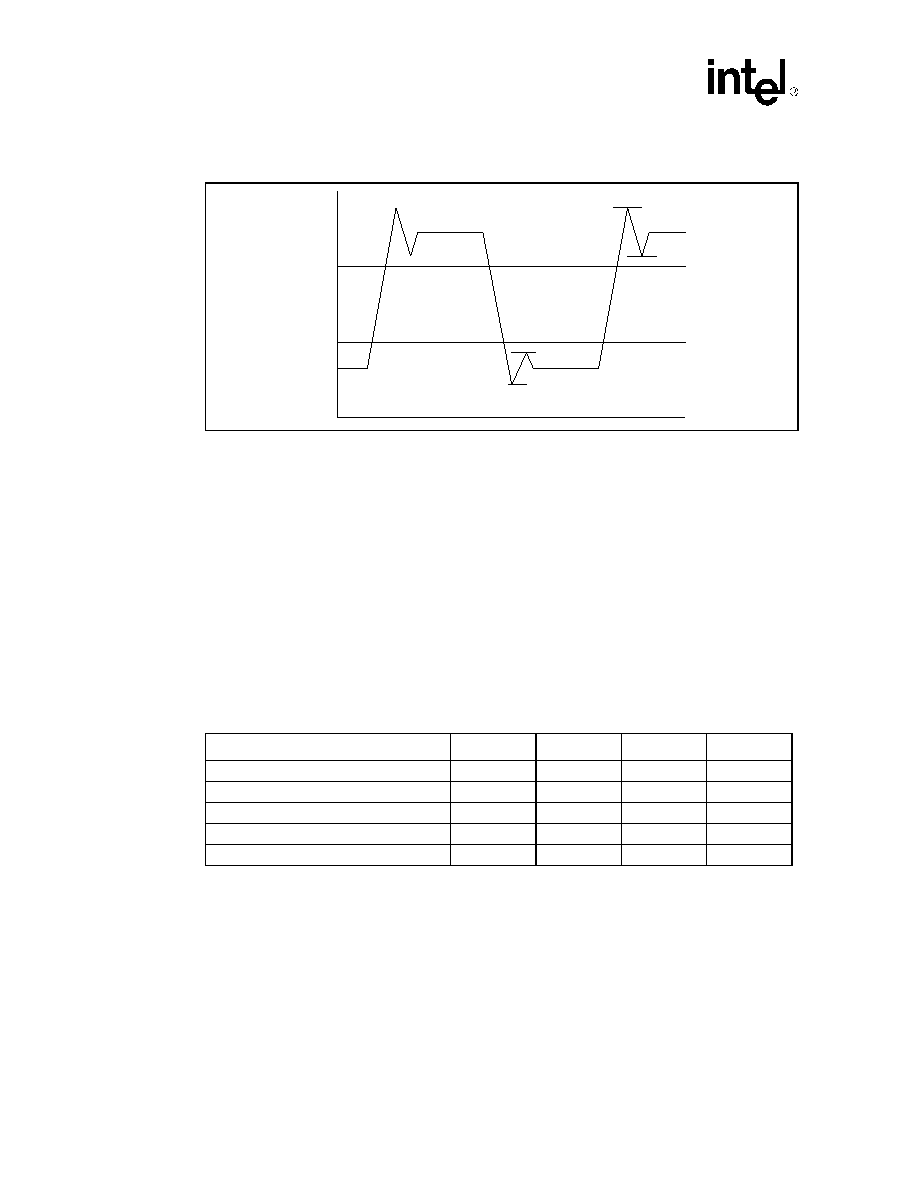
42
Datasheet
Intel
Æ
Celeron
Æ
Processor for PGA370 up to 1.40 GHz on 0.13
µ
Process
3.2
AGTL Signal Quality Specifications and Measurement
Guidelines
Many scenarios have been simulated to generate a set of AGTL layout guidelines which are
available in the appropriate platform design guide. Refer to the Intel
Æ
Pentium
Æ
II Processor
Developer's Manual (Order Number 243502) for the AGTL buffer specification.
Table 25
provides the AGTL signal quality specifications for the processor for use in simulating
signal quality at the processor pins.
The processor maximum allowable overshoot and undershoot specifications for a given duration of
time are detailed in
Table 24
through
Table 26
.
Figure 19
shows the AGTL ringback tolerance and
Figure 20
shows the overshoot/undershoot waveform.
NOTES:
1. Unless otherwise noted, all specifications in this table apply to the processor up to 1.40 GHz frequency.
2. Specifications are for the edge rate of 0.3 ≠ 3 V/ns. See
Figure 19
for the generic waveform.
3. All values specified by design characterization.
4. See
Table 24
for maximum allowable overshoot.
5. Ringback between V
REF
+ 100 mV and V
REF
+ 200 mV or V
REF
≠ 300 mV and V
REF
≠ 100 mVs requires the
flight time measurements to be adjusted as described in the Intel AGTL Specifications. Ringback below
V
REF
+ 100 mV or above V
REF
≠ 100 mV is not supported.
6. Intel recommends simulations not exceed a ringback value of V
REF
±200 mV to allow margin for other
sources of system noise.
7. A negative value for
indicates that the amplitude of ringback is above V
REF
. (i.e.,
= -100 mV specifies the
signal cannot ringback below V
REF
+ 100 mV).
8.
and
: are measured relative to V
REF
.
: is measured relative to V
REF
+ 200 mV.
Figure 18. BCLK/BCLK#, PICCLK Generic Clock Waveform at the Processor Pins
V2
V1
V3
V3
V4
V5
Table 25. AGTL Signal Groups Ringback Tolerance Specifications at the Processor Pins
T# Parameter
Min
Unit
Figure
Notes
1,2,3
: Overshoot
100
mV
19
4, 8
: Minimum Time at High
0.50
ns
19
: Amplitude of Ringback
±200
mV
19
5, 6, 7, 8
: Final Settling Voltage
200
mV
19
8
: Duration of Squarewave Ringback
N/A
ns
19

Datasheet
43
Intel
Æ
Celeron
Æ
Processor for PGA370 up to 1.40 GHz on 0.13
µ
Process
3.2.1
Overshoot/Undershoot Guidelines
Overshoot (or undershoot) is the absolute value of the maximum voltage above the nominal high
voltage or below V
SS
. The overshoot guideline limits transitions beyond V
CC
or V
SS
due to the fast
signal edge rates. The processor can be damaged by repeated overshoot events on 1.25 V or 2.5 V
tolerant buffers if the charge is large enough (i.e., if the overshoot is great enough). Determining
the impact of an overshoot/undershoot condition requires knowledge of the magnitude, the pulse
direction and the activity factor (AF). Permanent damage to the processor is the likely result of
excessive overshoot/undershoot. Violating the overshoot/undershoot guideline will also make
satisfying the ringback specification difficult.
When performing simulations to determine impact of overshoot and undershoot, ESD diodes must
be properly characterized. ESD protection diodes do not act as voltage clamps and will not provide
overshoot or undershoot protection. ESD diodes modeled within Intel I/O Buffer models do not
clamp undershoot or overshoot and will yield correct simulation results. If other I/O buffer models
are being used to characterize the processor performance, care must be taken to ensure that ESD
models do not clamp extreme voltage levels. Intel I/O Buffer models also contain I/O capacitance
characterization. Therefore, removing the ESD diodes from an I/O Buffer model will impact results
and may yield excessive overshoot/undershoot.
Figure 19. Low to High AGTL Receiver Ringback Tolerance
i b k
t l
0.7V Clk Ref
Clock
Time
V
start
V
REF
- 0.2
V
REF
V
REF
+ 0.2
Note: High to low case is analogous

44
Datasheet
Intel
Æ
Celeron
Æ
Processor for PGA370 up to 1.40 GHz on 0.13
µ
Process
3.2.2
Overshoot/Undershoot Magnitude
Magnitude describes the maximum potential difference between a signal and its voltage reference
level, V
SS
(overshoot) and V
TT
(undershoot). While overshoot can be measured relative to V
SS
using one probe (probe to signal and GND lead to V
SS
), undershoot must be measured relative to
V
TT
. This could be accomplished by simultaneously measuring the V
TT
plane while measuring the
signal undershoot. Today's oscilloscopes can easily calculate the true undershoot waveform. The
true undershoot waveform can also be obtained with the following oscilloscope data file analysis:
Converted Undershoot Waveform = V
TT
- Signal_measured
Note: The converted undershoot waveform appears as a positive (overshoot) signal.
Note: Overshoot (rising edge) and undershoot (falling edge) conditions are separate and their impact
must be determined independently.
After the true waveform conversion, the undershoot/overshoot specifications shown in
Table 26
through
Table 29
can be applied to the converted undershoot waveform using the same magnitude
and pulse duration specifications used with an overshoot waveform.
Overshoot/undershoot magnitude levels must observe the Absolute Maximum Specifications listed
in
Table 26
through
Table 29
. These specifications must not be violated at any time regardless of
bus activity or system state. Within these specifications are threshold levels that define different
allowed pulse durations. Provided that the magnitude of the overshoot/undershoot is within the
Absolute Maximum Specifications (1.78 V AGTL, 2.08 V CMOS), the pulse magnitude, duration
and activity factor must all be used to determine if the overshoot/undershoot pulse is within
specifications.
3.2.3
Overshoot/Undershoot Pulse Duration
Pulse duration describes the total time an overshoot/undershoot event exceeds the overshoot/
undershoot reference voltage (Vos_ref = 1.32 V AGTL, 1.80 V CMOS). The total time could
encompass several oscillations above the reference voltage. Multiple overshoot/undershoot pulses
within a single overshoot/undershoot event may need to be measured to determine the total pulse
duration.
Note: Oscillations below the reference voltage can not be subtracted from the total overshoot/undershoot
pulse duration.
Note: Multiple Overshoot/Undershoot events occurring within the same clock cycle must be considered
together as one event. Using the worst case Overshoot/Undershoot Magnitude, sum together the
individual Pulse Durations to determine the total Overshoot/Undershoot Pulse Duration for that
total event.
3.2.4
Activity Factor
Activity Factor (AF) describes the frequency of overshoot (or undershoot) occurrence relative to a
clock. Since the highest frequency of assertion of an AGTL or a CMOS signal is every other clock,
an AF = 1 indicates that the specific overshoot (or undershoot) waveform occurs EVERY OTHER
clock cycle. Thus, an AF = 0.01 indicates that the specific overshoot (or undershoot) waveform
occurs one time in every 200 clock cycles.
The specifications provided in
Table 26
through
Table 29
show the Maximum Pulse Duration
allowed for a given Overshoot/Undershoot Magnitude at a specific Activity Factor. Each Table
entry is independent of all others, meaning that the Pulse Duration reflects the existence of
overshoot/undershoot events of that magnitude ONLY. A platform with an overshoot/undershoot

Datasheet
45
Intel
Æ
Celeron
Æ
Processor for PGA370 up to 1.40 GHz on 0.13
µ
Process
that just meets the pulse duration for a specific magnitude where the AF < 1, means that there can
be NO other overshoot/undershoot events, even of lesser magnitude (note that if AF = 1, then the
event occurs at all times and no other events can occur).
Note: Activity factor for AGTL signals is referenced to system bus clock frequency.
Note: Activity factor for CMOS signals is referenced to PICCLK frequency.
3.2.5
Reading Overshoot/Undershoot Specification Tables
The overshoot/undershoot specification for the processor is not a simple single value. Instead,
many factors are needed to determine what the over/undershoot specification is. In addition to the
magnitude of the overshoot, the following parameters must also be known: the junction
temperature the processor will be operating at, the width of the overshoot (as measured above
TBD V) and the Activity Factor (AF). To determine the allowed overshoot for a particular
overshoot event, the following must be done:
1. Determine the signal group that particular signal falls into. If the signal is an AGTL signal
operating with a 100 MHz system bus, use
Table 27
(100 MHz AGTL signal group). If the
signal is a CMOS signal, use
Table 28
(33 MHz CMOS signal group).
2. Determine the maximum case temperature (Tcase) for the range of processors that the system
will support (65
o
C).
3. Determine the Magnitude of the overshoot (relative to V
SS
)
4. Determine the Activity Factor (how often does this overshoot occur?)
5. From the appropriate Specification table, read off the Maximum Pulse Duration (in ns)
allowed.
6. Compare the specified Maximum Pulse Duration to the signal being measured. If the Pulse
Duration measured is less than the Pulse Duration shown in the table, then the signal meets the
specifications.
The above procedure is similar for undershoots after the undershoot waveform has been converted
to look like an overshoot. Undershoot events must be analyzed separately from Overshoot events
as they are mutually exclusive.
Below is an example showing how the maximum pulse duration is determined for a given
waveform.
Given the above parameters, and using
Table 27
(65
o
C/AF = 0.1 column) the maximum allowed
pulse duration is 7.5 ns. Since the measure pulse duration is 7.5 ns, this particular overshoot event
passes the overshoot specifications, although this doesn't guarantee that the combined overshoot/
undershoot events meet the specifications.
Table 26. Example Platform Information
Required Information
Maximum Platform Support
Notes
PSB Signal Group
100 MHz AGTL
Max Tcase
72 ∞C
Overshoot Magnitude
1.78 V
Measured Value
Activity Factor (AF)
0.1
Measured overshoot occurs on
average every 20 clocks

46
Datasheet
Intel
Æ
Celeron
Æ
Processor for PGA370 up to 1.40 GHz on 0.13
µ
Process
3.2.6
Determining if a System Meets the Overshoot/Undershoot
Specifications
The overshoot/undershoot specifications listed in the following tables specify the allowable
overshoot/undershoot for a single overshoot/undershoot event. However most systems will have
multiple overshoot and/or undershoot events that each have their own set of parameters (duration,
AF and magnitude). While each overshoot on its own may meet the overshoot specification, when
you add the total impact of all overshoot events, the system may fail. A guideline to ensure a
system passes the overshoot and undershoot specifications is shown below. It is important to meet
these guidelines; otherwise, contact your Intel field representative.
1. Insure no AGTL signal ever exceeds 1.78 V and no CMOS signal ever exceeds 2.08 V.
OR
2. If only one overshoot/undershoot event magnitude occurs, ensure it meets the over/undershoot
specifications in the following tables
OR
3. If multiple overshoots and/or multiple undershoots occur, measure the worst case pulse
duration for each magnitude and compare the results against the AF = 1 specifications. If all of
these worst case overshoot or undershoot events meet the specifications (measured time <
specifications) in the table (where AF=1), then the system passes.
The following notes apply to
Table 26
through
Table 29
.
NOTES:
1. Overshoot/Undershoot Magnitude = 1.78 V(AGTL), 2.08 V(CMOS) is an Absolute value and
should never be exceeded
2. Overshoot is measured relative to V
SS
.
3. Undershoot is measured relative to V
TT
4. Overshoot/Undershoot Pulse Duration is measured relative to 1.32 V for AGTL and 1.80 V for
CMOS.
5. Rinbacks below V
TT
can not be subtracted from Overshoots/Undershoots
6. Lesser Undershoot does not allocate longer or larger Overshoot
7. OEM's are encouraged to follow Intel provided layout guidelines. Consult the layout guidelines
provided in the specific platform design guide.
8. All values specified by design characterization
Notes: 1. Measurements taken at the processor socket pins on the solder-side of the motherboard.
2. Overshoot/Undershoot Magnitude = 1.78 V is an absolute value and should never be exceeded.
3. BCLK Period = 10.0 ns.
Table 27. 100 MHz AGTL Signal Group Overshoot/Undershoot Tolerance
1, 2, 3
Overshoot/
Undershoot
Magnitude
(V)
Maximum Pulse
Duration at
Tcase = 60 ∞C (ns)
Maximum Pulse
Duration at
Tcase = 69 ∞C (ns)
Maximum Pulse
Duration at
Tcase = 71 ∞C (ns)
Maximum Pulse
Duration at
Tcase = 72 ∞C (ns)
AF =
0.01
AF =
0.1
AF =
1
AF =
0.01
AF =
0.1
AF =
1
AF =
0.01
AF =
0.1
AF =
1
AF =
0.01
AF =
0.1
AF =
1
1.78
20
1.5
0.153
8.7
0.87
0.087
6
0.6
0.06
6
0.6
0.06
1.73
20
3.1
0.31
15
2.0
0.20
13
1.3
0.13
12
1.2
0.12
1.68
20
6.8
0.68
15
4.6
0.46
20
2.8
0.28
20
2.7
0.27
1.63
20
14
1.42
15
10
1.0
20
6.0
0.6
20
5.7
0.57
1.58
20
15
2.95
20
15
2.3
20
12.7
1.27
20
12
1.2
1.53
20
15
6.2
20
15
5.0
20
20
2.65
20
20
2.46
1.48
20
15
13.2
20
20
15
20
20
5.45
20
20
5.10
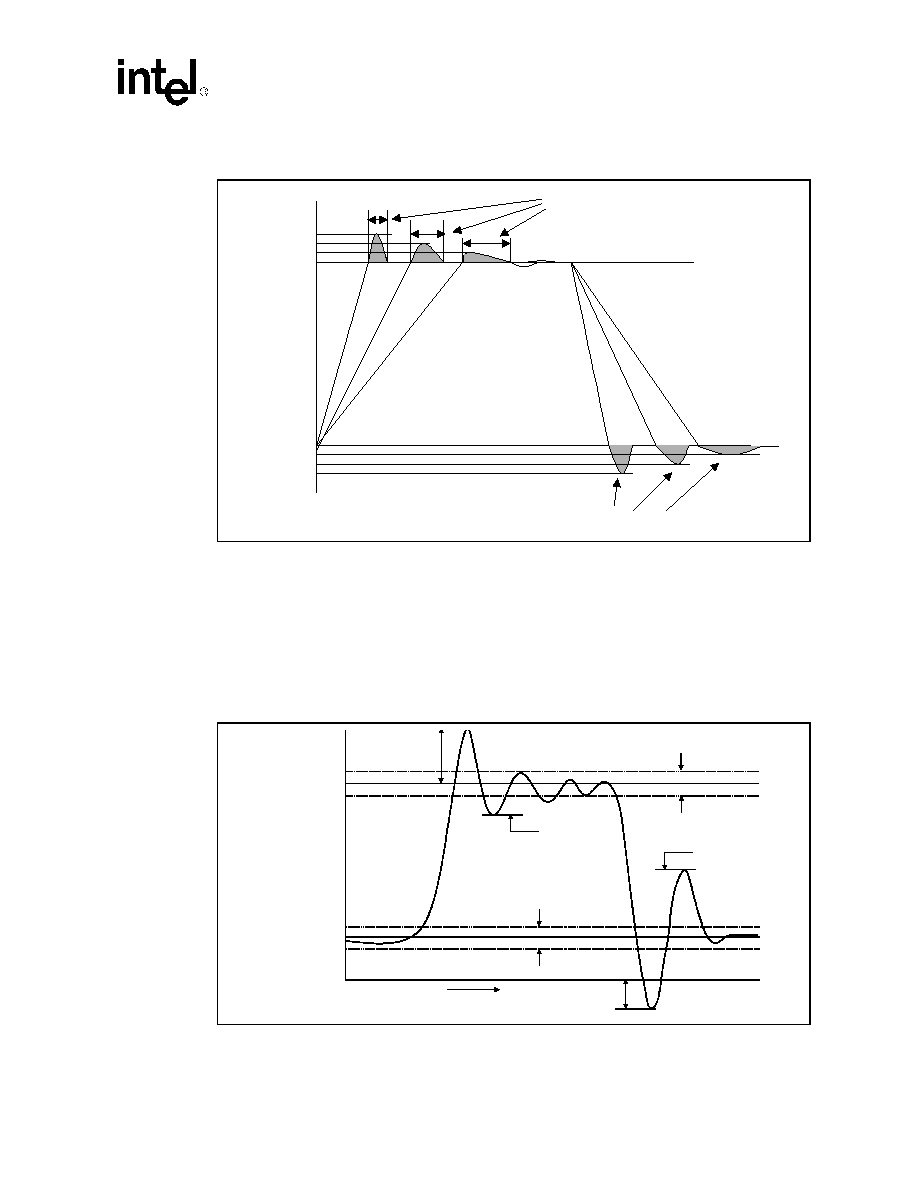
Datasheet
47
Intel
Æ
Celeron
Æ
Processor for PGA370 up to 1.40 GHz on 0.13
µ
Process
3.3
Non-AGTL Signal Quality Specifications and Measurement
Guidelines
There are three signal quality parameters defined for non-AGTL signals: overshoot/undershoot,
ringback, and settling limit. All three signal quality parameters are shown in
Figure 21
for the non-
AGTL signal group.
NOTE:
1. V
HI
= 1.80 V for all non-AGTL signals except for BCLK, PICCLK, and PWRGOOD. V
HI
=2.0 V for PICCLK,
and V
HI
=1.8 V for PWRGOOD. BCLK and PICCLK signal quality is detailed in
Section 3.1
.
Figure 20. Maximum Acceptable AGTL Overshoot/Undershoot Waveform
Vos_ref
1.78 V Max
1.32 V
Vss
Time dependent Overshoot
Time dependent Undershoot
-0.46 V Min
a
b
c
a
b
c
0.1 ns
0.3 ns
1 ns
0.1 ns
0.3 ns
1 ns
1.47 V
1.62 V
-0.15 V
-0.30 V
Figure 21. Non-AGTL Overshoot/Undershoot, Settling Limit, and Ringback
1
Undershoot
Overshoot
Settling Limit
Settling Limit
Rising-Edge
Ringback
Falling-Edge
Ringback
V
LO
V
SS
Time
V
HI

48
Datasheet
Intel
Æ
Celeron
Æ
Processor for PGA370 up to 1.40 GHz on 0.13
µ
Process
3.3.1
Overshoot/Undershoot Guidelines
Overshoot (or undershoot) is the absolute value of the maximum voltage above the nominal high
voltage or below V
SS
. The overshoot guideline limits transitions beyond V
CC
or V
SS
due to the fast
signal edge rates (see
Figure 21
for non-AGTL signals). The processor can be damaged by repeated
overshoot events on 1.25 V or 1.8 V tolerant buffers if the charge is large enough (i.e., if the
overshoot is great enough). Permanent damage to the processor is the likely result of excessive
overshoot/undershoot. Violating the overshoot/undershoot guideline will also make satisfying the
ringback specification difficult. The overshoot/undershoot guideline is 0.3 V and assumes the
absence of diodes on the input. These guidelines should be verified in simulations without the on-
chip ESD protection diodes present because the diodes will begin clamping the 1.25 V and 2.5 V
tolerant signals beginning at approximately 0.7 V above the appropriate supply and 0.7 V below
V
SS
. If signals are not reaching the clamping voltage, this will not be an issue. A system should not
rely on the diodes for overshoot/undershoot protection as this will negatively affect the life of the
components and make meeting the ringback specification very difficult.
Note: The undershoot guideline limits transitions exactly as described for the ATGL signals. See
Figure 20
.
3.3.2
Ringback Specification
Ringback refers to the amount of reflection seen after a signal has switched. The ringback
specification is the voltage that the signal rings back to after achieving its maximum absolute
value. See
Figure 21
for an illustration of ringback. Excessive ringback can cause false signal
detection or extend the propagation delay. The ringback specification applies to the input pin of
each receiving agent. Violations of the signal ringback specification are not allowed under any
circumstances for non-AGTL signals.
Ringback can be simulated with or without the input protection diodes that can be added to the
input buffer model. However, signals that reach the clamping voltage should be evaluated further.
See
Table 29
for the signal ringback specifications for non-AGTL signals for simulations at the
processor pins.
Table 28. 33 MHz CMOS Signal Group Overshoot/Undershoot Tolerance
Overshoot/
Undershoot
Magnitude
(V)
Maximum Pulse Duration at
Tcase = 69 ∞C (ns)
Maximum Pulse Duration at
Tcase = 71 ∞C (ns)
Maximum Pulse Duration at
Tcase = 72 ∞C (ns)
AF =
0.01
AF =
0.1
AF =
1
AF =
0.01
AF =
0.1
AF =
1
AF =
0.01
AF =
0.1
AF =
1
2.38
35
3.5
0.35
19
1.9
0.19
17
1.7
0.17
2.33
60
8.0
0.8
40
4.0
0.40
36
3.6
0.36
2.28
60
18
1.8
60
8.0
0.80
60
7.7
0.77
2.23
60
41
4.1
60
18
1.80
60
16
1.60
2.18
60
60
9.0
60
37.5
3.75
60
34
3.42
2.13
60
60
21
60
60
8.00
60
60
7.12
2.08
60
60
60
60
60
16.00
60
60
14.5

Datasheet
49
Intel
Æ
Celeron
Æ
Processor for PGA370 up to 1.40 GHz on 0.13
µ
Process
NOTES:
1. Unless otherwise noted, all specifications in this table apply to the processor up to 1.40 GHz frequency.
2. Non-AGTL signals except PWRGOOD.
3.3.3
Settling Limit Guideline
Settling limit defines the maximum amount of ringing at the receiving pin that a signal must reach
before its next transition. The amount allowed is 10% of the total signal swing (V
HI
≠
V
LO
) above
and below its final value. A signal should be within the settling limits of its final value, when either
in its high state or low state, before it transitions again.
Signals that are not within their settling limit before transitioning are at risk of unwanted
oscillations which could jeopardize signal integrity. Simulations to verify settling limit may be
done either with or without the input protection diodes present. Violation of the settling limit
guideline is acceptable if simulations of 5 to 10 successive transitions do not show the amplitude of
the ringing increasing in the subsequent transitions.
3.4
VTT_PWRGD Signal Quality Specification
The VTT_PWRGD signal is an input to the processor used to determine that the V
TT
power is
stable and the VID and BSEL signals should be driven to their final state by the processor. To
ensure the processor correctly reads this signal, it must meet the following requirement while the
signal is in its transition region of 300 mV to 900 mV. Also, VTT_PWRGD should only enter the
transition region once, after V
TT
is at nominal values, for the assertion of the signal.
Amount of noise (glitch) < 100 mV
In addition, the VTT_PWRGD signal should have a reasonable transition time through the
transition region. A sharp edge on the signal transition will minimize the chance of noise causing a
glitch on this signal. Intel recommends the following transition time for the VTT_PWRGD signal.
Transition time (300 mV to 900 mV)
100 us
3.4.1
Transition region
The transition region covered by this requirement is 300 mV to 900 mV. Once the VTT_PWRGD
signal is in that voltage range, the processor is more sensitive to noise which may be present on the
signal. The transition region when the signal first crosses the 300 mV voltage level and continues
until the last time it is below 900 mV.
Table 29. Signal Ringback Specifications for Non-AGTL Signal Simulation at the Processor
Pins
Input Signal Group
Transition
Maximum Ringback
(with Input Diodes Present)
Unit
Figure
Non-AGTL Signals
2
0
1
Vcmos_ref + 0.200
V
21
Non-AGTL Signals
2
1
0
Vcmos_ref - 0.300
V
21
PWRGOOD
0
1
1.44
V
21
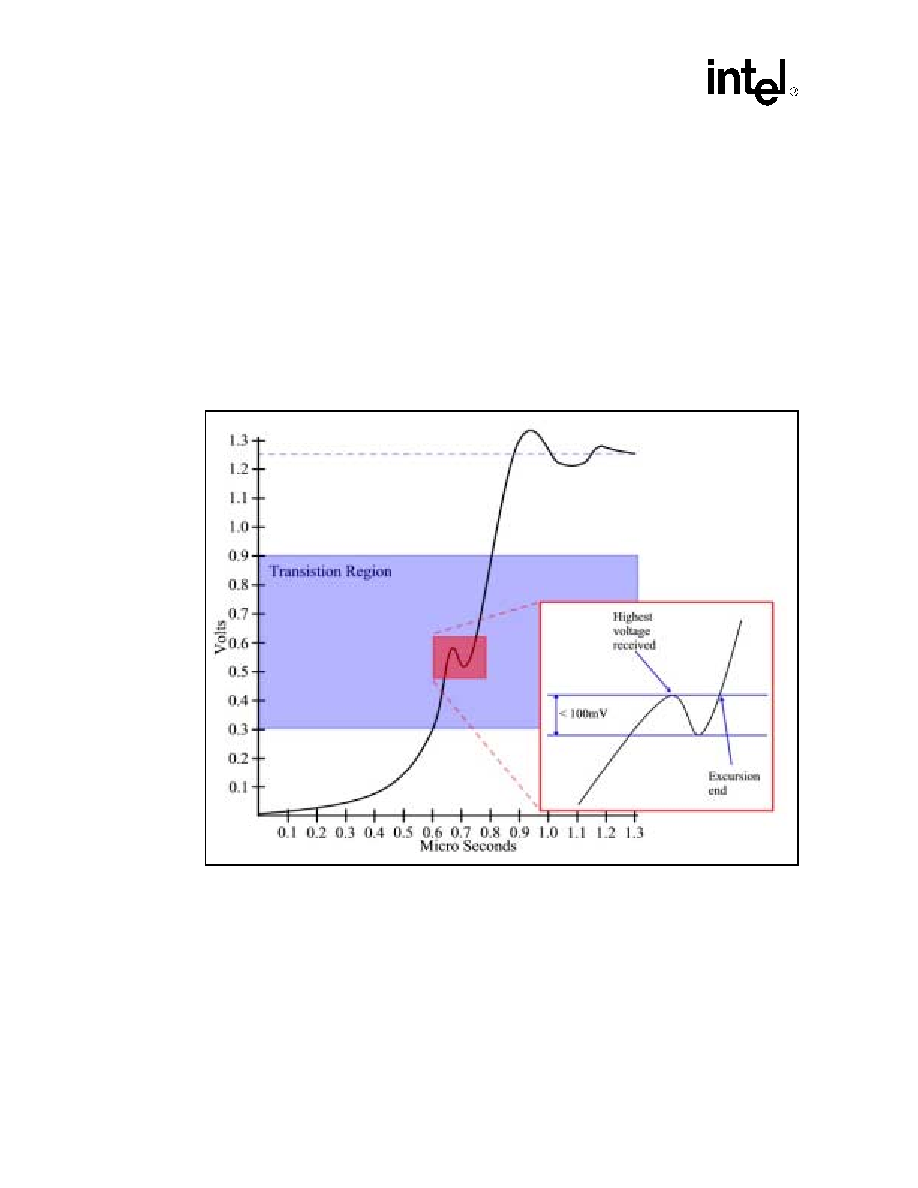
50
Datasheet
Intel
Æ
Celeron
Æ
Processor for PGA370 up to 1.40 GHz on 0.13
µ
Process
3.4.2
Transition time
The transition time is defined as the time the signal takes to move through the transition region. A
100 microsecond transition time will ensure that the processor receives a good transition edge.
3.4.3
Noise
The signal quality of the VTT_PWRGD signal is critical to the correct operation of the processor.
Every effort should be made to ensure this signal is monotonic in the transition region. If noise or
glitches are present on this signal, it must be kept to less than 100 mV of a voltage drop from the
highest voltage level received to that point. This glitch must remain less than 100 mV until the
excursion ends by the voltage returning to the highest voltage previously received. See
Figure 22
for an example graph of this situation and requirements.
Figure 22. Noise Estimation

Datasheet
51
Intel
Æ
Celeron
Æ
Processor for PGA370 up to 1.40 GHz on 0.13
µ
Process
4.0
Thermal Specifications and Design Considerations
This chapter provides needed data for designing a thermal solution. However, for the correct
thermal measuring processes, refer to Intel
Æ
Pentium
Æ
III
Processor in the FC-PGA2, 370-pin
Package Thermal Design Guidelines (Order Number 249660). The processor uses flip chip pin
grid array packaging technology with a Integrated Heat Spreader and has a case temperature (T
case
)
specified.
4.1
Thermal Specifications
Table 30
provides the thermal design power dissipation and maximum temperatures for the
processor. Systems should design for the highest possible processor power, even if a processor with
a lower thermal dissipation is planned. A thermal solution should be designed to ensure the case
temperature never exceeds these specifications.
1. These values are specified at nominal V
CC
CORE
for the processor pins.
2. Processor power includes the power dissipated by the processor core, the L2 cache, and the AGTL bus
termination. The maximum power for each of these components does not occur simultaneously.
3. Processor core power includes only the power dissipated by the core die.
4. For frequencies beyond 1.4 GHz, refer to the latest flexible motherboard 1 extended (FMB1-E) guidelines
available via your Intel Representative.
5. 1.20 GHz at Vcc
CORE
= 1.475 volts and S-Spec number SL5XS.
4.1.1
THERMTRIP# Requirement
In the event the processor drives the THERMTRIP# signal active during valid operation, both the
V
CC
and V
TT
supplies to the processor must be turned off to prevent thermal runaway of the
processor. Valid operation refers to the operating conditions where the THERMTRIP# signal is
guaranteed valid. The time required from THERMTRIP# asserted to V
CC
rail at 1/2 nominal is 5 s
and THERMTRIP# asserted to V
TT
rail at 1/2 nominal is 5 s.
NOTE:
Once V
CC
and V
TT
supplies are turned off the THERMTRIP# signal will be deactivated. System logic
should ensure no "unsafe" power cycling occurs due to this deassertion.
Table 30. Processor Thermal Design Power
1
Processor
Processor Core
Frequency
L2 Cache Size
(Kbytes)
Processor Power
2
(W)
Maximum T
CASE
(∞C)
1.40
4
1.40
256
34.8
72
1.30
4
1.30 GHz
256
33.4
71
1.20
1.20 GHz
256
32.1
70
1.20
5
1.20 GHz
256
29.9
69
1.10A
1.10A GHz
256
28.9
69
1A
1A GHz
256
27.8
69
900
900 MHz
256
26.3
69
Table 31. THERMTRIP# Time Requirement
Power Rail
Power Target
Time Required for Power Drop
V
CC
1/2 Nominal V
CC
5 seconds
V
TT
1/2 Nominal V
TT
5 seconds
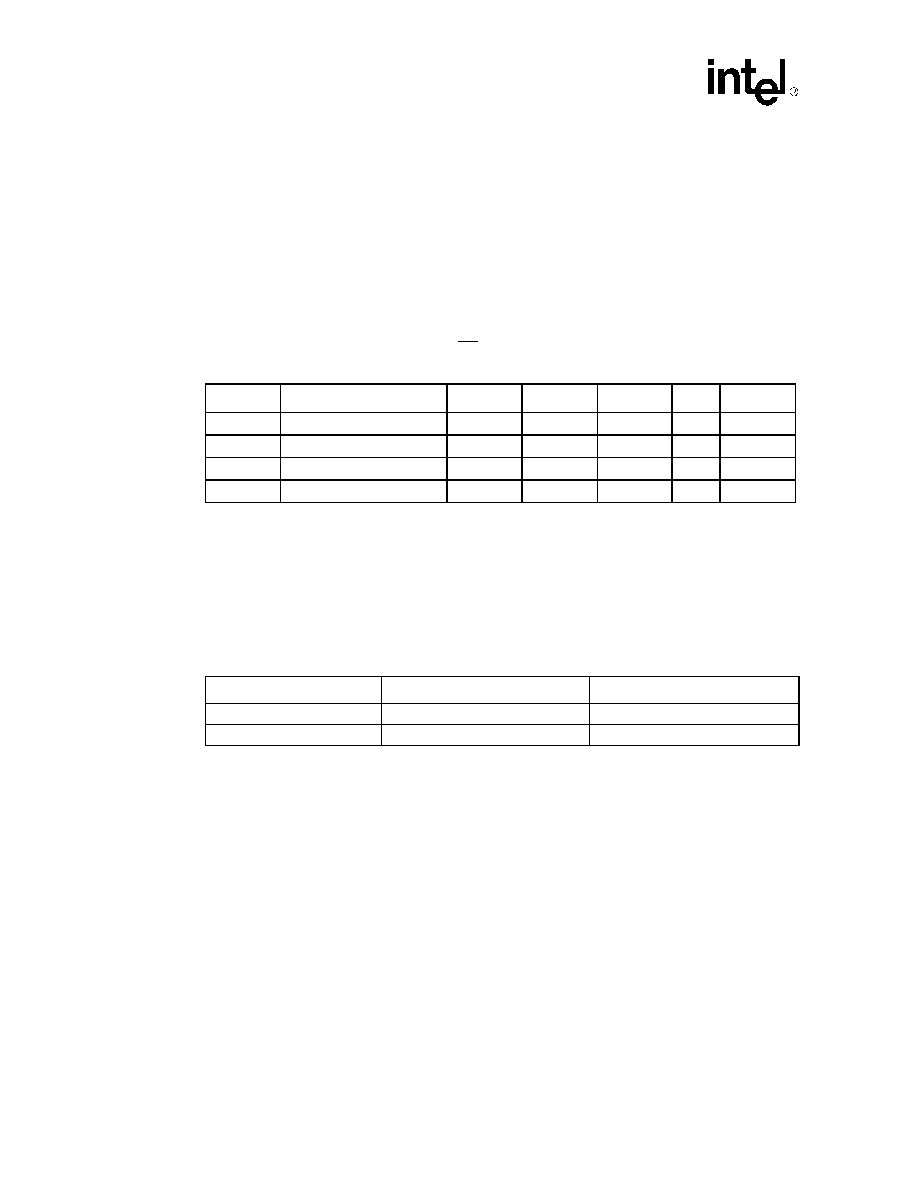
52
Datasheet
Intel
Æ
Celeron
Æ
Processor for PGA370 up to 1.40 GHz on 0.13
µ
Process
4.1.2
Thermal Diode
The processor incorporates an on-die diode that may be used to monitor the die temperature
(junction temperature). A thermal sensor located on the motherboard, or a stand-alone
measurement kit, may monitor the die temperature of the processor for thermal management or
instrumentation purposes.
Table 32
and
Table 33
provide the diode parameter and interface
specifications.
The processor uses an Integrated Heat Spreader (IHS) and has a case temperature requirement.
Please see the Intel
Æ
Pentium
Æ
III
Processor in the FC-PGA2, 370-pin Package Thermal Design
Guidelines document for details on measuring the case temperature. The thermal diode should be
used for system thermal management and not determining spec compliance.
NOTES:
1. Intel does not support or recommend operation of the thermal diode under reverse bias.
2. Characterized at 75
∞
C with a forward bias current of 5 ≠ 150
µ
A.
3. Characterized at 75
∞
C with a forward bias current of 5 ≠ 300
µ
A.
4. The ideality factor, n, represents the deviation from ideal diode behavior as exemplified by the diode
equation:
I
fw
=Is(e^ ((Vd*q)/(nkT)) - 1), where Is = saturation current, q = electronic charge, Vd = voltage across the
diode, k = Boltzmann Constant, and T = absolute temperature (Kelvin).
5. Not 100% tested. Specified by design characterization.
4.2
Thermal Metrology
The thermal metrology for the processor in the FC-PGA2 package should be followed to evaluate
the thermal performance of proposed cooling solutions. The thermal metrology is contained in the
Intel
Æ
Pentium
Æ
III
Processor in the FC-PGA2, 370-pin Package Thermal Design Guidelines.
Please contact your local Intel field office to obtain this document.
Table 32. Thermal Diode Parameters
Symbol
Parameter
Min
Typ
Max
Unit
Notes
1
I
fw
Forward Bias Current
5
N/A
150
µA
1
n
Diode Ideality Factor
1.001452
1.007152
1.012852
2, 4, 5
I
fw
Forward Bias Current
5
N/A
300
µA
1
n
Diode Ideality Factor
1.000807
1.009528
1.018249
3, 4, 5
Table 33. Thermal Diode Interface
Pin Name
PGA370 Socket pin #
Pin Description
THERMDP
AL31
diode anode (p_junction)
THERMDN
AL29
diode cathode (n_junction)
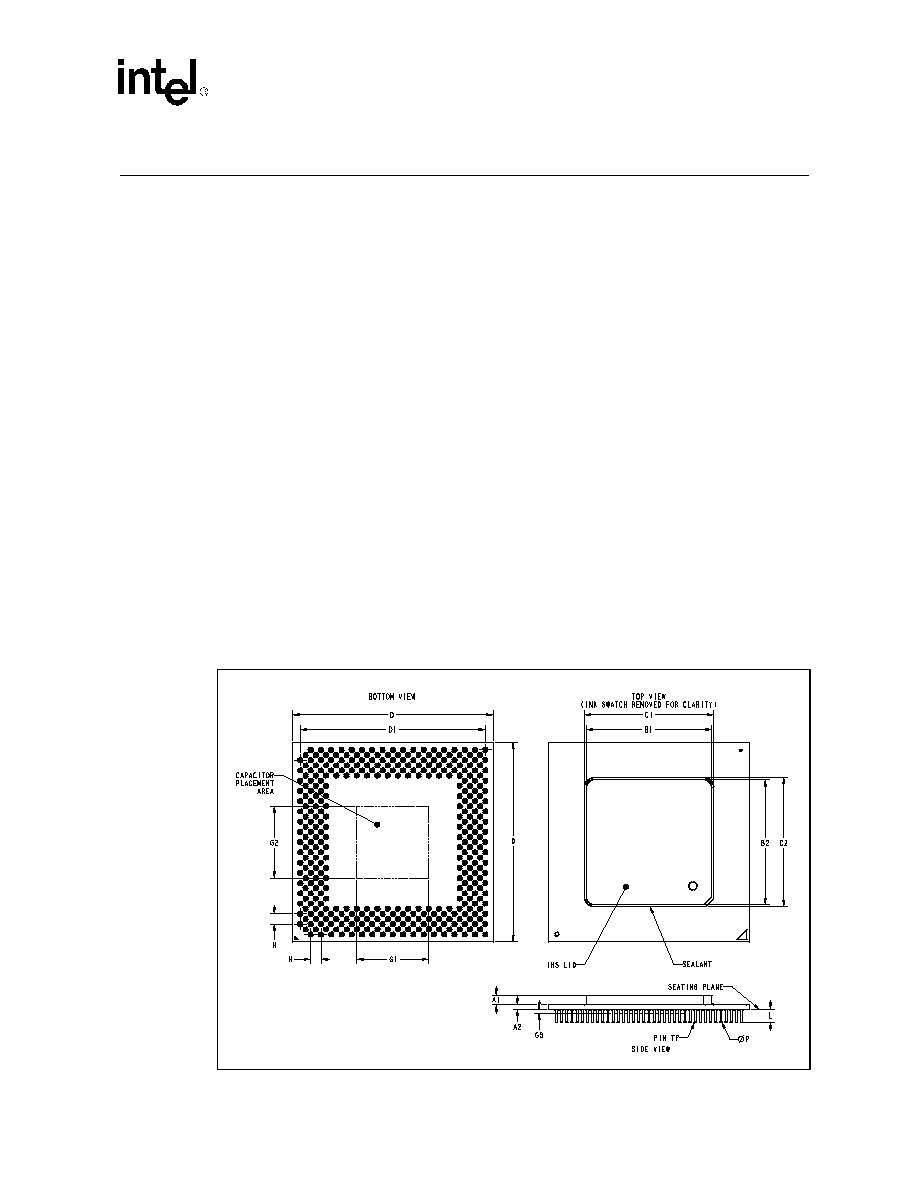
Datasheet
53
Intel
Æ
Celeron
Æ
Processor for PGA370 up to 1.40 GHz on 0.13
µ
Process
5.0
Mechanical Specifications
The processor uses a FC-PGA2 package technology. Mechanical specifications for the processor
are given in this section. See
Section 1.1.1
for a complete terminology listing.
The processor utilizes a PGA370 socket for installation into the motherboard. Details on the socket
are available in the 370-Pin Socket (PGA370) Design Guidelines.
Note: For
Figure 23
, the following apply:
1. Unless otherwise specified, the following drawings are dimensioned in inches.
2. All dimensions provided with tolerances are guaranteed to be met for all normal production
product.
3. Figures and drawings labeled as "Reference Dimensions" are provided for informational
purposes only. Reference dimensions are extracted from the mechanical design database and
are nominal dimensions with no tolerance information applied. Reference dimensions are
NOT checked as part of the processor manufacturing. Unless noted as such, dimensions in
parentheses without tolerances are reference dimensions.
4. Drawings are not to scale.
5.1
FC-PGA2 Mechanical Specifications
The following figure with package dimensions is provided to aid in the design of heatsink and clip
solutions as well as demonstrate where pin-side capacitors will be located on the processor.
Table 34
includes the measurements for these dimensions in both inches and millimeters.
Figure 23. Package Dimensions

54
Datasheet
Intel
Æ
Celeron
Æ
Processor for PGA370 up to 1.40 GHz on 0.13
µ
Process
NOTE:
Capacitors will be placed on the pin-side of the FC-PGA2 package in the area defined by G1, G2, and
G3. This area is a keepout zone for motherboard designers.
For
Table 35
, the following apply:
1. It is not recommended to use any portion of the processor substrate as a mechanical reference
or load bearing surface for thermal solutions.
2. Parameters assume uniformly applied loads
NOTES:
1. This specification applies to a uniform and a non-uniform load.
2. This is the maximum static force that can be applied by the heatsink and clip to maintain the heatsink and
processor interface.
3. Please see socket manufacturer's force loading specification also to ensure compliance. Maximum static
loading listed here does not account for the maximum reaction forces on the socket tabs or pins.
Table 34. The Processor Package Dimensions
Symbol
Millimeters
Inches
Minimum
Maximum
Notes
Minimum
Maximum
Notes
A1
2.266
2.690
0.089
0.106
A2
0.980
1.180
0.038
0.047
B1
30.800
31.200
1.212
1.229
B2
30.800
31.200
1.212
1.229
C1
33.000 max
1.299 max
C2
33.000 max
1.299 max
D
49.428
49.632
1.946
1.954
D1
45.466
45.974
1.790
1.810
G1
0.000
17.780
0.000
0.700
G2
0.000
17.780
0.000
0.700
G3
0.000
0.889
0.000
0.035
H
2.540
Nominal
0.100
Nominal
L
3.048
3.302
0.120
0.130
P
0.431
0.483
0.017
0.019
Pin TP
0.508 Diametric True Position (Pin-to-Pin)
0.020 Diametric True Position (Pin-to-Pin)
Table 35. Processor Case Loading Parameters
Parameter
Dynamic (max)
1
Static (max)
2,3
Unit
IHS Surface
200
100
lbf
IHS Edge
125
N/A
lbf
IHS Corner
75
N/A
ibf
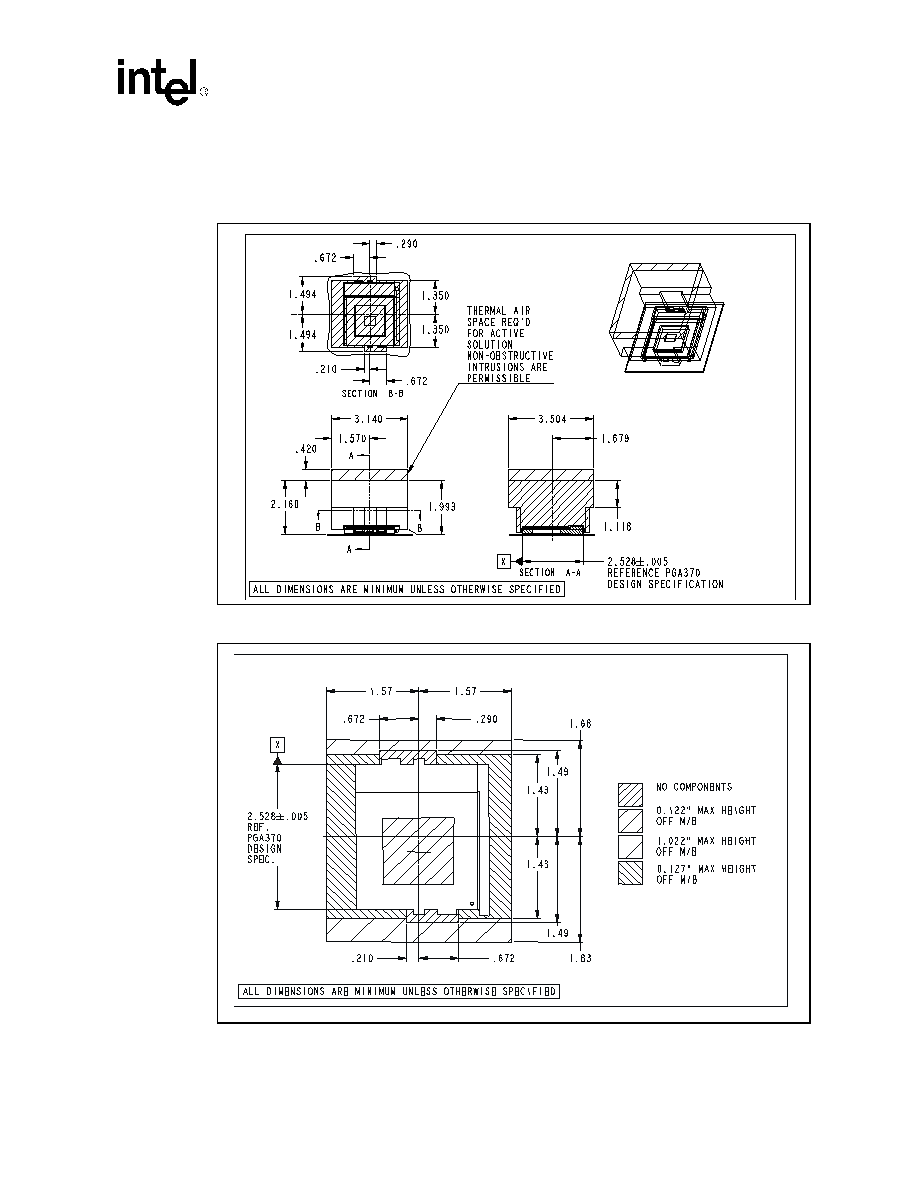
Datasheet
55
Intel
Æ
Celeron
Æ
Processor for PGA370 up to 1.40 GHz on 0.13
µ
Process
5.2
Recommended Mechanical Keep-Out Zones
Figure 24. Volumetric Keep-Out
Figure 25. Component Keep-Out
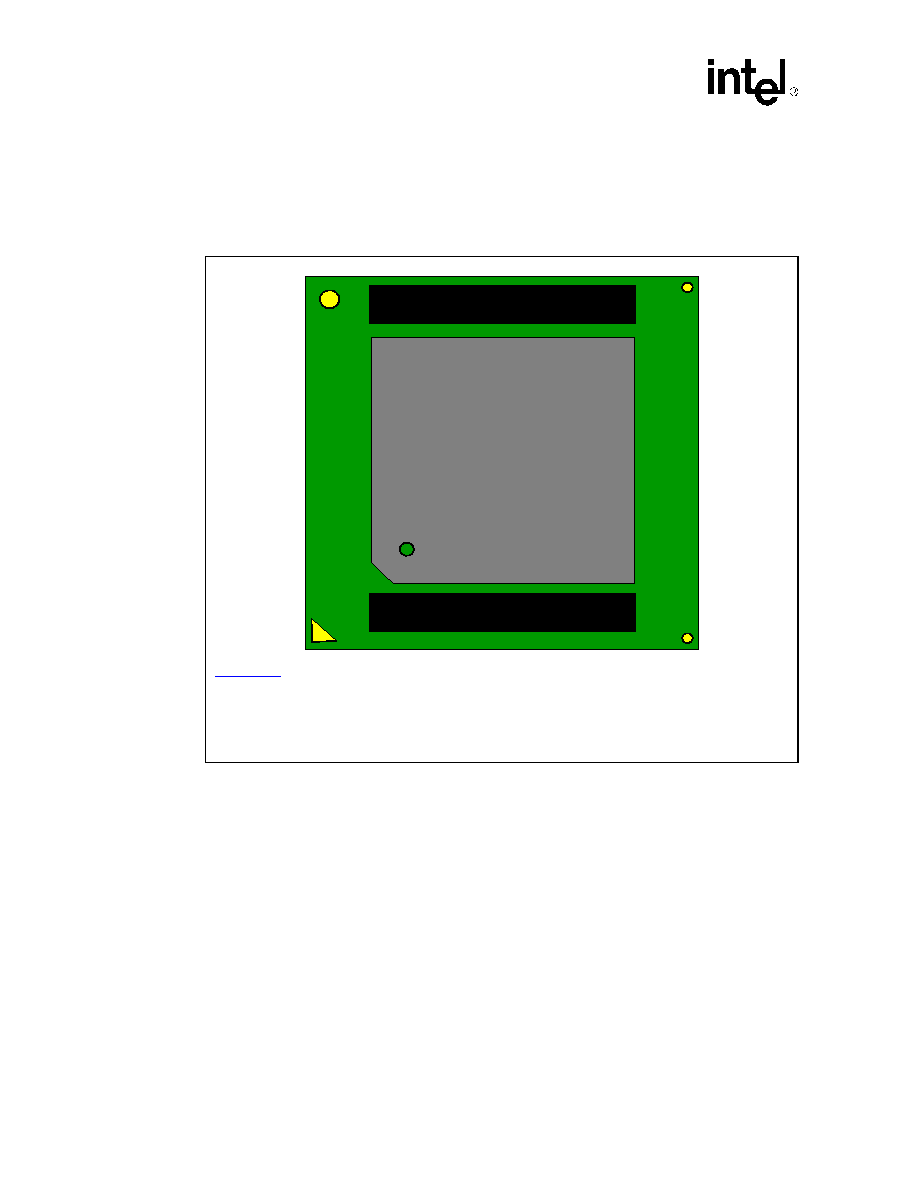
56
Datasheet
Intel
Æ
Celeron
Æ
Processor for PGA370 up to 1.40 GHz on 0.13
µ
Process
5.3
Processor Markings
Figure 26
shows the processor top-side markings and it is provided to aid in the identification of
the Celeron processor.
Table 34
lists the measurements for the package dimensions.
Figure 26. Top Side Processor Markings
GRP2LN1
GRP2LN2
GRP1LN1
GRP1LN2
Production
GRP1LN1: Intel'01 (m)(c)_-_{COO}
GRP1LN2:
{FPO}-{S/N}
GRP2LN1: {core freq}/{cache size}/{PSB}/{VID}
GRP2LN2: {S-spec here}

Datasheet
57
Intel
Æ
Celeron
Æ
Processor for PGA370 up to 1.40 GHz on 0.13
µ
Process
5.4
Processor Signal Listing
Table 36
and
Table 37
provide the processor pin definitions. The signal locations on the PGA370
socket are to be used for signal routing, simulation, and component placement on the baseboard.
Figure 27
provides a pin-side view of the processor pinout.
Figure 27. Processor Pinout
VSS
VCC
VSS
D35
D29
D33
D26
D28
D21
D23
D25
VSS
VCC
VSS
D31
VCC
D43
VCC
VSS
D34
D38
VCC
VSS
D39
D36
VCC
D37
D44
VCC
VCC
D32
D22
RSV
D27
VSS
D42
D45
D49
VSS
VCC
D63
VREF1
VSS
VCC
VSS
VCC
VSS
VCC
VSS
VCC
VSS
VCC
VSS
VCC
VSS
RSV
VTT
D62
SLEW
CTRL
DEP6
DEP4
VREF0
BPM1
BP3
D41
D52
VSS
VCC
VSS
VCC
VSS
VCC
VSS
VCC
VSS
VCC
D40
D59
D55
D54
D58
D50
D56
DEP5
DEP1
DEP0
BPM0
CPUPRES
VCC
VSS
VCC
VSS
VCC
VSS
VCC
VSS
VCC
VSS
VCC
BINIT
D51
D47
D48
D57
D46
D53
D60
D61
DEP7
DEP3
DEP2
PRDY
VSS
BP2
VTT
VTT
VCC
VSS
VCC
PICCLK
PICD0
PREQ
VCC
VCC
VSS
RSV
PICD1
LINT1
VCC
VSS
LINT0
RSV
RSV
RSV
VSS
VCC
VSS
NCHCTRL
RSV
RSV
VCC
VSS
VCC
VTT
RTT
CTRL
VTT
VSS
VCC
VSS
PLL2
VTT
VTT
VCC
VSS
VCC
BCLK#/
CLKREF
VCC
VSS
VCC
VSS
RSV
VTT
VTT
VCC
VSS
VCC
VTT
VSS
FERR
RSP
VCC
VSS
VTT
A20M
IERR
FLUSH
VSS
VCC
DETECT
INIT
VSS
VTT
VSS
PLL1
RSV
BCLK
STPCLK
IGNNE
VSS
D16
D19
D7
D30
VCC
VCC
VREF2
D24
D13
D20
VSS
VSS
D11
D3
D2
D14
VCC
VCC
D18
D9
D12
D10
VSS
RSV
D17
VREF3
D8
D5
VCC
VCC
D1
D6
D4
D15
VSS
VSS
BERR
VREF4
D0
A34
VCC
RSV
VSS
A32
RSV
A26
VSS
VSS
A29
A18
A27
A30
VCC
VCC
A24
A23
A33
A20
VSS
VSS
A31
VREF5
A17
A22
VCC
VCC
A35
A25
VTT
A19
VSS
VSS
RESET
A10
A5
A8
A4
BNR
REQ1
REQ2
VTT
RS1
VCC
RS0
THERM
TRIP
SLP
VCC
VSS
VCC
A21
RESET2#
VCC
VSS
VCC
VSS
VCC
VSS
VCC
VSS
VCC
VSS
VCC
VSS
VCC
BSEL1
BSEL0
SMI
VID3
VCC
VttPWRGD A28
A3
A11
VREF6
A14
VTT
REQ0
LOCK
CMOSREF
AERR
PWRGD
RS2
RSV
TMS
VCC
VID25m
V
RSV
VSS
A15
A13
A9
AP0
VTT
A7
REQ4
REQ3
VTT
HITM
HIT
DBSY
THRMDN
THRMDP
TCK
VID0
VID2
KEY
VCC
VSS
VCC
VSS
VCC
VSS
VCC
VSS
VCC
VSS
VCC
VSS
VCC
VSS
VCC
VSS
VID1
DYN_OE
A12
A16
A6
VTT
AP1
VTT
BPRI
DEFER
VTT
RP
TRDY
DRDY
BR0
ADS
TRST
TDI
TDO
Pin Side View
AN
AM
AL
AK
AJ
AH
AG
AF
AE
AD
AC
AB
AA
Z
Y
X
W
V
U
T
S
R
Q
P
N
M
L
K
J
H
G
F
E
D
C
B
A
AN
AM
AL
AK
AJ
AH
AG
AF
AE
AD
AC
AB
AA
Z
Y
X
W
V
U
T
S
R
Q
P
N
M
L
K
J
H
G
F
E
D
C
B
A
1
2
3
4
5
6
7
8
9
10
11
12
13
14
15
16
17
18
19
20
21
22
23
24
25
26
27
28
29
30
31
32
33
34
35
36
37
1
2
3
4
5
6
7
8
9
10
11
12
13
14
15
16
17
18
19
20
21
22
23
24
25
26
27
28
29
30
31
32
33
34
35
36
37

58
Datasheet
Intel
Æ
Celeron
Æ
Processor for PGA370 up to 1.40 GHz on 0.13
µ
Process
Table 36. Signal Listing in Order by
Signal Name
Pin
No.
Pin Name
Signal Group
AH6
A10#
AGTL I/O
AK10
A11#
AGTL I/O
AN5
A12#
AGTL I/O
AL7
A13#
AGTL I/O
AK14
A14#
AGTL I/O
AL5
A15#
AGTL I/O
AN7
A16#
AGTL I/O
AE1
A17#
AGTL I/O
Z6
A18#
AGTL I/O
AG3
A19#
AGTL I/O
AC3
A20#
AGTL I/O
AE33
A20M#
CMOS Input
AJ1
A21#
AGTL I/O
AE3
A22#
AGTL I/O
AB6
A23#
AGTL I/O
AB4
A24#
AGTL I/O
AF6
A25#
AGTL I/O
Y3
A26#
AGTL I/O
AA1
A27#
AGTL I/O
AK6
A28#
AGTL I/O
Z4
A29#
AGTL I/O
AK8
A3#
AGTL I/O
AA3
A30#
AGTL I/O
AD4
A31#
AGTL I/O
X6
A32#
AGTL I/O
AC1
A33#
AGTL I/O
W3
A34#
AGTL I/O
AF4
A35#
AGTL I/O
AH12
A4#
AGTL I/O
AH8
A5#
AGTL I/O
AN9
A6#
AGTL I/O
AL15
A7#
AGTL I/O
AH10
A8#
AGTL I/O
AL9
A9#
AGTL I/O
AN31
ADS#
AGTL I/O
AK24
AERR#
AGTL I/O
AL11
AP0#
AGTL I/O
AN13
AP1#
AGTL I/O
W37
BCLK
System Bus Clock
Y33
BCLK#/CLKREF
System Bus Clock
V4
BERR#
AGTL I/O
B36
BINIT#
AGTL I/O
AH14
BNR#
AGTL I/O
G33
BP2#
AGTL I/O
E37
BP3#
AGTL I/O
C35
BPM0#
AGTL I/O
E35
BPM1#
AGTL I/O
AN17
BPRI#
AGTL Input
AN29
BR0#
AGTL I/O
X2
Reserved
AGTL I/O
AJ33
BSEL0
3.3V Output
AJ31
BSEL1
3.3V Output
C37
CPUPRES#
Power/Other
W1
D0#
AGTL I/O
T4
D1#
AGTL I/O
Q3
D10#
AGTL I/O
M4
D11#
AGTL I/O
Q1
D12#
AGTL I/O
L1
D13#
AGTL I/O
N3
D14#
AGTL I/O
U3
D15#
AGTL I/O
H4
D16#
AGTL I/O
R4
D17#
AGTL I/O
P4
D18#
AGTL I/O
H6
D19#
AGTL I/O
N1
D2#
AGTL I/O
L3
D20#
AGTL I/O
G1
D21#
AGTL I/O
F8
D22#
AGTL I/O
G3
D23#
AGTL I/O
K6
D24#
AGTL I/O
E3
D25#
AGTL I/O
E1
D26#
AGTL I/O
F12
D27#
AGTL I/O
A5
D28#
AGTL I/O
A3
D29#
AGTL I/O
M6
D3#
AGTL I/O
J3
D30#
AGTL I/O
C5
D31#
AGTL I/O
F6
D32#
AGTL I/O
Table 36. Signal Listing in Order by
Signal Name (Continued)
Pin
No.
Pin Name
Signal Group

Datasheet
59
Intel
Æ
Celeron
Æ
Processor for PGA370 up to 1.40 GHz on 0.13
µ
Process
C1
D33#
AGTL I/O
C7
D34#
AGTL I/O
B2
D35#
AGTL I/O
C9
D36#
AGTL I/O
A9
D37#
AGTL I/O
D8
D38#
AGTL I/O
D10
D39#
AGTL I/O
U1
D4#
AGTL I/O
C15
D40#
AGTL I/O
D14
D41#
AGTL I/O
D12
D42#
AGTL I/O
A7
D43#
AGTL I/O
A11
D44#
AGTL I/O
C11
D45#
AGTL I/O
A21
D46#
AGTL I/O
A15
D47#
AGTL I/O
A17
D48#
AGTL I/O
C13
D49#
AGTL I/O
S3
D5#
AGTL I/O
C25
D50#
AGTL I/O
A13
D51#
AGTL I/O
D16
D52#
AGTL I/O
A23
D53#
AGTL I/O
C21
D54#
AGTL I/O
C19
D55#
AGTL I/O
C27
D56#
AGTL I/O
A19
D57#
AGTL I/O
C23
D58#
AGTL I/O
C17
D59#
AGTL I/O
T6
D6#
AGTL I/O
A25
D60#
AGTL I/O
A27
D61#
AGTL I/O
E25
D62#
AGTL I/O
F16
D63#
AGTL I/O
J1
D7#
AGTL I/O
S1
D8#
AGTL I/O
P6
D9#
AGTL I/O
AL27
DBSY#
AGTL I/O
AN19
DEFER#
AGTL Input
C33
DEP0#
AGTL I/O
Table 36. Signal Listing in Order by
Signal Name (Continued)
Pin
No.
Pin Name
Signal Group
C31
DEP1#
AGTL I/O
A33
DEP2#
AGTL I/O
A31
DEP3#
AGTL I/O
E31
DEP4#
AGTL I/O
C29
DEP5#
AGTL I/O
E29
DEP6#
AGTL I/O
A29
DEP7#
AGTL I/O
AF36
DETECT
Power/Other
AN27
DRDY#
AGTL I/O
AN3
DYN_OE
Power/Other
AC35
FERR#
CMOS Output
AE37
FLUSH#
CMOS Input
AL25
HIT#
AGTL I/O
AL23
HITM#
AGTL I/O
AE35
IERR#
CMOS Output
AG37
IGNNE#
CMOS Input
AG33
INIT#
CMOS Input
AM2
KEY
Power/Other
M36
LINT0/INTR
CMOS Input
L37
LINT1/NMI
CMOS Input
AK20
LOCK#
AGTL I/O
N37
NCHCTRL
Power/Other
J33
PICCLK
APIC Clock Input
J35
PICD0
APIC I/O
L35
PICD1
APIC I/O
W33
PLL1
Power/Other
U33
PLL2
Power/Other
A35
PRDY#
AGTL Output
J37
PREQ#
CMOS Input
AK26
PWRGOOD
CMOS Input
AK18
REQ0#
AGTL I/O
AH16
REQ1#
AGTL I/O
AH18
REQ2#
AGTL I/O
AL19
REQ3#
AGTL I/O
AL17
REQ4#
AGTL I/O
AK30
Reserved
Reserved for future use
AL1
Reserved
Reserved for future use
F10
Reserved
Reserved for future use
E21
Reserved
Reserved for future use
L33
Reserved
Reserved for future use
Table 36. Signal Listing in Order by
Signal Name (Continued)
Pin
No.
Pin Name
Signal Group

60
Datasheet
Intel
Æ
Celeron
Æ
Processor for PGA370 up to 1.40 GHz on 0.13
µ
Process
N33
Reserved
Reserved for future use
N35
Reserved
Reserved for future use
Q33
Reserved
Reserved for future use
Q35
Reserved
Reserved for future use
Q37
Reserved
Reserved for future use
R2
Reserved
Reserved for future use
W35
Reserved
Reserved for future use
Y1
Reserved
Reserved for future use
Z36
Reserved
Reserved for future use
AH4
RESET#
AGTL Input
AJ3
RESET2#
AGTL Input
AN23
RP#
AGTL I/O
AH26
RS0#
AGTL + Input
AH22
RS1#
AGTL Input
AK28
RS2#
AGTL Input
AC37
RSP#
AGTL Input
S35
RTTCTRL
Power/Other
E27
SLEWCTRL
Power/Other
AH30
SLP#
CMOS Input
AJ35
SMI#
CMOS Input
AG35
STPCLK#
CMOS Input
AL33
TCK
TAP Input
AN35
TDI
TAP Input
AN37
TDO
TAP Output
AL29
THERMDN
Power/Other
AL31
THERMDP
Power/Other
AH28
THERMTRIP# CMOS Output
AK32
TMS
TAP Input
AN25
TRDY#
AGTL Input
AN33
TRST#
TAP Input
AA37
V
CC
CORE
Power/Other
AA5
V
CC
CORE
Power/Other
AB2
V
CC
CORE
Power/Other
AB34
V
CC
CORE
Power/Other
AD32
V
CC
CORE
Power/Other
AE5
V
CC
CORE
Power/Other
AF2
V
CC
CORE
Power/Other
AF34
V
CC
CORE
Power/Other
AH24
V
CC
CORE
Power/Other
AH32
V
CC
CORE
Power/Other
Table 36. Signal Listing in Order by
Signal Name (Continued)
Pin
No.
Pin Name
Signal Group
AH36
V
CC
CORE
Power/Other
AJ13
V
CC
CORE
Power/Other
AJ17
V
CC
CORE
Power/Other
AJ21
V
CC
CORE
Power/Other
AJ25
V
CC
CORE
Power/Other
AJ29
V
CC
CORE
Power/Other
AJ5
V
CC
CORE
Power/Other
AJ9
V
CC
CORE
Power/Other
AK2
V
CC
CORE
Power/Other
AK34
V
CC
CORE
Power/Other
AM12
V
CC
CORE
Power/Other
AM16
V
CC
CORE
Power/Other
AM20
V
CC
CORE
Power/Other
AM24
V
CC
CORE
Power/Other
AM28
V
CC
CORE
Power/Other
AM32
V
CC
CORE
Power/Other
AM4
V
CC
CORE
Power/Other
AM8
V
CC
CORE
Power/Other
B10
V
CC
CORE
Power/Other
B14
V
CC
CORE
Power/Other
B18
V
CC
CORE
Power/Other
B22
V
CC
CORE
Power/Other
B26
V
CC
CORE
Power/Other
B30
V
CC
CORE
Power/Other
B34
V
CC
CORE
Power/Other
B6
V
CC
CORE
Power/Other
C3
V
CC
CORE
Power/Other
D20
V
CC
CORE
Power/Other
D24
V
CC
CORE
Power/Other
D28
V
CC
CORE
Power/Other
D32
V
CC
CORE
Power/Other
D36
V
CC
CORE
Power/Other
D6
V
CC
CORE
Power/Other
E13
V
CC
CORE
Power/Other
E17
V
CC
CORE
Power/Other
E5
V
CC
CORE
Power/Other
E9
V
CC
CORE
Power/Other
F14
V
CC
CORE
Power/Other
F2
V
CC
CORE
Power/Other
F22
V
CC
CORE
Power/Other
Table 36. Signal Listing in Order by
Signal Name (Continued)
Pin
No.
Pin Name
Signal Group

Datasheet
61
Intel
Æ
Celeron
Æ
Processor for PGA370 up to 1.40 GHz on 0.13
µ
Process
F26
V
CC
CORE
Power/Other
F30
V
CC
CORE
Power/Other
F34
V
CC
CORE
Power/Other
F4
V
CC
CORE
Power/Other
H32
V
CC
CORE
Power/Other
H36
V
CC
CORE
Power/Other
J5
V
CC
CORE
Power/Other
K2
V
CC
CORE
Power/Other
K32
V
CC
CORE
Power/Other
K34
V
CC
CORE
Power/Other
M32
V
CC
CORE
Power/Other
N5
V
CC
CORE
Power/Other
P2
V
CC
CORE
Power/Other
P34
V
CC
CORE
Power/Other
R32
V
CC
CORE
Power/Other
R36
V
CC
CORE
Power/Other
S5
V
CC
CORE
Power/Other
T2
V
CC
CORE
Power/Other
T34
V
CC
CORE
Power/Other
V32
V
CC
CORE
Power/Other
V36
V
CC
CORE
Power/Other
W5
V
CC
CORE
Power/Other
Y35
V
CC
CORE
Power/Other
Z32
V
CC
CORE
Power/Other
AK22
V
CMOS_REF
Power/Other
AK36
VID 25mV
3.3V Output
AL35
VID0
3.3V Output
AM36
VID1
3.3V Output
AL37
VID2
3.3V Output
AJ37
VID3
3.3V Output
E33
V
REF
0
Power/Other
F18
V
REF
1
Power/Other
K4
V
REF
2
Power/Other
R6
V
REF
3
Power/Other
V6
V
REF
4
Power/Other
AD6
V
REF
5
Power/Other
AK12
V
REF
6
Power/Other
A37
Vss
Power/Other
AB32
Vss
Power/Other
AC33
Vss
Power/Other
Table 36. Signal Listing in Order by
Signal Name (Continued)
Pin
No.
Pin Name
Signal Group
AC5
Vss
Power/Other
AD2
Vss
Power/Other
AD34
Vss
Power/Other
AF32
Vss
Power/Other
AG5
Vss
Power/Other
AH2
Vss
Power/Other
AH34
Vss
Power/Other
AJ11
Vss
Power/Other
AJ15
Vss
Power/Other
AJ19
Vss
Power/Other
AJ23
Vss
Power/Other
AJ27
Vss
Power/Other
AJ7
Vss
Power/Other
AL3
Vss
Power/Other
AM10
Vss
Power/Other
AM14
Vss
Power/Other
AM18
Vss
Power/Other
AM22
Vss
Power/Other
AM26
Vss
Power/Other
AM30
Vss
Power/Other
AM34
Vss
Power/Other
AM6
Vss
Power/Other
B12
Vss
Power/Other
B16
Vss
Power/Other
B20
Vss
Power/Other
B24
Vss
Power/Other
B28
Vss
Power/Other
B32
Vss
Power/Other
B4
Vss
Power/Other
B8
Vss
Power/Other
D18
Vss
Power/Other
D2
Vss
Power/Other
D22
Vss
Power/Other
D26
Vss
Power/Other
D30
Vss
Power/Other
D34
Vss
Power/Other
D4
Vss
Power/Other
E11
Vss
Power/Other
E15
Vss
Power/Other
E19
Vss
Power/Other
Table 36. Signal Listing in Order by
Signal Name (Continued)
Pin
No.
Pin Name
Signal Group

62
Datasheet
Intel
Æ
Celeron
Æ
Processor for PGA370 up to 1.40 GHz on 0.13
µ
Process
E7
Vss
Power/Other
F20
Vss
Power/Other
F24
Vss
Power/Other
F28
Vss
Power/Other
F32
Vss
Power/Other
F36
Vss
Power/Other
G5
Vss
Power/Other
H2
Vss
Power/Other
H34
Vss
Power/Other
K36
Vss
Power/Other
L5
Vss
Power/Other
M2
Vss
Power/Other
M34
Vss
Power/Other
P32
Vss
Power/Other
P36
Vss
Power/Other
Q5
Vss
Power/Other
R34
Vss
Power/Other
T32
Vss
Power/Other
T36
Vss
Power/Other
U5
Vss
Power/Other
V2
Vss
Power/Other
V34
Vss
Power/Other
X32
Vss
Power/Other
X36
Vss
Power/Other
X4
Vss
Power/Other
Table 36. Signal Listing in Order by
Signal Name (Continued)
Pin
No.
Pin Name
Signal Group
Y37
Vss
Power/Other
Y5
Vss
Power/Other
Z2
Vss
Power/Other
Z34
Vss
Power/Other
AB36
V
TT
Power/Other
AD36
V
TT
Power/Other
AG1
V
TT
Power/Other
AH20
V
TT
Power/Other
AK16
V
TT
Power/Other
AL13
V
TT
Power/Other
AL21
V
TT
Power/Other
AN11
V
TT
Power/Other
AN15
V
TT
Power/Other
E23
V
TT
Power/Other
G35
V
TT
Power/Other
G37
V
TT
Power/Other
S33
V
TT
Power/Other
X34
V
TT
Power/Other
AA33
V
TT
Power/Other
AA35
V
TT
Power/Other
AN21
V
TT
Power/Other
S37
V
TT
Power/Other
U35
V
TT
Power/Other
U37
V
TT
Power/Other
AK4
V
TT
_PWRGD
Power/Other
Table 36. Signal Listing in Order by
Signal Name (Continued)
Pin
No.
Pin Name
Signal Group

Datasheet
63
Intel
Æ
Celeron
Æ
Processor for PGA370 up to 1.40 GHz on 0.13
µ
Process
Table 37. Signal Listing in Order by Pin
Number
Pin
No.
Pin Name
Signal Group
A3
D29#
AGTL I/O
A5
D28#
AGTL I/O
A7
D43#
AGTL I/O
A9
D37#
AGTL I/O
A11
D44#
AGTL I/O
A13
D51#
AGTL I/O
A15
D47#
AGTL I/O
A17
D48#
AGTL I/O
A19
D57#
AGTL I/O
A21
D46#
AGTL I/O
A23
D53#
AGTL I/O
A25
D60#
AGTL I/O
A27
D61#
AGTL I/O
A29
DEP7#
AGTL I/O
A31
DEP3#
AGTL I/O
A33
DEP2#
AGTL I/O
A35
PRDY#
AGTL Output
A37
Vss
Power/Other
AA1
A27#
AGTL I/O
AA3
A30#
AGTL I/O
AA5
V
CC
CORE
Power/Other
AA33
V
TT
Power/Other
AA35
V
TT
Power/Other
AA37
V
CC
CORE
Power/Other
AB2
V
CC
CORE
Power/Other
AB4
A24#
AGTL I/O
AB6
A23#
AGTL I/O
AB32
Vss
Power/Other
AB34
V
CC
CORE
Power/Other
AB36
V
TT
Power/Other
AC1
A33#
AGTL I/O
AC3
A20#
AGTL I/O
AC5
Vss
Power/Other
AC33
Vss
Power/Other
AC35
FERR#
CMOS Output
AC37
RSP#
AGTL Input
AD2
Vss
Power/Other
AD4
A31#
AGTL I/O
AD6
V
REF
5
Power/Other
AD32
V
CC
CORE
Power/Other
AD34
Vss
Power/Other
AD36
V
TT
Power/Other
AE1
A17#
AGTL I/O
AE3
A22#
AGTL I/O
AE5
V
CC
CORE
Power/Other
AE33
A20M#
CMOS Input
AE35
IERR#
CMOS Output
AE37
FLUSH#
CMOS Input
AF2
V
CC
CORE
Power/Other
AF4
A35#
AGTL I/O
AF6
A25#
AGTL I/O
AF32
Vss
Power/Other
AF34
V
CC
CORE
Power/Other
AF36
DETECT
Power/Other
AG1
V
TT
Power/Other
AG3
A19#
AGTL I/O
AG5
Vss
Power/Other
AG33
INIT#
CMOS Input
AG35
STPCLK#
CMOS Input
AG37
IGNNE#
CMOS Input
AH2
Vss
Power/Other
AH4
RESET# AGTL
Input
AH6
A10#
AGTL I/O
AH8
A5#
AGTL I/O
AH10
A8#
AGTL I/O
AH12
A4#
AGTL I/O
AH14
BNR#
AGTL I/O
AH16
REQ1#
AGTL I/O
AH18
REQ2#
AGTL I/O
AH20
V
TT
Power/Other
AH22
RS1#
AGTL Input
AH24
V
CC
CORE
Power/Other
AH26
RS0#
AGTL + Input
AH28
THERMTRIP# CMOS Output
AH30
SLP#
CMOS Input
AH32
V
CC
CORE
Power/Other
AH34
Vss
Power/Other
AH36
V
CC
CORE
Power/Other
AJ1
A21#
AGTL I/O
AJ3
RESET2#
AGTL Input
Table 37. Signal Listing in Order by Pin
Number (Continued)
Pin
No.
Pin Name
Signal Group

64
Datasheet
Intel
Æ
Celeron
Æ
Processor for PGA370 up to 1.40 GHz on 0.13
µ
Process
AJ5
V
CC
CORE
Power/Other
AJ7
Vss
Power/Other
AJ9
V
CC
CORE
Power/Other
AJ11
Vss
Power/Other
AJ13
V
CC
CORE
Power/Other
AJ15
Vss
Power/Other
AJ17
V
CC
CORE
Power/Other
AJ19
Vss
Power/Other
AJ21
V
CC
CORE
Power/Other
AJ23
Vss
Power/Other
AJ25
V
CC
CORE
Power/Other
AJ27
Vss
Power/Other
AJ29
V
CC
CORE
Power/Other
AJ31
BSEL1
3.3V Output
AJ33
BSEL0
3.3V Output
AJ35
SMI#
CMOS Input
AJ37
VID3
3.3V Output
AK2
V
CC
CORE
Power/Other
AK4
V
TT
_PWRGD
Power/Other
AK6
A28#
AGTL I/O
AK8
A3#
AGTL I/O
AK10
A11#
AGTL I/O
AK12
V
REF
6
Power/Other
AK14
A14#
AGTL I/O
AK16
V
TT
Power/Other
AK18
REQ0#
AGTL I/O
AK20
LOCK#
AGTL I/O
AK22
V
CMOS_REF
Power/Other
AK24
AERR#
AGTL I/O
AK26
PWRGOOD
CMOS Input
AK28
RS2#
AGTL Input
AK30
Reserved
Reserved for future use
AK32
TMS
TAP Input
AK34
V
CC
CORE
Power/Other
AK36
VID 25mV
3.3V Output
AL1
Reserved
Reserved for future use
AL3
Vss
Power/Other
AL5
A15#
AGTL I/O
AL7
A13#
AGTL I/O
AL9
A9#
AGTL I/O
Table 37. Signal Listing in Order by Pin
Number (Continued)
Pin
No.
Pin Name
Signal Group
AL11
AP0#
AGTL I/O
AL13
V
TT
Power/Other
AL15
A7#
AGTL I/O
AL17
REQ4#
AGTL I/O
AL19
REQ3#
AGTL I/O
AL21
V
TT
Power/Other
AL23
HITM#
AGTL I/O
AL25
HIT#
AGTL I/O
AL27
DBSY#
AGTL I/O
AL29
THERMDN
Power/Other
AL31
THERMDP
Power/Other
AL33
TCK
TAP Input
AL35
VID0
3.3V Output
AL37
VID2
3.3V Output
AM2
KEY
Power/Other
AM4
V
CC
CORE
Power/Other
AM6
Vss
Power/Other
AM8
V
CC
CORE
Power/Other
AM10
Vss
Power/Other
AM12
V
CC
CORE
Power/Other
AM14
Vss
Power/Other
AM16
V
CC
CORE
Power/Other
AM18
Vss
Power/Other
AM20
V
CC
CORE
Power/Other
AM22
Vss
Power/Other
AM24
V
CC
CORE
Power/Other
AM26
Vss
Power/Other
AM28
V
CC
CORE
Power/Other
AM30
Vss
Power/Other
AM32
V
CC
CORE
Power/Other
AM34
Vss
Power/Other
AM36
VID1
3.3V Output
AN3
DYN_OE
Power/Other
AN5
A12#
AGTL I/O
AN7
A16#
AGTL I/O
AN9
A6#
AGTL I/O
AN11
V
TT
Power/Other
AN13
AP1#
AGTL I/O
AN15
V
TT
Power/Other
AN17
BPRI#
AGTL Input
Table 37. Signal Listing in Order by Pin
Number (Continued)
Pin
No.
Pin Name
Signal Group

Datasheet
65
Intel
Æ
Celeron
Æ
Processor for PGA370 up to 1.40 GHz on 0.13
µ
Process
AN19
DEFER#
AGTL Input
AN21
V
TT
Power/Other
AN23
RP#
AGTL I/O
AN25
TRDY#
AGTL Input
AN27
DRDY#
AGTL I/O
AN29
BR0#
AGTL I/O
AN31
ADS#
AGTL I/O
AN33
TRST#
TAP Input
AN35
TDI
TAP Input
AN37
TDO
TAP Output
B2
D35#
AGTL I/O
B4
Vss
Power/Other
B6
V
CC
CORE
Power/Other
B8
Vss
Power/Other
B10
V
CC
CORE
Power/Other
B12
Vss
Power/Other
B14
V
CC
CORE
Power/Other
B16
Vss
Power/Other
B18
V
CC
CORE
Power/Other
B20
Vss
Power/Other
B22
V
CC
CORE
Power/Other
B24
Vss
Power/Other
B26
V
CC
CORE
Power/Other
B28
Vss
Power/Other
B30
V
CC
CORE
Power/Other
B32
Vss
Power/Other
B34
V
CC
CORE
Power/Other
B36
BINIT#
AGTL I/O
C1
D33#
AGTL I/O
C3
V
CC
CORE
Power/Other
C5
D31#
AGTL I/O
C7
D34#
AGTL I/O
C9
D36#
AGTL I/O
C11
D45#
AGTL I/O
C13
D49#
AGTL I/O
C15
D40#
AGTL I/O
C17
D59#
AGTL I/O
C19
D55#
AGTL I/O
C21
D54#
AGTL I/O
C23
D58#
AGTL I/O
Table 37. Signal Listing in Order by Pin
Number (Continued)
Pin
No.
Pin Name
Signal Group
C25
D50#
AGTL I/O
C27
D56#
AGTL I/O
C29
DEP5#
AGTL I/O
C31
DEP1#
AGTL I/O
C33
DEP0#
AGTL I/O
C35
BPM0#
AGTL I/O
C37
CPUPRES#
Power/Other
D2
Vss
Power/Other
D4
Vss
Power/Other
D6
V
CC
CORE
Power/Other
D8
D38#
AGTL I/O
D10
D39#
AGTL I/O
D12
D42#
AGTL I/O
D14
D41#
AGTL I/O
D16
D52#
AGTL I/O
D18
Vss
Power/Other
D20
V
CC
CORE
Power/Other
D22
Vss
Power/Other
D24
V
CC
CORE
Power/Other
D26
Vss
Power/Other
D28
V
CC
CORE
Power/Other
D30
Vss
Power/Other
D32
V
CC
CORE
Power/Other
D34
Vss
Power/Other
D36
V
CC
CORE
Power/Other
E1
D26#
AGTL I/O
E3
D25#
AGTL I/O
E5
V
CC
CORE
Power/Other
E7
Vss
Power/Other
E9
V
CC
CORE
Power/Other
E11
Vss
Power/Other
E13
V
CC
CORE
Power/Other
E15
Vss
Power/Other
E17
V
CC
CORE
Power/Other
E19
Vss
Power/Other
E21
Reserved
Reserved for future use
E23
V
TT
4
Power/Other
E25
D62#
AGTL I/O
E27
SLEWCTRL
Power/Other
E29
DEP6#
AGTL I/O
Table 37. Signal Listing in Order by Pin
Number (Continued)
Pin
No.
Pin Name
Signal Group

66
Datasheet
Intel
Æ
Celeron
Æ
Processor for PGA370 up to 1.40 GHz on 0.13
µ
Process
E31
DEP4#
AGTL I/O
E33
V
REF
0
Power/Other
E35
BPM1#
AGTL I/O
E37
BP3#
AGTL I/O
F2
V
CC
CORE
Power/Other
F4
V
CC
CORE
Power/Other
F6
D32#
AGTL I/O
F8
D22#
AGTL I/O
F10
Reserved
Reserved for future use
F12
D27#
AGTL I/O
F14
V
CC
CORE
Power/Other
F16
D63#
AGTL I/O
F18
V
REF
1
Power/Other
F20
Vss
Power/Other
F22
V
CC
CORE
Power/Other
F24
Vss
Power/Other
F26
V
CC
CORE
Power/Other
F28
Vss
Power/Other
F30
V
CC
CORE
Power/Other
F32
Vss
Power/Other
F34
V
CC
CORE
Power/Other
F36
Vss
Power/Other
G1
D21#
AGTL I/O
G3
D23#
AGTL I/O
G5
Vss
Power/Other
G33
BP2#
AGTL I/O
G35
V
TT
Power/Other
G37
V
TT
Power/Other
H2
Vss
Power/Other
H4
D16#
AGTL I/O
H6
D19#
AGTL I/O
H32
V
CC
CORE
Power/Other
H34
Vss
Power/Other
H36
V
CC
CORE
Power/Other
J1
D7#
AGTL I/O
J3
D30#
AGTL I/O
J5
V
CC
CORE
Power/Other
J33
PICCLK
APIC Clock Input
J35
PICD0
APIC I/O
J37
PREQ#
CMOS Input
Table 37. Signal Listing in Order by Pin
Number (Continued)
Pin
No.
Pin Name
Signal Group
K2
V
CC
CORE
Power/Other
K4
V
REF
2
Power/Other
K6
D24#
AGTL I/O
K32
V
CC
CORE
Power/Other
K34
V
CC
CORE
Power/Other
K36
Vss
Power/Other
L1
D13#
AGTL I/O
L3
D20#
AGTL I/O
L5
Vss
Power/Other
L33
Reserved
Reserved for future use
L35
PICD1
APIC I/O
L37
LINT1/NMI
CMOS Input
M2
Vss
Power/Other
M4
D11#
AGTL I/O
M6
D3#
AGTL I/O
M32
V
CC
CORE
Power/Other
M34
Vss
Power/Other
M36
LINT0/INTR
CMOS Input
N1
D2#
AGTL I/O
N3
D14#
AGTL I/O
N5
V
CC
CORE
Power/Other
N33
Reserved
Reserved for future use
N35
Reserved
Reserved for future use
Q33
Reserved
Reserved for future use
P2
V
CC
CORE
Power/Other
P4
D18#
AGTL I/O
P6
D9#
AGTL I/O
P32
Vss
Power/Other
P34
V
CC
CORE
Power/Other
P36
Vss
Power/Other
Q1
D12#
AGTL I/O
Q3
D10#
AGTL I/O
Q5
Vss
Power/Other
N37
NCHCTRL
Power/Other
Q35
Reserved
Reserved for future use
Q37
Reserved
Reserved for future use
R2
Reserved
Reserved for future use
R4
D17#
AGTL I/O
R6
V
REF
3
Power/Other
R32
V
CC
CORE
Power/Other
Table 37. Signal Listing in Order by Pin
Number (Continued)
Pin
No.
Pin Name
Signal Group

Datasheet
67
Intel
Æ
Celeron
Æ
Processor for PGA370 up to 1.40 GHz on 0.13
µ
Process
R34
Vss
Power/Other
R36
V
CC
CORE
Power/Other
S1
D8#
AGTL I/O
S3
D5#
AGTL I/O
S5
V
CC
CORE
Power/Other
S33
V
TT
Power/Other
S35
RTTCTRL
Power/Other
S37
V
TT
Power/Other
T2
V
CC
CORE
Power/Other
T4
D1#
AGTL I/O
T6
D6#
AGTL I/O
T32
Vss
Power/Other
T34
V
CC
CORE
Power/Other
T36
Vss
Power/Other
U1
D4#
AGTL I/O
U3
D15#
AGTL I/O
U5
Vss
Power/Other
U33
PLL2
Power/Other
U35
V
TT
Power/Other
U37
V
TT
Power/Other
V2
Vss
Power/Other
V4
BERR#
AGTL I/O
V6
V
REF
4
Power/Other
V32
V
CC
CORE
Power/Other
V34
Vss
Power/Other
Table 37. Signal Listing in Order by Pin
Number (Continued)
Pin
No.
Pin Name
Signal Group
V36
V
CC
CORE
Power/Other
W1
D0#
AGTL I/O
W3
A34#
AGTL I/O
W5
V
CC
CORE
Power/Other
W33
PLL1
Power/Other
W35
Reserved
Reserved for future use
W37
BCLK
System Bus Clock
X2
Reserved
AGTL I/O
X4
Vss
Power/Other
X6
A32#
AGTL I/O
X32
Vss
Power/Other
X34
V
TT
Power/Other
X36
Vss
Power/Other
Y1
Reserved
Reserved for future use
Y3
A26#
AGTL I/O
Y5
Vss
Power/Other
Y33
BCLK#/CLKREF
System Bus Clock
Y35
V
CC
CORE
Power/Other
Y37
Vss
Power/Other
Z2
Vss
Power/Other
Z4
A29#
AGTL I/O
Z6
A18#
AGTL I/O
Z32
V
CC
CORE
Power/Other
Z34
Vss
Power/Other
Z36
Reserved
Reserved for future use
Table 37. Signal Listing in Order by Pin
Number (Continued)
Pin
No.
Pin Name
Signal Group

68
Datasheet
Intel
Æ
Celeron
Æ
Processor for PGA370 up to 1.40 GHz on 0.13
µ
Process
6.0
Boxed Processor Specifications
The processor for the PGA370 socket is also offered as an Intel boxed processor. Intel boxed
processors are intended for system integrators who build systems from motherboards and standard
components. The boxed processor will be supplied with an unattached fan heatsink.
This section documents motherboard and system requirements for the fan heatsink that will be
supplied with the boxed processor. This section is particularly important for OEMs that
manufacture motherboards for system integrators. Unless otherwise noted, all figures in this
section are dimensioned in inches.
Figure 28
shows a mechanical representation of the boxed Intel
processor in the Flip Chip Pin Grid Array 2 (FC-PGA2) package.
Note: Drawings in this section reflect only the specifications on the Intel Boxed Processor product. These
dimensions should not be used as a generic keep-out zone for all heatsinks. It is the system
designer's responsibility to consider their proprietary solution when designing to the required keep-
out zone on their system platform and chassis. Refer to the Intel
Æ
Pentium
Æ
III
processor Thermal/
Mechanical Functional Specification for further guidance. Contact your local Intel Sales
Representative for this document.
6.1
Mechanical Specifications
6.1.1
Mechanical Specifications for the FC-PGA2 Package
This section documents the mechanical specifications of the boxed processor fan heatsink in the
FC-PGA2 Package. The boxed processor in the FC-PGA2 Package ships with an un-attached fan
heatsink.
Figure 28
shows a mechanical representation of the boxed processor for the PGA370
socket in the Flip Chip Pin Grid Array 2 (FC-PGA2) package.
The boxed processor fan heatsink is also asymmetrical in that the mechanical step feature,
Figure 31
, must sit over the socket's cam. The step allows the heatsink to securely interface with
the processor in order to meet the processor's thermal requirements.
Figure 28. Conceptual Boxed Processor for the PGA370 Socket
Heatsink Clip
Heatsink
Fan
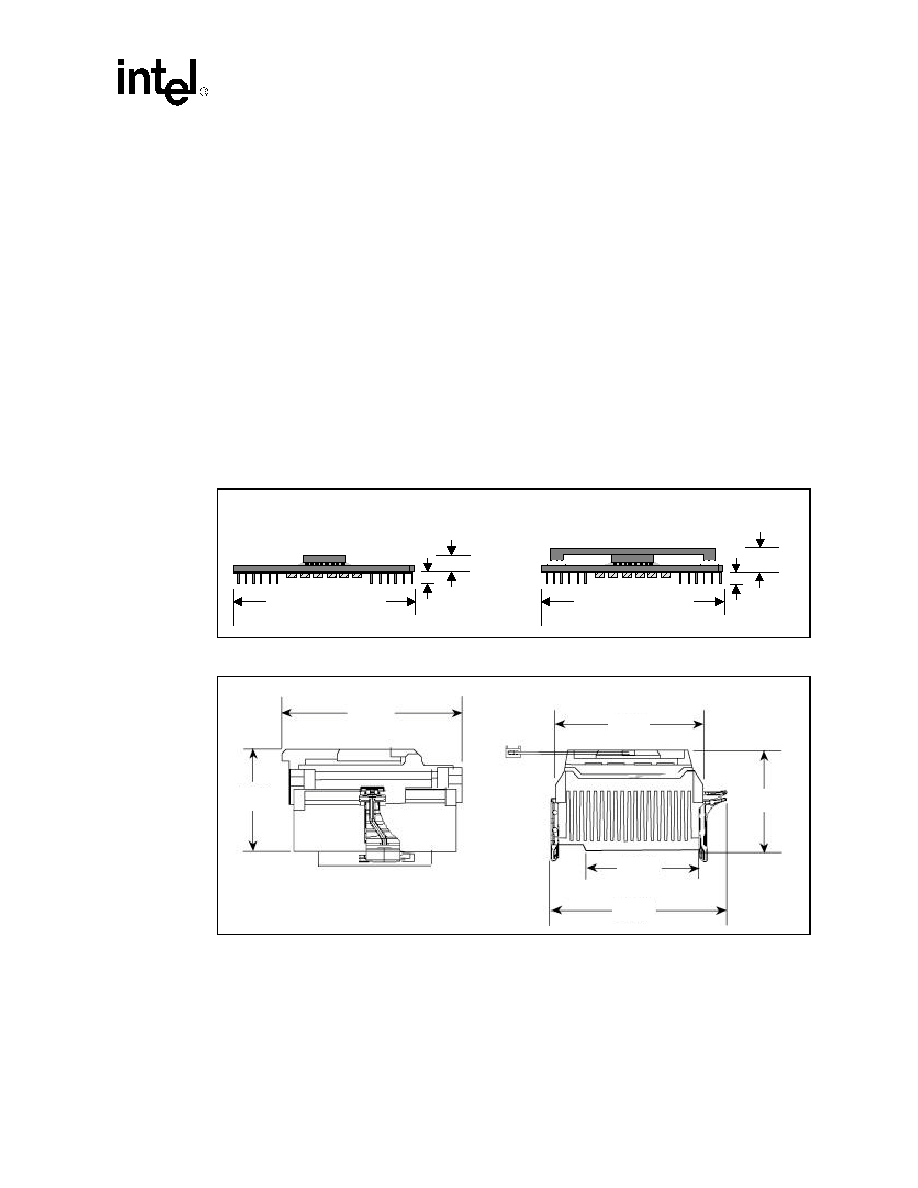
Datasheet
69
Intel
Æ
Celeron
Æ
Processor for PGA370 up to 1.40 GHz on 0.13
µ
Process
The dimensions for the boxed processor with the integrated fan heatsink are shown in
Figure 30
.
All dimensions are in inches.
The processor uses a new technology termed FC-PGA2. The FC-PGA2 package leverages the
previous FC-PGA package technology used on processors based on the 0.18 micron process. The
FC-PGA2 package adds an Integrated Heat Spreader (IHS) to improve heat conduction from the
processor die. This new solution prevent the need for exotic thermal solutions in the higher power
density processors. See section 5.0 of this document for the mechanical specifications of the
PGA370 socket.
Section 5.2 of this document also shows the recommended mechanical keepout zones for the boxed
processor fan heatink assembly.
Figure 24
and
Figure 25
show the REQUIRED keepout
dimensions for the boxed processor thermal solution. The cooling fin orientation on the heatsink
relative to the PGA370 socket is subject to change. Contact your local Intel Sales Representative
for documentation specific to the boxed fan heatsink orientation relative to the PGA370 socket.
Figure 31 shows the changes to the package mechanicals between the FC-PGA and FC-PGA2
designs. Note that the boxed fan heatsinks and associated clips are not compatible with earlier
boxed fan heatsinks for processors based on the 0.18 micron process.
Figure 29. Comparison between FC-PGA and FC-PGA2 package
Figure 30. Side View of Space Requirements for the Boxed Processor
3.2 mm
1.9 mm
49.5 mm square
FC-PGA
FC-PGA2
49.5 mm square
3.2 mm
3.5 mm
1.89
3.11
1.76
3.17
1.89
2.65

70
Datasheet
Intel
Æ
Celeron
Æ
Processor for PGA370 up to 1.40 GHz on 0.13
µ
Process
6.1.2
Boxed Processor Heatsink Weight
The boxed processor thermal cooling solution will not weigh more than 180 grams.
6.2
Thermal Specifications
This section describes the cooling requirements of the thermal cooling solution utilized by the
boxed processor.
6.2.1
Boxed Processor Cooling Requirements
The boxed processor is directly cooled with a fan heatsink. However, meeting the processor's
temperature specification is also a function of the thermal design of the entire system and
ultimately the responsibility of the system integrator. The processor temperature specification is
found in
Section 4.1
of this document. The boxed processor fan heatsink is able to keep the
processor temperature within the specifications (see
Table 30
in
Section 4.1
) in chassis that provide
good thermal management.
For the boxed processor fan heatsink to operate properly, it is critical that the airflow provided to
the fan heatsink is unimpeded. Airflow of the fan heatsink is into the center and out of the sides of
the fan heatsink. Airspace is required around the fan to ensure that the airflow through the fan
heatsink is not blocked. Blocking the airflow to the fan heatsink reduces the cooling efficiency and
decreases fan life.
Figure 32
illustrate an acceptable airspace clearance for the fan heatsink. It is
Table 38. Boxed Processor Fan Heatsink Spatial Dimensions
Dimensions (Inches)
Min
Typ
Max
Units
Fan Heatsink Length
3.14
Inches
Fan Heatsink Height
1.81
Inches
Fan Heatsink Width
2.6
Inches
Fan Heatsink height above motherboard
0.29
0.30
0.33
Inches
Air Keepout Zones from end of Fan Heatsink
0.20
Inches
Figure 31. Dimensions of Mechanical Step Feature in Heatsink Base
0.043
0.472
Units = inches
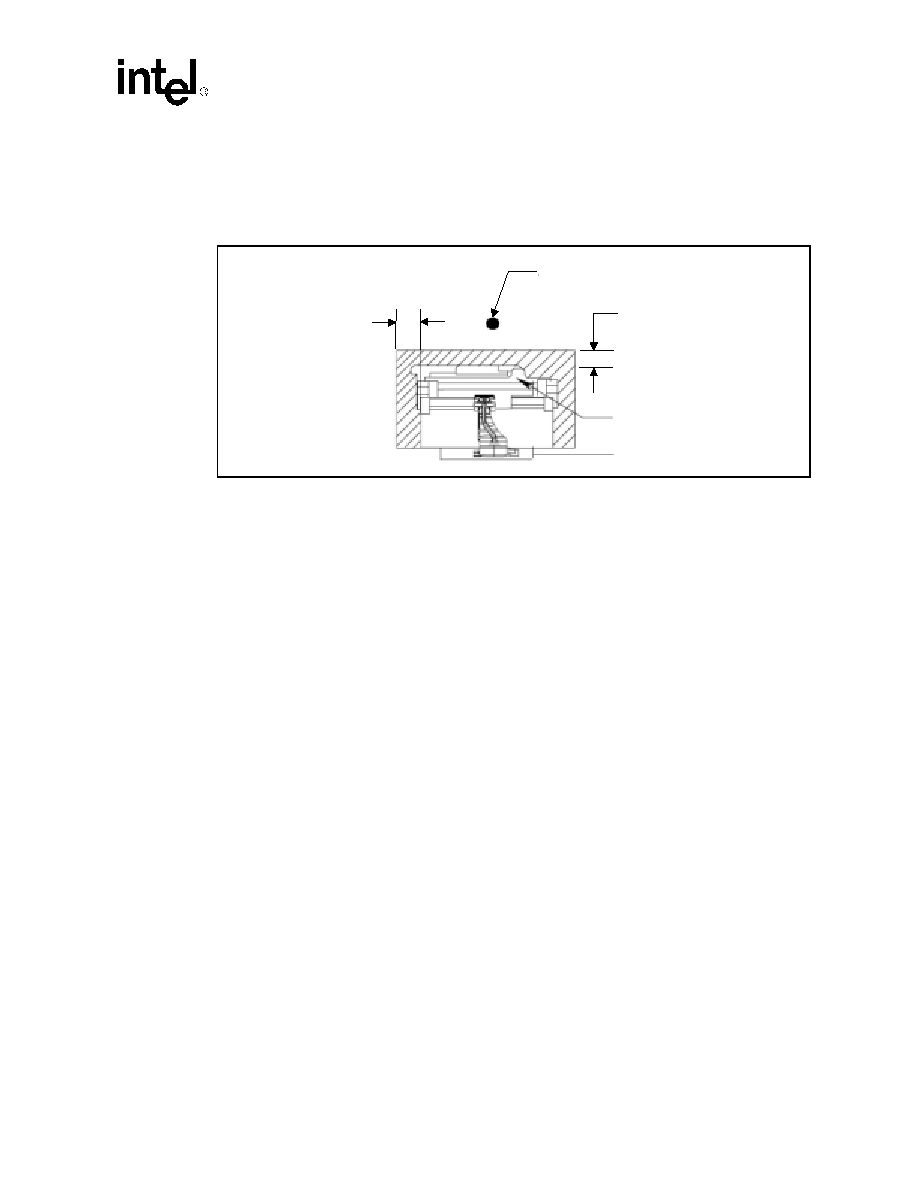
Datasheet
71
Intel
Æ
Celeron
Æ
Processor for PGA370 up to 1.40 GHz on 0.13
µ
Process
also recommended that the air temperature entering the fan be kept below 45 degrees C. Again,
meeting the processor's temperature specification is the responsibility of the system integrator. The
processor temperature specification is found in
Section 4.1
of this document.
6.2.2
Boxed Processor Thermal Cooling Solution Clip
The boxed processor thermal solution requires installation by a system integrator to secure the
thermal cooling solution to the processor after it is installed in the 370-pin socket ZIF socket.
Motherboards designed for use by system integrators should take care to consider the implications
of clip installation and potential scraping of the motherboard PCB underneath the 370-pin socket
attach tabs. Motherboard components should not be placed too close to the 370-pin socket attach
tabs in a way that interferes with the installation of the boxed processor thermal cooling solution
Figure 24
and
Figure 25
show the REQUIRED keepout dimensions for the boxed processor
thermal solution.
6.3
Electrical Requirements for the Boxed Processor
6.3.1
Electrical Requirements
The boxed processor's fan heatsink requires a +12 V power supply. A fan power cable is attached
to the fan and will draw power from a power header on the motherboard. The power cable
connector and pinout are shown in
Figure 33
. Motherboards must provide a matched power header
to support the boxed processor.
Table 38
contains specifications for the input and output signals at
the fan heatsink connector. The fan heatsink outputs a SENSE signal (an open-collector output)
that pulses at a rate of two pulses per fan revolution. A motherboard pull-up resistor provides VOH
to match the motherboard-mounted fan speed monitor requirements, if applicable. Use of the
SENSE signal is optional. If the SENSE signal is not used, pin 3 of the connector should be tied to
GND.
The power header on the baseboard must be positioned to allow the fan heatsink power cable to
reach it. The power header identification and location should be documented in the motherboard
documentation or on the motherboard.
Figure 34
shows the recommended location of the fan
power connector relative to the PGA370 socket. The motherboard power header should be
positioned within 4.00 inches (lateral) of the fan power connector for the FC-PGA2 package.
Figure 32. Thermal Airspace Requirement for all Boxed Processor Fan Heatsinks in the
PGA370 Socket
Measure ambient temperature
0.3 inches above center of fan inlet
Fan Heatsink
0.20 inches
min. air space
Processor PGA-370
Socket
0.20 inches min.
air space
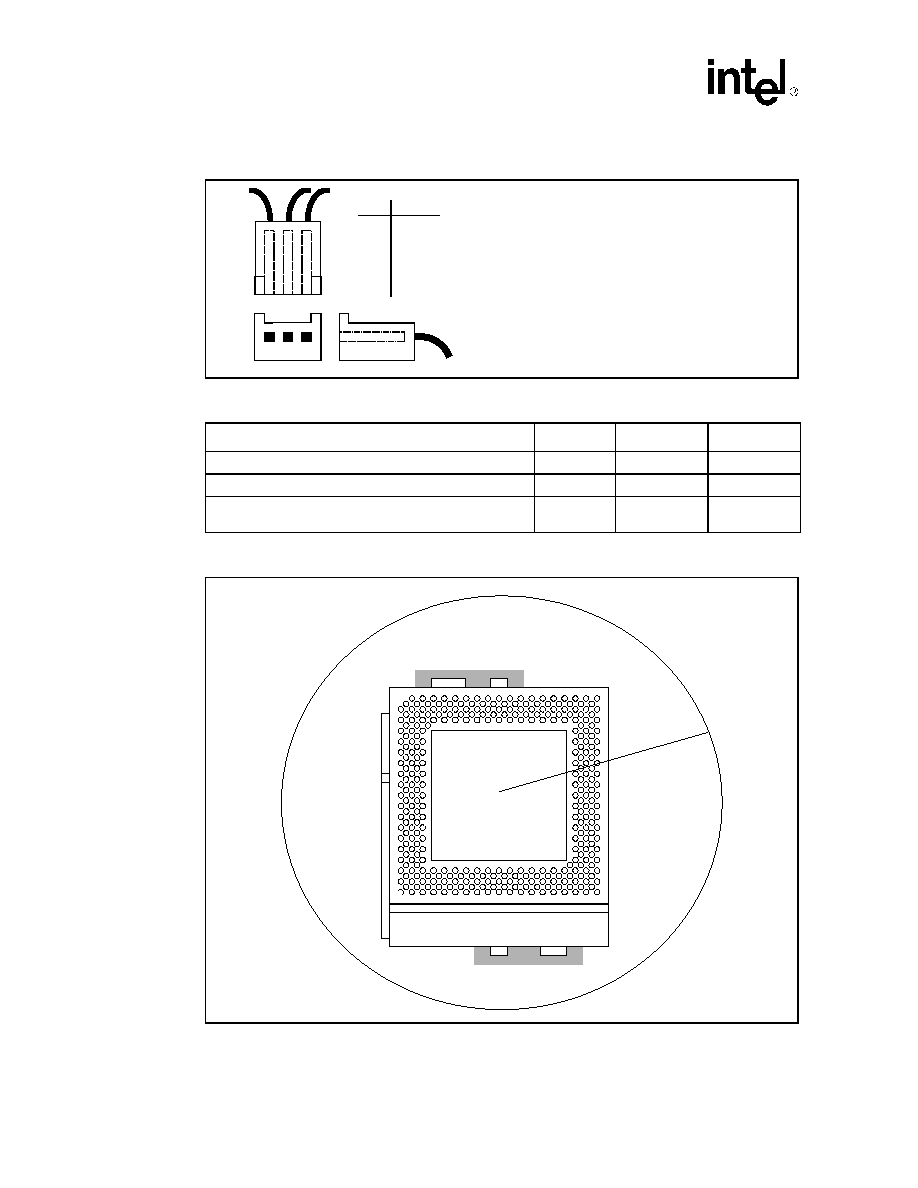
72
Datasheet
Intel
Æ
Celeron
Æ
Processor for PGA370 up to 1.40 GHz on 0.13
µ
Process
Figure 33. Boxed Processor Fan Heatsink Power Cable Connector Description
Table 39. Fan Heatsink Power and Signal Specifications
Description
Min
Typ
Max
+12 V: 12 volt fan power supply
10.8 V
12 V
13.2 V
IC: Fan current draw
100 mA
SENSE: SENSE frequency (motherboard should pull this
pin up to appropriate V
CC
with resistor)
2 pulses per
fan revolution
Figure 34. Motherboard Power Header Placement Relative to the Boxed Processor
Pin
Signal
Straight square pin, 3-pin terminal housing with
polarizing ribs and friction locking ramp.
0.100" pin pitch, 0.025" square pin width.
Waldom/Molex P/N 22-01-3037 or equivalent.
Match with straight pin, friction lock header on motherboard
Waldom/Molex P/N 22-23-2031, AMP P/N 640456-3,
or equivalent.
1
2
3
GND
+12V
SENSE
1
2
3
0.10"
Socket 7
0.10"
R = 4.00"
PGA370

Datasheet
73
Intel
Æ
Celeron
Æ
Processor for PGA370 up to 1.40 GHz on 0.13
µ
Process
7.0
Processor Signal Description
This section provides an alphabetical listing of all the processor signals. The tables at the end of
this section summarize the signals by direction: output, input, and I/O.
7.1
Alphabetical Signals Reference
Table 40. Signal Description (Sheet 1 of 8)
Name
Type
Description
A20M#
I
If the A20M# (Address-20 Mask) input signal is asserted, the processor masks
physical address bit 20 (A20#) before looking up a line in any internal cache and
before driving a read/write transaction on the bus. Asserting A20M# emulates the
8086 processor's address wrap-around at the 1 MB boundary. Assertion of A20M#
is only supported in real mode.
A20M# is an asynchronous signal. However, to ensure recognition of this signal
following an I/O write instruction, it must be valid along with the TRDY# assertion of
the corresponding I/O Write bus transaction.
A[35:3]#
I/O
The A[35:3]# (Address) signals define a 2
36
-byte physical memory address space.
When ADS# is active, these pins transmit the address of a transaction; when ADS#
is inactive, these pins transmit transaction type information. These signals must
connect the appropriate pins of all agents on the processor system bus. The
A[35:24]# signals are parity-protected by the AP1# parity signal, and the A[23:3]#
signals are parity-protected by the AP0# parity signal.
On the active-to-inactive transition of RESET#, the processors sample the A[35:3]#
pins to determine their power-on configuration. See the Intel
Æ
Pentium
Æ
II
Processor Developer's Manual
for details.
ADS#
I/O
The ADS# (Address Strobe) signal is asserted to indicate the validity of the
transaction address on the A[35:3]# pins. All bus agents observe the ADS#
activation to begin parity checking, protocol checking, address decode, internal
snoop, or deferred reply ID match operations associated with the new transaction.
This signal must connect the appropriate pins on all processor system bus agents.
AERR#
I/O
The AERR# (Address Parity Error) signal is observed and driven by all processor
system bus agents, and if used, must connect the appropriate pins on all processor
system bus agents. AERR# observation is optionally enabled during power-on
configuration; if enabled, a valid assertion of AERR# aborts the current transaction.
If AERR# observation is disabled during power-on configuration, a central agent
may handle an assertion of AERR# as appropriate to the error handling architecture
of the system.
AP[1:0]#
I/O
The AP[1:0]# (Address Parity) signals are driven by the request initiator along with
ADS#, A[35:3]#, REQ[4:0]#, and RP#. AP1# covers A[35:24]#, and AP0# covers
A[23:3]#. A correct parity signal is high if an even number of covered signals are
low and low if an odd number of covered signals are low. This allows parity to be
high when all the covered signals are high. AP[1:0]# should connect the appropriate
pins of all processor system bus agents.
BCLK/BCLK#
I
The BCLK (Bus Clock) and BCLK# (for differential clock) signals determines the
bus frequency. All processor system bus agents must receive this signal to drive
their outputs and latch their inputs on the rising edge of BCLK. For differential
clocking, all processor system bus agents must receive this signal to drive their
outputs and latch their inputs on the BCLK and BCLK# crossing point.
All external timing parameters are specified with respect to the BCLK signal.

74
Datasheet
Intel
Æ
Celeron
Æ
Processor for PGA370 up to 1.40 GHz on 0.13
µ
Process
BERR#
I/O
The BERR# (Bus Error) signal is asserted to indicate an unrecoverable error
without a bus protocol violation. It may be driven by all processor system bus
agents, and must connect the appropriate pins of all such agents, if used. However,
the processor does not observe assertions of the BERR# signal.
BERR# assertion conditions are configurable at a system level. Assertion options
are defined by the following options:
∑ Enabled or disabled.
∑ Asserted optionally for internal errors along with IERR#.
∑ Asserted optionally by the request initiator of a bus transaction after it observes
an error.
∑ Asserted by any bus agent when it observes an error in a bus transaction.
BINIT#
I/O
The BINIT# (Bus Initialization) signal may be observed and driven by all processor
system bus agents, and if used must connect the appropriate pins of all such
agents. If the BINIT# driver is enabled during power on configuration, BINIT# is
asserted to signal any bus condition that prevents reliable future information.
If BINIT# observation is enabled during power-on configuration, and BINIT# is
sampled asserted, all bus state machines are reset and any data which was in
transit is lost. All agents reset their rotating ID for bus arbitration to the state after
Reset, and internal count information is lost. The L1 and L2 caches are not
affected.
If BINIT# observation is disabled during power-on configuration, a central agent
may handle an assertion of BINIT# as appropriate to the error handling architecture
of the system.
BNR#
I/O
The BNR# (Block Next Request) signal is used to assert a bus stall by any bus
agent who is unable to accept new bus transactions. During a bus stall, the current
bus owner cannot issue any new transactions.
Since multiple agents might need to request a bus stall at the same time, BNR# is a
wire-OR signal which must connect the appropriate pins of all processor system
bus agents. In order to avoid wire-OR glitches associated with simultaneous edge
transitions driven by multiple drivers, BNR# is activated on specific clock edges and
sampled on specific clock edges.
BP[3:2]#
I/O
The BP[3:2]# (Breakpoint) signals are outputs from the processor that indicate the
status of breakpoints.
BPM[1:0]#
I/O
The BPM[1:0]# (Breakpoint Monitor) signals are breakpoint and performance
monitor signals. They are outputs from the processor which indicate the status of
breakpoints and programmable counters used for monitoring processor
performance.
BPRI#
I
The BPRI# (Bus Priority Request) signal is used to arbitrate for ownership of the
processor system bus. It must connect the appropriate pins of all processor system
bus agents. Observing BPRI# active (as asserted by the priority agent) causes all
other agents to stop issuing new requests, unless such requests are part of an
ongoing locked operation. The priority agent keeps BPRI# asserted until all of its
requests are completed, then releases the bus by deasserting BPRI#.
BR0#
I/O
The BR0# (Bus Request) pins drive the BREQ[0]# signal in the system. During
power-up configuration, the central agent asserts the BR0# bus signal in the
system to assign the symmetric agent ID to the processor. The processor samples
its BR0# pin on the active-to-inactive transition of the RESET# to obtain its
symmetric agent ID. The processor asserts the BR0# pin to request the system
bus. BR0# must be connected to a 10-56
resistor to V
SS
. Refer to the platform
design guide for implementation detail and resistor tolerance.
Table 40. Signal Description (Sheet 2 of 8)
Name
Type
Description

Datasheet
75
Intel
Æ
Celeron
Æ
Processor for PGA370 up to 1.40 GHz on 0.13
µ
Process
BSEL[1:0]
O
The BSEL signals are CMOS signals which are used to select the system bus
frequency. A BSEL[1:0] = `01' selects a 100 MHz system bus frequency. The
frequency is determined by the processor(s), chipset, and frequency synthesizer
capabilities. All system bus agents must operate at the same frequency. The
processor operates at 100 MHz system bus frequency.
These signals must be pulled up to 3.3V power rail with 330
≠ 1 K
resistors and
provided as a frequency selection signal to the clock driver/synthesizer and chipset.
Refer to the platform design guide for implementation detail and resistor tolerance.
CLKREF
I
In Single-ended clock mode the CLKREF input is a filtered 1.25V supply voltage for
the processor PLL. A voltage divider and decoupling solution is provided by the
motherboard. See the design guide for implementation details.
When the processor operates in differential clock mode, this signal becomes
BCLK#.
CPUPRES#
O
The CPUPRES# signal is defined to allow a system design to detect the presence
of a processor in a PGA370 socket. Combined with the VID combination of
VID[25mV,3:0]= 11111 (see
Section 2.6
), a system can determine if a socket is
occupied, and whether a processor core is present. See the table below for states
and values for determining the presence of a device.
D[63:0]#
I/O
The D[63:0]# (Data) signals are the data signals. These signals provide a 64-bit
data path between the processor system bus agents, and must connect the
appropriate pins on all such agents. The data driver asserts DRDY# to indicate a
valid data transfer.
DBSY#
I/O
The DBSY# (Data Bus Busy) signal is asserted by the agent responsible for driving
data on the processor system bus to indicate that the data bus is in use. The data
bus is released after DBSY# is deasserted. This signal must connect the
appropriate pins on all processor system bus agents.
DEFER#
I
The DEFER# signal is asserted by an agent to indicate that a transaction cannot be
guaranteed in-order completion. Assertion of DEFER# is normally the responsibility
of the addressed memory or I/O agent. This signal must connect the appropriate
pins of all processor system bus agents.
DEP[7:0]#
I/O
The DEP[7:0]# (Data Bus ECC Protection) signals provide optional ECC protection
for the data bus. They are driven by the agent responsible for driving D[63:0]#, and
must connect the appropriate pins of all processor system bus agents which use
them. The DEP[7:0]# signals are enabled or disabled for ECC protection during
power on configuration.
DETECT
O
A tri-state (high-impedance) output. Can be used for platforms that need to
differentiate the previous generation Intel Celeron processors for the PGA370
socket that support V
TT
= 1.50 V from the new processors (AF36=VSS) that
support V
TT
= 1.25 V . The output on this signal is stable when V
TT
is stable. Refer
to the appropriate Platform Design Guide for implementation details.
DRDY#
I/O
The DRDY# (Data Ready) signal is asserted by the data driver on each data
transfer, indicating valid data on the data bus. In a multi-cycle data transfer, DRDY#
may be deasserted to insert idle clocks. This signal must connect the appropriate
pins of all processor system bus agents.
Table 40. Signal Description (Sheet 3 of 8)
Name
Type
Description
PGA370 Socket Occupation Truth Table
Signal
Value
Status
CPUPRES#
VID[25mV,3:0]
0
Anything other
than `11111'
Processor core installed in the PGA370
socket.
CPUPRES#
VID[25mV,3:0]
1
Any value
PGA370 socket not occupied.

76
Datasheet
Intel
Æ
Celeron
Æ
Processor for PGA370 up to 1.40 GHz on 0.13
µ
Process
DYN_OE
I
The DYN_OE allows the BSEL and VID signals to be driven out from the processor.
When this signal is low (a condition that will occur if the processor is installed in a
non-supported platform), the VID and BSEL signals will be tri-stated and the
platform pull-up resistors will set the VID and BSEL to all 1s which is a safe setting.
This signal must be connected to a 1 k
resistor to V
TT
. Refer to the platform
design guide for implementation detail and resistor tolerance.
FERR#
O
The FERR# (Floating-point Error) signal is asserted when the processor detects an
unmasked floating-point error. FERR# is similar to the ERROR# signal on the
Intel 387 coprocessor, and is included for compatibility with systems using
MS-DOS*-type floating-point error reporting.
FLUSH#
I
When the FLUSH# input signal is asserted, processors write back all data in the
Modified state from their internal caches and invalidate all internal cache lines. At
the completion of this operation, the processor issues a Flush Acknowledge
transaction. The processor does not cache any new data while the FLUSH# signal
remains asserted.
FLUSH# is an asynchronous signal. However, to ensure recognition of this signal
following an I/O write instruction, it must be valid along with the TRDY# assertion of
the corresponding I/O Write bus transaction.
On the active-to-inactive transition of RESET#, each processor samples FLUSH#
to determine its power-on configuration. See the P6 Family of Processors
Hardware Developer's Manual
for details.
This signal must be connected to a 150
resistor to V
CCCMOS1.5
. Refer to the
platform design guide for implementation detail and resistor tolerance.
HIT#
HITM#
I/O
I/O
The HIT# (Snoop Hit) and HITM# (Hit Modified) signals convey transaction snoop
operation results, and must connect the appropriate pins of all processor system
bus agents. Any such agent may assert both HIT# and HITM# together to indicate
that it requires a snoop stall, which can be continued by reasserting HIT# and
HITM# together.
IERR#
O
The IERR# (Internal Error) signal is asserted by a processor as the result of an
internal error. Assertion of IERR# is usually accompanied by a SHUTDOWN
transaction on the processor system bus. This transaction may optionally be
converted to an external error signal (e.g., NMI) by system core logic. The
processor will keep IERR# asserted until the assertion of RESET#, BINIT#, or
INIT#.
IGNNE#
I
The IGNNE# (Ignore Numeric Error) signal is asserted to force the processor to
ignore a numeric error and continue to execute noncontrol floating-point
instructions. If IGNNE# is deasserted, the processor generates an exception on a
noncontrol floating-point instruction if a previous floating-point instruction caused an
error. IGNNE# has no effect when the NE bit in control register 0 is set.
IGNNE# is an asynchronous signal. However, to ensure recognition of this signal
following an I/O write instruction, it must be valid along with the TRDY# assertion of
the corresponding I/O Write bus transaction.
INIT#
I
The INIT# (Initialization) signal, when asserted, resets integer registers inside all
processors without affecting their internal (L1 or L2) caches or floating-point
registers. Each processor then begins execution at the power-on Reset vector
configured during power-on configuration. The processor continues to handle
snoop requests during INIT# assertion. INIT# is an asynchronous signal and must
connect the appropriate pins of all processor system bus agents.
If INIT# is sampled active on the active to inactive transition of RESET#, then the
processor executes its Built-in Self-Test (BIST).
KEY
I
Can be used to prevent legacy processors from booting in incompatible platforms.
Legacy processors use this pin as a RESET and should be tied to ground for a 0.13
micron process processor only platform but for flexible platform implementations
this pin should be a No Connect. Please refer to the appropriate Platform Design
Guide for implementation details.
Table 40. Signal Description (Sheet 4 of 8)
Name
Type
Description

Datasheet
77
Intel
Æ
Celeron
Æ
Processor for PGA370 up to 1.40 GHz on 0.13
µ
Process
LINT[1:0]
I
The LINT[1:0] (Local APIC Interrupt) signals must connect the appropriate pins of
all APIC Bus agents, including all processors and the core logic or I/O APIC
component. When the APIC is disabled, the LINT0 signal becomes INTR, a
maskable interrupt request signal, and LINT1 becomes NMI, a nonmaskable
interrupt. INTR and NMI are backward compatible with the signals of those names
on the Intel
Pentium processor. Both signals are asynchronous.
Both of these signals must be software configured via BIOS programming of the
APIC register space to be used either as NMI/INTR or LINT[1:0]. Because the APIC
is enabled by default after Reset, operation of these pins as LINT[1:0] is the default
configuration.
LOCK#
I/O
The LOCK# signal indicates to the system that a transaction must occur atomically.
This signal must connect the appropriate pins of all processor system bus agents.
For a locked sequence of transactions, LOCK# is asserted from the beginning of
the first transaction end of the last transaction.
When the priority agent asserts BPRI# to arbitrate for ownership of the processor
system bus, it will wait until it observes LOCK# deasserted. This enables symmetric
agents to retain ownership of the processor system bus throughout the bus locked
operation and ensure the atomicity of lock.
NCHCTRL I
The NCHCTRL input signal provides AGTL pull-down strength control. The
processor samples this input to determine the N-channel device strength for pull-
down when it is the driving agent. This signal must be connected to a 14ohm
resistor to V
TT
. Refer to the platform design guide for implementation detail and
resistor tolerance.
PICCLK
I
The PICCLK (APIC Clock) signal is an input clock to the processor and core logic or
I/O APIC which is required for operation of all processors, core logic, and I/O APIC
components on the APIC bus.
PICD[1:0]
I/O
The PICD[1:0] (APIC Data) signals are used for bidirectional serial message
passing on the APIC bus, and must connect the appropriate pins of all processors
and core logic or I/O APIC components on the APIC bus.
PLL1, PLL2
I
The processor has an internal analog PLL clock generator that requires a quiet
power supply. PLL1 and PLL2 are inputs to this PLL and must be connected to
V
CC
CORE
through a low pass filter that minimizes jitter. See the platform design
guide for implementation details.
PRDY#
O
The PRDY (Probe Ready) signal is a processor output used by debug tools to
determine processor debug readiness.
PREQ#
I
The PREQ# (Probe Request) signal is used by debug tools to request debug
operation of the processors.
PWRGOOD
I
The PWRGOOD (Power Good) signal is processor input. The processor requires
this signal to be a clean indication that the clocks and power supplies (V
CC
CORE
,
etc.) are stable and within their specifications. Clean implies that the signal will
remain low (capable of sinking leakage current), without glitches, from the time that
the power supplies are turned on until they come within specification. The signal
must then transition monotonically to a high state. PWRGOOD can be driven
inactive at any time, but clocks and power must again be stable before a
subsequent rising edge of PWRGOOD. It must also meet the minimum pulse width
specification in
Table 18
, and be followed by a 1 ms RESET# pulse.
The PWRGOOD signal must be supplied to the processor; it is used to protect
internal circuits against voltage sequencing issues. It should be driven high
throughout boundary scan operation.
REQ[4:0]#
I/O
The REQ[4:0]# (Request Command) signals must connect the appropriate pins of
all processor system bus agents. They are asserted by the current bus owner over
two clock cycles to define the currently active transaction type.
Table 40. Signal Description (Sheet 5 of 8)
Name
Type
Description

78
Datasheet
Intel
Æ
Celeron
Æ
Processor for PGA370 up to 1.40 GHz on 0.13
µ
Process
RESET#
I
Asserting the RESET# signal resets all processors to known states and invalidates
their L1 and L2 caches without writing back any of their contents. For a power-on
Reset, RESET# must stay active for at least one millisecond after V
CC
CORE
and
CLK have reached their proper specifications. On observing active RESET#, all
processor system bus agents will deassert their outputs within two clocks.
A number of bus signals are sampled at the active-to-inactive transition of RESET#
for power-on configuration. These configuration options are described in the
P6 Family of Processors Hardware Developer's Manual
for details.
The processor may have its outputs tristated via power-on configuration. Otherwise,
if INIT# is sampled active during the active-to-inactive transition of RESET#, the
processor will execute its Built-in Self-Test (BIST). Whether or not BIST is
executed, the processor will begin program execution at the power on Reset vector
(default 0_FFFF_FFF0h). RESET# must connect the appropriate pins of all
processor system bus agents.
RESET# is the only AGTL signal which does not have on-die termination.
Therefore, it is necessary to place a discrete 56
resistor to V
TT
. Refer to the
platform design guide for implementation detail and resistor tolerance.
RESET2#
I
RESET2# pin is provided to differentiate the processor from the previous
generation Intel
Celeron processor. The 0.13 micron process based processor
does not use the RESET2# pin. Refer to the platform design guide for the proper
connections of this signal.
RP#
I/O
The RP# (Request Parity) signal is driven by the request initiator, and provides
parity protection on ADS# and REQ[4:0]#. It must connect the appropriate pins of
all processor system bus agents.
A correct parity signal is high if an even number of covered signals are low and low
if an odd number of covered signals are low. This definition allows parity to be high
when all covered signals are high.
RS[2:0]#
I/O
The RS[2:0]# (Response Status) signals are driven by the response agent (the
agent responsible for completion of the current transaction), and must connect the
appropriate pins of all processor system bus agents.
RSP#
I
The RSP# (Response Parity) signal is driven by the response agent (the agent
responsible for completion of the current transaction) during assertion of RS[2:0]#,
the signals for which RSP# provides parity protection. It must connect the
appropriate pins of all processor system bus agents.
A correct parity signal is high if an even number of covered signals are low and low
if an odd number of covered signals are low. While RS[2:0]# = 000, RSP# is also
high, since this indicates it is not being driven by any agent guaranteeing correct
parity.
RTTCTRL
I
The RTTCTRL input signal provides AGTL termination control. The processor
samples this input to set the termination resistance value for the on-die AGTL
termination. This signal must be connected to a 56
resistor to V
SS
on a uni-
processor platform or a 68
resistor to V
SS
on a dual-processor platform. Refer to
the platform design guide for implementation detail and resistor tolerance.
SLEWCTRL
I
The SLEWCTRL input signal provides AGTL slew rate control. The processor
samples this input to determine the slew rate for AGTL signals when it is the driving
agent. This signal must be connected to a 110
resistor to V
SS
. Refer to the
platform design guide for implementation detail and resistor tolerance.
SLP#
I
The SLP# (Sleep) signal, when asserted in Stop-Grant state, causes processors to
enter the Sleep state. During Sleep state, the processor stops providing internal
clock signals to all units, leaving only the Phase-Locked Loop (PLL) still operating.
Processors in this state will not recognize snoops or interrupts. The processor will
recognize only assertions of the SLP#, STPCLK#, and RESET# signals while in
Sleep state. If SLP# is deasserted, the processor exits Sleep state and returns to
Stop-Grant state, restarting its internal clock signals to the bus and APIC processor
core units.
Table 40. Signal Description (Sheet 6 of 8)
Name
Type
Description

Datasheet
79
Intel
Æ
Celeron
Æ
Processor for PGA370 up to 1.40 GHz on 0.13
µ
Process
SMI#
I
The SMI# (System Management Interrupt) signal is asserted asynchronously by
system logic. On accepting a System Management Interrupt, processors save the
current state and enter System Management Mode (SMM). An SMI Acknowledge
transaction is issued, and the processor begins program execution from the SMM
handler.
STPCLK#
I
The STPCLK# (Stop Clock) signal, when asserted, causes processors to enter a
low power state. The processor stops providing internal clock signals to all
processor core units except the bus and APIC units. The processor continues to
snoop bus transactions and latch interrupts. When STPCLK# is deasserted, the
processor restarts its internal clock to all units, services pending interrupts, and
resumes execution. The assertion of STPCLK# has no effect on the bus clock;
STPCLK# is an asynchronous input.
TCK
I
The TCK (Test Clock) signal provides the clock input for the processor Test Bus
(also known as the Test Access Port).
TDI
I
The TDI (Test Data In) signal transfers serial test data into the processor. TDI
provides the serial input needed for JTAG specification support.
TDO
O
The TDO (Test Data Out) signal transfers serial test data out of the processor. TDO
provides the serial output needed for JTAG specification support.
THERMDN
O
Thermal Diode Cathode. This signal is used to calculate core (junction)
temperature. See
Section 4.1
.
THERMDP
I
Thermal Diode Anode. This signal is used to calculate core (junction) temperature.
See
Section 4.1
.
THERMTRIP#
O
The processor protects itself from catastrophic overheating by use of an internal
thermal sensor. This sensor is set well above the normal operating temperature to
ensure that there are no false trips. The processor will stop all execution when the
junction temperature exceeds approximately 135 ∞C. This is signaled to the system
by the THERMTRIP# (Thermal Trip) pin. Once activated, the signal remains
latched, and the processor stopped, until RESET# goes active or core power is
removed. There is no hysteresis built into the thermal sensor itself; as long as the
die temperature drops below the trip level, a RESET# pulse will reset the processor
and execution will continue. If the temperature has not dropped below the trip level,
the processor will continue to drive THERMTRIP# and remain stopped.
In the event the processor drives the THERMTRIP# signal active during valid
operation, both the V
CC
and V
TT
supplies to the processor must be turned off to
prevent thermal runaway of the processor. Valid operation refers to the operating
conditions where the THERMTRIP# signal is guaranteed valid. The time required
from THERMTRIP# asserted to V
CC
rail at 1/2 nominal is 5 seconds and
THERMTRIP# asserted to V
TT
rail at 1/2 nominal is 5 seconds. Once Vcc and V
TT
supplies are turned off the THERMTRIP# signal will be deactivated. System logic
should ensure no "unsafe" power cycling occurs due to this deassertion.
TMS
I
The TMS (Test Mode Select) signal is a JTAG specification support signal used by
debug tools.
TRDY#
I/O
The TRDY# (Target Ready) signal is asserted by the target to indicate that it is
ready to receive a write or implicit writeback data transfer. TRDY# must connect the
appropriate pins of all processor system bus agents.
TRST#
I
The TRST# (Test Reset) signal resets the Test Access Port (TAP) logic. TRST#
must be driven low during power on Reset.
V
CMOS_REF
I
The V
CMOS_REF
input pin supplies non-AGTL reference voltage, which is typically
2/3 of V
CMOS
. V
CMOS_REF
is used by the non-AGTL receivers to determine if a
signal is a logical 0 or a logical 1.
The Thevenin equivalent impedance of the V
CMOS_REF
generation circuits must be
less than 0.5 k
/1 k
(i.e., top resistor 500
, bottom resistor 1 k
).
Table 40. Signal Description (Sheet 7 of 8)
Name
Type
Description

80
Datasheet
Intel
Æ
Celeron
Æ
Processor for PGA370 up to 1.40 GHz on 0.13
µ
Process
7.2
Signal Summaries
Table 41
through
Table 44
list attributes of the processor output, input, and I/O signals.
VID [3:0,25mV]
O
The VID[3:0, 25 mV] (Voltage ID) pins can be used to support automatic selection
of power supply voltages. These pins are CMOS signals that must be pulled up to
3.3 V power rail with 1 K
resistors. The VID pins are needed to cleanly support
voltage specification variations on processors. See
Table 3
for definitions of these
pins. The power supply must supply the voltage that is requested by these pins, or
disable itself.
V
REF
I
The V
REF
input pins supply the AGTL reference voltage, which is typically 2/3 of
V
TT
. V
REF
is used by the AGTL receivers to determine if a signal is a logical 0 or a
logical 1.
VTT_PWRGD
I
The VTT_PWRGD signal informs the system that the VID/BSEL signals are in their
correct logic state. During Power-up, the VID signals will be in an indeterminate
state for a small period of time. The voltage regulator or the VRM should not sample
and/or latch the VID signals until the VTT_PWRGD signal is asserted. The
assertion of the VTT_PWRGD signal indicates the VID signals are stable and are
driven to the final state by the processor. Refer to
Figure 6
for power-up timing
sequence for the VTT_PWRGD and the VID signals
Table 40. Signal Description (Sheet 8 of 8)
Name
Type
Description
Table 41. Output Signals
Name
Active Level
Clock
Signal Group
BSEL[1:0]
High
Asynch
Power/Other
CPUPRES#
Low
Asynch
Power/Other
DETECT
High
Asynch
Power/Other
FERR#
Low
Asynch
CMOS Output
IERR#
Low
Asynch
CMOS Output
PRDY#
Low
BCLK
AGTL Output
TDO
High
TCK
TAP Output
THERMTRIP#
Low
Asynch
CMOS Output
VID[3:0, 25mV]
N/A
Asynch
Power/Other
Table 42. Input Signals (Sheet 1 of 2)
Name
Active Level
Clock
Signal Group
Qualified
A20M#
Low
Asynch
CMOS Input
Always
1
BCLK
High
--
System Bus Clock
Always
BPRI#
Low
BCLK
AGTL Input
Always
DEFER#
Low
BCLK
AGTL Input
Always
FLUSH#
Low
Asynch
CMOS Input
Always
1
IGNNE#
Low
Asynch
CMOS Input
Always
1
INIT#
Low
Asynch
CMOS Input
Always
1
INTR
High
Asynch
CMOS Input
APIC disabled mode
KEY
N/A
Asynch
Power/Other

Datasheet
81
Intel
Æ
Celeron
Æ
Processor for PGA370 up to 1.40 GHz on 0.13
µ
Process
NOTE:
Synchronous assertion with active TDRY# ensures synchronization.
LINT[1:0]
High
Asynch
CMOS Input
APIC enabled mode
NMI
High
Asynch
CMOS Input
APIC disabled mode
NCHCTRL
N/A
Asynch
Power/Other
PICCLK
High
--
APIC Clock
Always
PREQ#
Low
Asynch
CMOS Input
Always
PWRGOOD
High
Asynch
CMOS Input
Always
RESET#
Low
BCLK
AGTL Input
Always
RESET2#
Low
BCLK
AGTL Input
RSP#
Low
BCLK
AGTL Input
Always
RTTCTRL
N/A
Asynch
Power/Other
SLEWCTRL
N/A
Asynch
Power/Other
SLP#
Low
Asynch
CMOS Input
During Stop-Grant state
SMI#
Low
Asynch
CMOS Input
STPCLK#
Low
Asynch
CMOS Input
TCK
High
--
TAP Input
TDI
High
TCK
TAP Input
TMS
High
TCK
TAP Input
TRST#
Low
Asynch
TAP Input
VTT_PWRGD
High
Asynch
Power/Other
Table 42. Input Signals (Sheet 2 of 2)
Name
Active Level
Clock
Signal Group
Qualified
Table 43. Input/Output Signals (Single Driver)
Name
Active Level
Clock
Signal Group
Qualified
A[35:3]#
Low
BCLK
AGTL I/O
ADS#, ADS#+1
ADS#
Low
BCLK
AGTL I/O
Always
AP[1:0]#
Low
BCLK
AGTL I/O
ADS#, ADS#+1
BP[3:2]#
Low
BCLK
AGTL I/O
Always
BPM[1:0]#
Low
BCLK
AGTL I/O
Always
BR0#
Low
BCLK
AGTL I/O
Always
D[63:0]#
Low
BCLK
AGTL I/O
DRDY#
DBSY#
Low
BCLK
AGTL I/O
Always
DEP[7:0]#
Low
BCLK
AGTL I/O
DRDY#
DRDY#
Low
BCLK
AGTL I/O
Always
LOCK#
Low
BCLK
AGTL I/O
Always
REQ[4:0]#
Low
BCLK
AGTL I/O
ADS#, ADS#+1
RP#
Low
BCLK
AGTL I/O
ADS#, ADS#+1
RS[2:0]#
Low
BCLK
AGTL Input
Always
TRDY#
Low
BCLK
AGTL Input

82
Datasheet
Intel
Æ
Celeron
Æ
Processor for PGA370 up to 1.40 GHz on 0.13
µ
Process
Table 44. Input/Output Signals (Multiple Driver)
Name
Active Level
Clock
Signal Group
Qualified
AERR#
Low
BCLK
AGTL I/O
ADS#+3
BERR#
Low
BCLK
AGTL I/O
Always
BINIT#
Low
BCLK
AGTL I/O
Always
BNR#
Low
BCLK
AGTL I/O
Always
HIT#
Low
BCLK
AGTL I/O
Always
HITM#
Low
BCLK
AGTL I/O
Always
PICD[1:0]
High
PICCLK
APIC I/O
Always

















































































